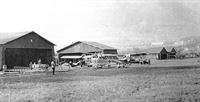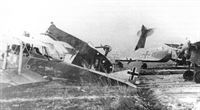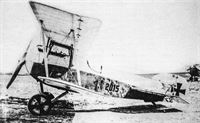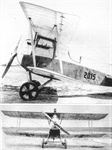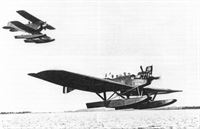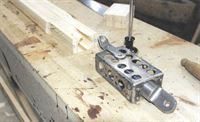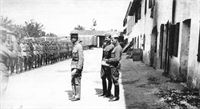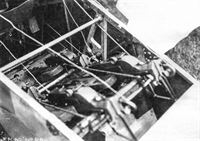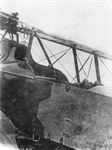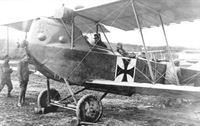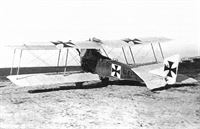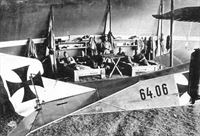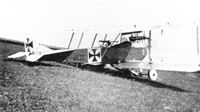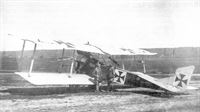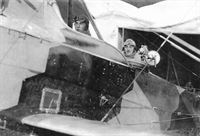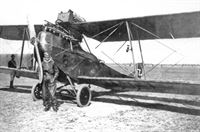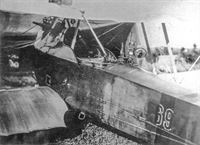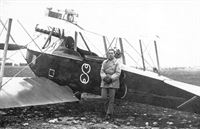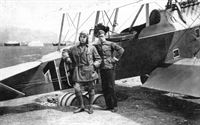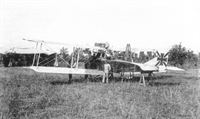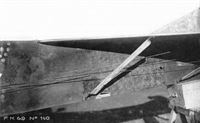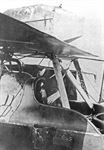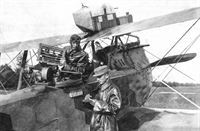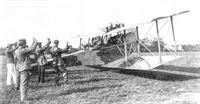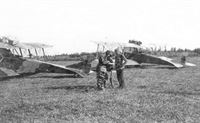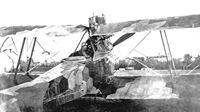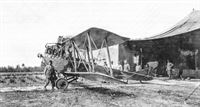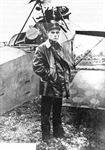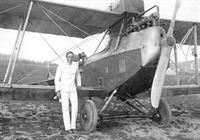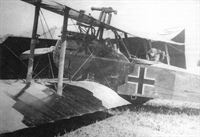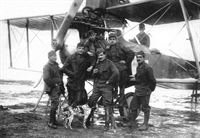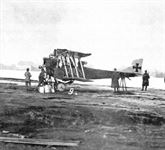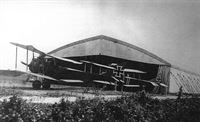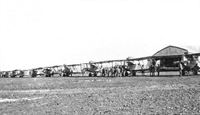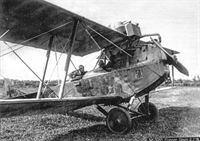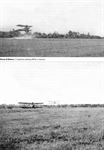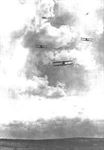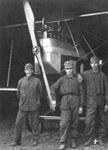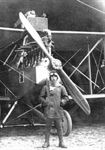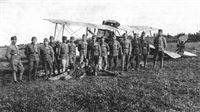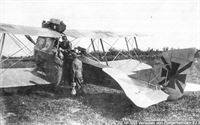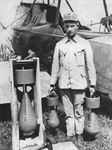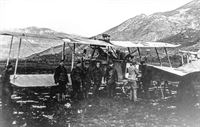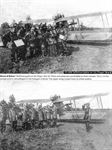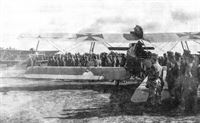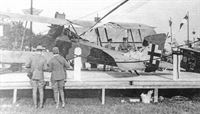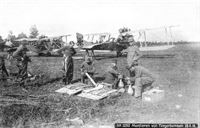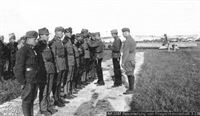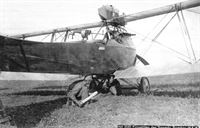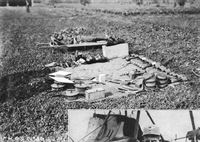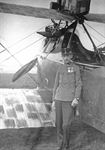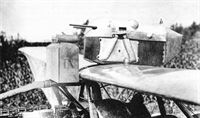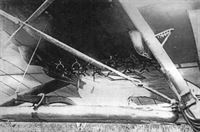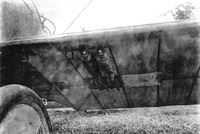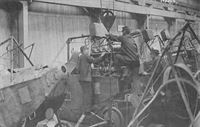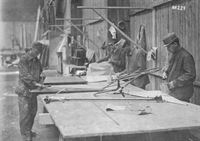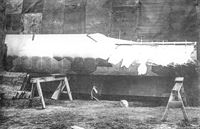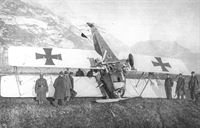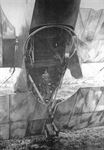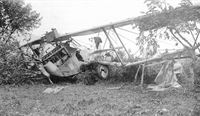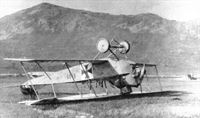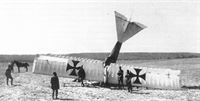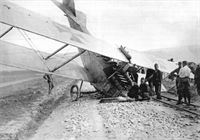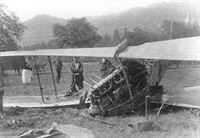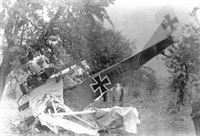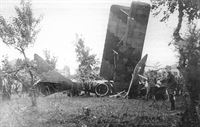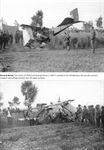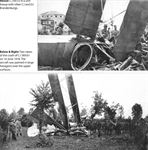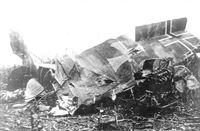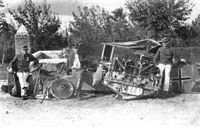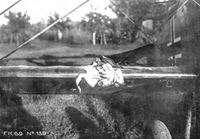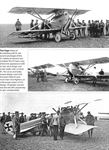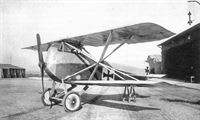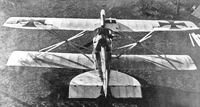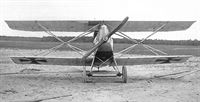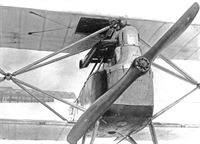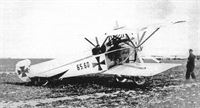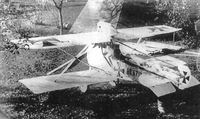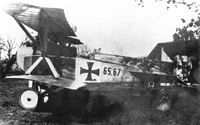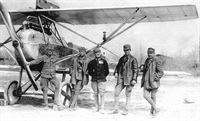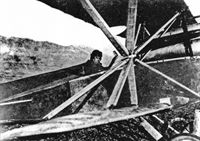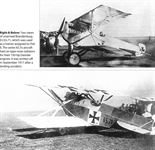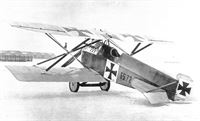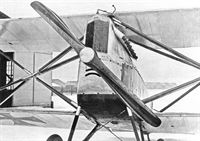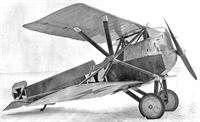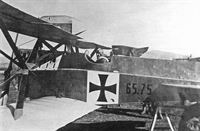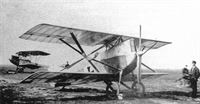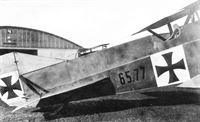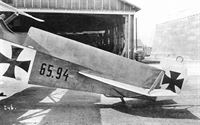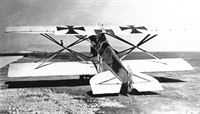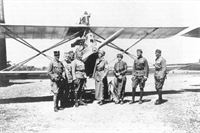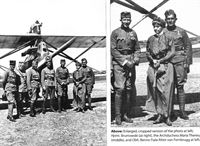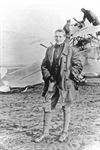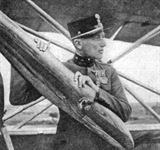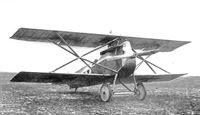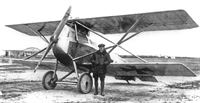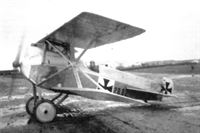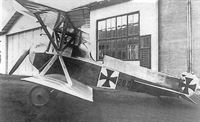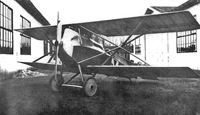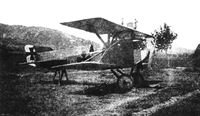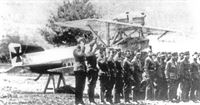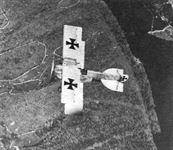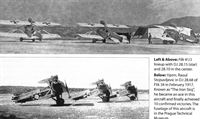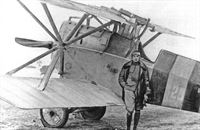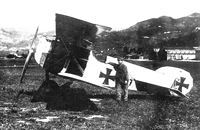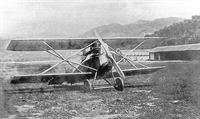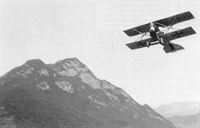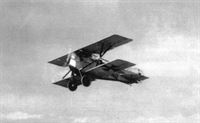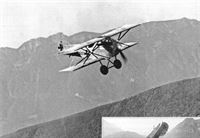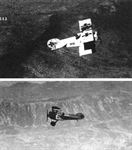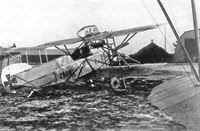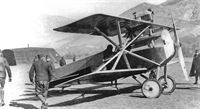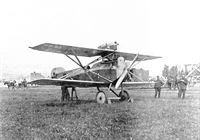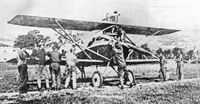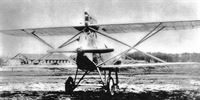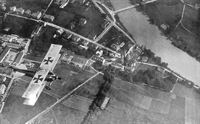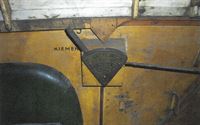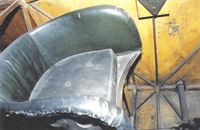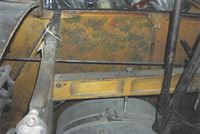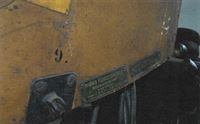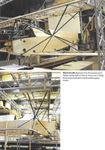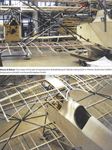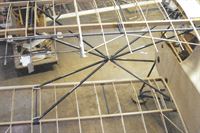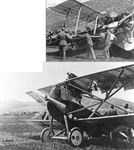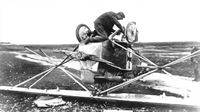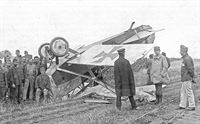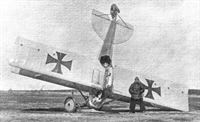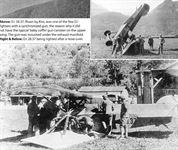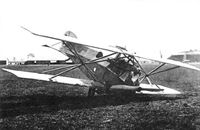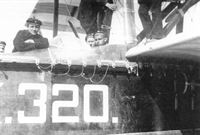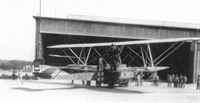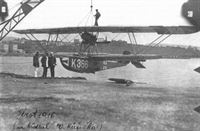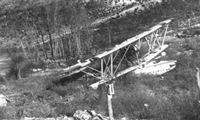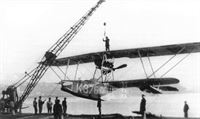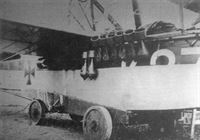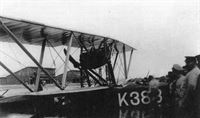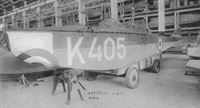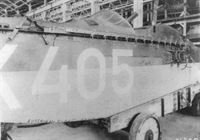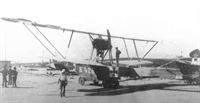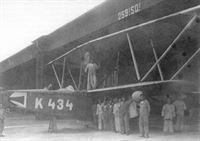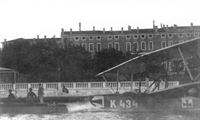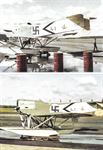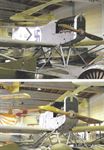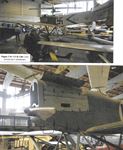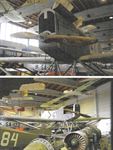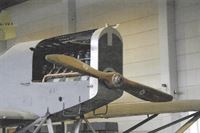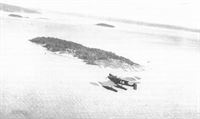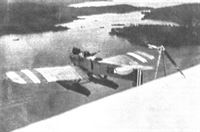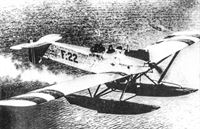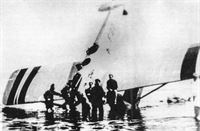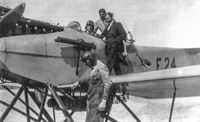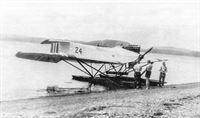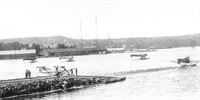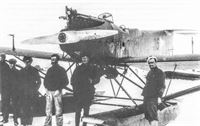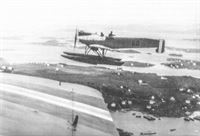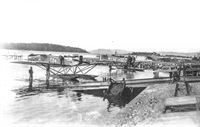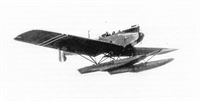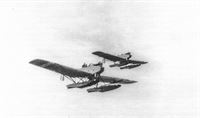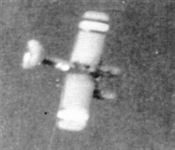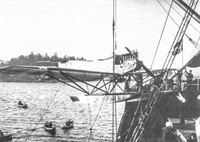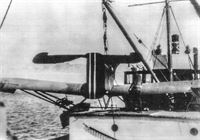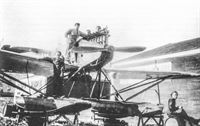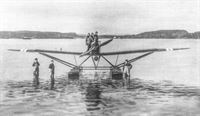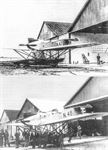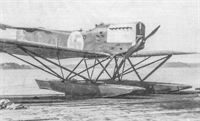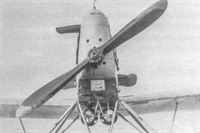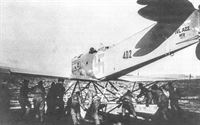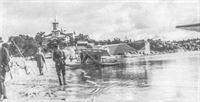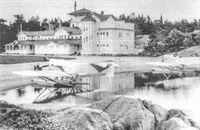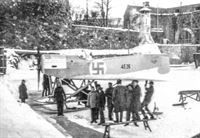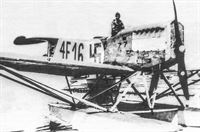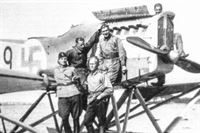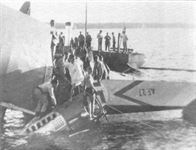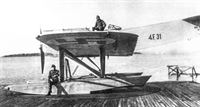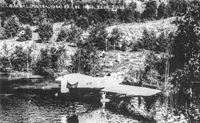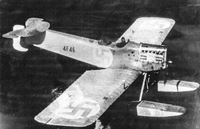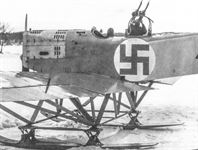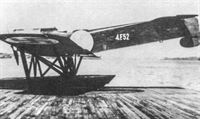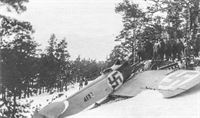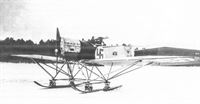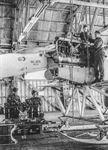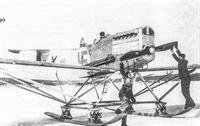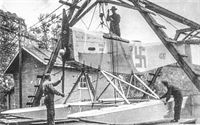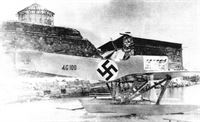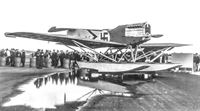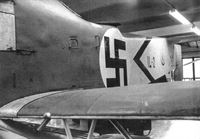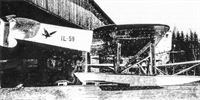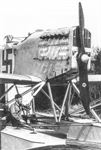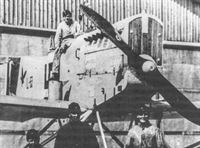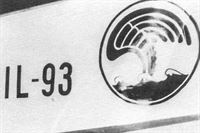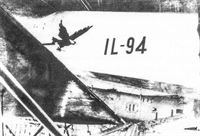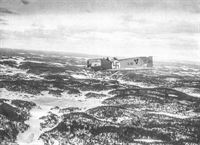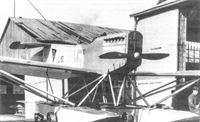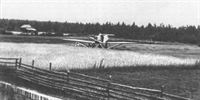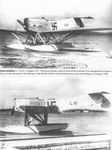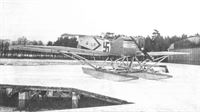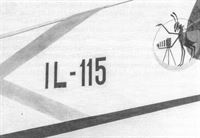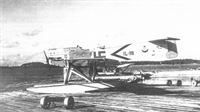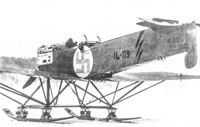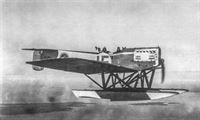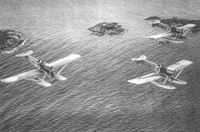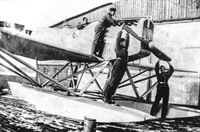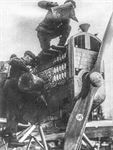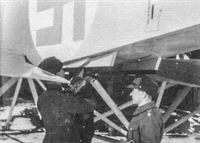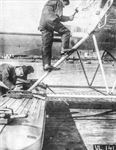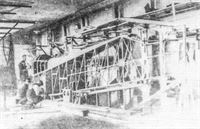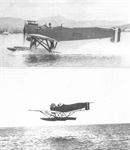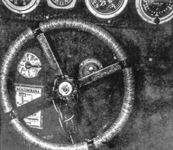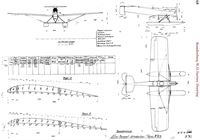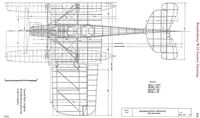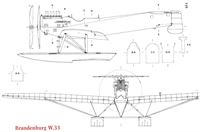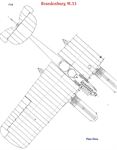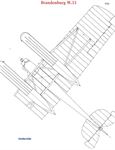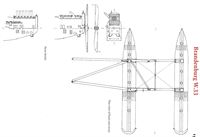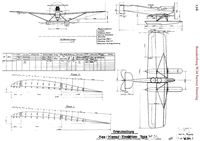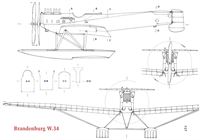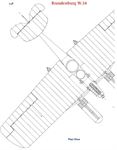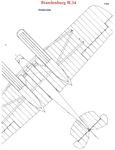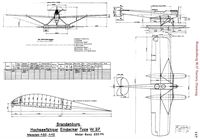Книги
Centennial Perspective
C.Owers
Hansa-Brandenburg Aircraft of WWI. Volume 3 - Monoplane Seaplanes
418
C.Owers - Hansa-Brandenburg Aircraft of WWI. Volume 3 - Monoplane Seaplanes /Centennial Perspective/ (19)
In its original version, the Phonix 20.16 represented the final attempt to perfect the sesquiplane wing that, although lighter in weight, lacked the robustness required by a high-performance fighter.
The 20.16 prototype was a further development of the 20.14 design with sesquiplane wing cellule. The new upper wing had rounded wingtips, tapered trailing edges at the ailerons, and incorporated washout so the ailerons would not stall before the inboard section of the wings. If the ailerons stall first, the pilot loses roll control ata critical moment and the aircraft can easily enter a spin before the pilot can recover from the stall.
The 20.16 prototype shows its new upper wing and tailplane design. Unlike the earlier 20.14, the upper wing planform now resembles that of the lower wing. The radiator was installed in the inboard section of the port upper wing and the VK gun canister has been eliminated; synchronized guns would be used from now on. The vertical fin added to the 20.14 prototype has been retained for directional stability.
The re-designed Phonix 20.16 prototype with its revised, conventional wing cellule by Edmund Sparmann. Upper and lower wingtips were rounded. This was a stronger wing cellule that improved on the similar wing on the 20.15 prototype. Testing revealed good performance and flying qualities, and the production Phonix D.I fighter was based on this version of the 20.16. The radiator for the 200-hp Daimler was now located above the upper wing, a position that ensured adequate cooling at the expense of higher drag.
UFAG-built C.I 369.48 of Flik 450 at Levico with two other C.I aircraft; a Phonix C.I rests in the far right background.
Austro-Hungarian warplanes abandoned at Aidussino in November 1918 symbolize the defeat and disintegration of the Austro-Hungarian Empire. An UFAG-built Brandenburg C.I (369 series?) is in the foreground. A Phonix D.II rests on its nose with Phonix C.I 121.60 upside down. The noses of an Aviatik D.I and UFAG C.I are at right.
The Phonix 20.15 mated the fuselage of a Brandenburg D I with a new wing cellule.
The Phonix 20.15 during flight testing at Aspern in June 1917. The Sparmann wing cellule followed the contemporary trend in fighter design.
The Phonix 20.15 during flight testing at Aspern in June 1917. The Sparmann wing cellule followed the contemporary trend in fighter design.
Austro-Hungarian warplanes abandoned at Aidussino in November 1918 symbolize the defeat and disintegration of the Austro-Hungarian Empire. An UFAG-built Brandenburg C.I (369 series?) is in the foreground. A Phonix D.II rests on its nose with Phonix C.I 121.60 upside down. The noses of an Aviatik D.I and UFAG C.I are at right.
Austro-Hungarian warplanes abandoned at Aidussino in November 1918 symbolize the defeat and disintegration of the Austro-Hungarian Empire. An UFAG-built Brandenburg C.I (369 series?) is in the foreground. A Phonix D.II rests on its nose with Phonix C.I 121.60 upside down. The noses of an Aviatik D.I and UFAG C.I are at right.
Afterword
Heinkel opened a small manufacturing business in Grunbach after the war. Carl Caspar had managed to salvage some of his aeronautical works and approached Heinkel as a designer. According to Heinkel's autobiography Christiansen made the Americans aware of Heinkel's efforts with submarine borne aircraft and the US Navy was interested enough to ask for a design. This was despite the Armistice and Peace Treaty provisions that prevented Germany from manufacturing aircraft for a period then from constructing military aircraft or any aircraft that could be modified into a military aircraft. The fact that the US did not sign the Peace Treaty probably overcame any legal problems that the USN may have otherwise encountered.
Joining the Carl Caspar Werke at Travemunde in 1921, Heinkel designed the single-seat Caspar U.1. While this was developed by Heinkel from his work on submarine carried aircraft during the war the U.1 was a biplane floatplane with cantilevered wings without interplane struts, unlike the Brandenburg W.20 flying boat. Power was supplied by a 55-hp five-cylinder Siemens-Halske radial engine. The wings could be folded for storage onboard a submarine. Constructed in great secrecy, two were purchased by the USN (Bureau Nos. A-5434 and A-6435). Japan also purchased two; these were designated U.2 and were powered by a 80-hp Gnome radial engine. Only Japan continued to develop the concept, operating submarine-borne aircraft in World War II, the Aichi A6A1 Seiran being the ultimate aircraft of its type.
The Caspar Werke had been founded in 1921 and occupied the former Fokker works at Travemunde. Heinkel was the first aircraft designer for the firm and it was here that he received his break back into aircraft design and construction post-Armistice. Due to the restrictions of the Armistice and Peace Treaty forbidding and then limiting the production of aircraft in Germany, components were built in different locations in Germany and smuggled abroad and assembled there, mostly at the Swedish Svenska Aero, the firm established by Heinkel and Carl Bucker in Sweden at Lidingo in 1921.
Heinkel moved to Sweden with German workers who would assemble the aircraft in Sweden. Only a few components, the rudders and pontoons, were actually built in Sweden. The Swedish Navy placed orders for the Caspar S.1, soon to be produced as the Heinkel He.1. Heinkel left Caspar and in December 1922 after the restrictions on the building of aircraft were lifted and established Ernst Heinkel Flugzeugwerke AG located at Warnemunde on a lakeside site near the north German coast. Military aircraft were still forbidden and Svenska Aero was to produce components, the aircraft usually being erected at the Swedish Naval Dockyards at Gashaga.
The Caspar U.1 and S.1 seaplanes were exhibited at the Gothenburg Exhibition in 1923 where the U.1 was described as "designed for stowage on a submarine." The S.1 was "ordered by the Swedish Navy." The British were not fooled; the S.1 was reported in Flight as showing definite Brandenburg influences. What arrangement Heinkel had with Caspar is unknown but the Caspar S.1 soon reappeared as the Heinkel He.1. The same copy of Jane’s recorded that the firm of Aero A.B. Lidingon, Stockholm, was building a number of S.1 floatplanes designed by Heinkel for the Swedish Navy. It recorded that the first machine had a 240-hp Maybach IVa but later examples would have the 240-hp Siddeley Puma engine. The lighter engine allowed for a greater useful load. One example had been fitted with a Rolls Royce Eagle engine. In fact, Jane’s and The Aeroplane published the same three-view with the aircraft captioned as the S.1 and the He.1.
The He.1 was followed by the larger He.2 that was built in Sweden by Svenska Aero. Heinkel followed the theme with the He.4, He.5 and He.8 which saw the low-wing monoplane seaplane serve in the Navies of Northern European countries in the years between the World Wars. Denmark still had thirteen He.8 floatplanes in service when Germany occupied the country in 1940.(56)
Caspar's company was converted into a limited company early in 1925 as Caspar-Werke AG, Travemunde. By this time the Technical Director was H. Moll, who had served as a pilot during the war. Involved with aviation since 1913, Moll joined the Board at the beginning of 1926. He was responsible for the designs of all yachts and racing motor boats built by the Caspar-Werke.
By this time Dip. Ing. Ernst Ritter von Loessl was responsible for all Caspar aircraft designs. The Caspar S.1 was described as derived from the Hansa-Brandenburg sea-monoplanes with the general construction simplified to adapt the machine to commercial aviation by allowing for four passengers. The machine followed the wooden construction of the war time Brandenburgs. "The construction is very robust and is capable of being used in quite rough seas."(57) Despite developing aircraft of its own after Heinkel left, in April 1928 the company had to file for bankruptcy because of a lack of orders.
(56) http://cosmofusion.com/kategorier/underholdning/svenska-aero.php
(57) Jane's All the World's Aircraft. P.172b.
Specifications
Type Brandenburg W.27 Caspar S.1 Svenska Aero S.1
Dimensions in m
Span 17.700 17.5 17.5
Length Ca 12.390 12.65 12.65
Height - 3.85 -
Wing Area, m2 - - 52.5
Empty Wt., kg - - 1,550
Useful Load, kg - 700 850
Fuel Weight, kg - - 200
Total Wt., kg - - 2,600
Performance
Speed - 160 kph 165 kph
Climb to 1,000 m - - 7 min.
Ceiling - - 5,500 m
Engine - 260-hp Maybach -
Sources: 1. W.27: Brandenburg Factory three-view 2. Caspar S.1: The Aeroplane, August 1923. 3. Svenska Aero S.1: Jane’s All the World’s Aircraft.
Heinkel opened a small manufacturing business in Grunbach after the war. Carl Caspar had managed to salvage some of his aeronautical works and approached Heinkel as a designer. According to Heinkel's autobiography Christiansen made the Americans aware of Heinkel's efforts with submarine borne aircraft and the US Navy was interested enough to ask for a design. This was despite the Armistice and Peace Treaty provisions that prevented Germany from manufacturing aircraft for a period then from constructing military aircraft or any aircraft that could be modified into a military aircraft. The fact that the US did not sign the Peace Treaty probably overcame any legal problems that the USN may have otherwise encountered.
Joining the Carl Caspar Werke at Travemunde in 1921, Heinkel designed the single-seat Caspar U.1. While this was developed by Heinkel from his work on submarine carried aircraft during the war the U.1 was a biplane floatplane with cantilevered wings without interplane struts, unlike the Brandenburg W.20 flying boat. Power was supplied by a 55-hp five-cylinder Siemens-Halske radial engine. The wings could be folded for storage onboard a submarine. Constructed in great secrecy, two were purchased by the USN (Bureau Nos. A-5434 and A-6435). Japan also purchased two; these were designated U.2 and were powered by a 80-hp Gnome radial engine. Only Japan continued to develop the concept, operating submarine-borne aircraft in World War II, the Aichi A6A1 Seiran being the ultimate aircraft of its type.
The Caspar Werke had been founded in 1921 and occupied the former Fokker works at Travemunde. Heinkel was the first aircraft designer for the firm and it was here that he received his break back into aircraft design and construction post-Armistice. Due to the restrictions of the Armistice and Peace Treaty forbidding and then limiting the production of aircraft in Germany, components were built in different locations in Germany and smuggled abroad and assembled there, mostly at the Swedish Svenska Aero, the firm established by Heinkel and Carl Bucker in Sweden at Lidingo in 1921.
Heinkel moved to Sweden with German workers who would assemble the aircraft in Sweden. Only a few components, the rudders and pontoons, were actually built in Sweden. The Swedish Navy placed orders for the Caspar S.1, soon to be produced as the Heinkel He.1. Heinkel left Caspar and in December 1922 after the restrictions on the building of aircraft were lifted and established Ernst Heinkel Flugzeugwerke AG located at Warnemunde on a lakeside site near the north German coast. Military aircraft were still forbidden and Svenska Aero was to produce components, the aircraft usually being erected at the Swedish Naval Dockyards at Gashaga.
The Caspar U.1 and S.1 seaplanes were exhibited at the Gothenburg Exhibition in 1923 where the U.1 was described as "designed for stowage on a submarine." The S.1 was "ordered by the Swedish Navy." The British were not fooled; the S.1 was reported in Flight as showing definite Brandenburg influences. What arrangement Heinkel had with Caspar is unknown but the Caspar S.1 soon reappeared as the Heinkel He.1. The same copy of Jane’s recorded that the firm of Aero A.B. Lidingon, Stockholm, was building a number of S.1 floatplanes designed by Heinkel for the Swedish Navy. It recorded that the first machine had a 240-hp Maybach IVa but later examples would have the 240-hp Siddeley Puma engine. The lighter engine allowed for a greater useful load. One example had been fitted with a Rolls Royce Eagle engine. In fact, Jane’s and The Aeroplane published the same three-view with the aircraft captioned as the S.1 and the He.1.
The He.1 was followed by the larger He.2 that was built in Sweden by Svenska Aero. Heinkel followed the theme with the He.4, He.5 and He.8 which saw the low-wing monoplane seaplane serve in the Navies of Northern European countries in the years between the World Wars. Denmark still had thirteen He.8 floatplanes in service when Germany occupied the country in 1940.(56)
Caspar's company was converted into a limited company early in 1925 as Caspar-Werke AG, Travemunde. By this time the Technical Director was H. Moll, who had served as a pilot during the war. Involved with aviation since 1913, Moll joined the Board at the beginning of 1926. He was responsible for the designs of all yachts and racing motor boats built by the Caspar-Werke.
By this time Dip. Ing. Ernst Ritter von Loessl was responsible for all Caspar aircraft designs. The Caspar S.1 was described as derived from the Hansa-Brandenburg sea-monoplanes with the general construction simplified to adapt the machine to commercial aviation by allowing for four passengers. The machine followed the wooden construction of the war time Brandenburgs. "The construction is very robust and is capable of being used in quite rough seas."(57) Despite developing aircraft of its own after Heinkel left, in April 1928 the company had to file for bankruptcy because of a lack of orders.
(56) http://cosmofusion.com/kategorier/underholdning/svenska-aero.php
(57) Jane's All the World's Aircraft. P.172b.
Specifications
Type Brandenburg W.27 Caspar S.1 Svenska Aero S.1
Dimensions in m
Span 17.700 17.5 17.5
Length Ca 12.390 12.65 12.65
Height - 3.85 -
Wing Area, m2 - - 52.5
Empty Wt., kg - - 1,550
Useful Load, kg - 700 850
Fuel Weight, kg - - 200
Total Wt., kg - - 2,600
Performance
Speed - 160 kph 165 kph
Climb to 1,000 m - - 7 min.
Ceiling - - 5,500 m
Engine - 260-hp Maybach -
Sources: 1. W.27: Brandenburg Factory three-view 2. Caspar S.1: The Aeroplane, August 1923. 3. Svenska Aero S.1: Jane’s All the World’s Aircraft.
The post-war Swedish Caspar S.1, produced as the Heinkel He.1, was clearly derived from the war-time Brandenburg floatplanes.
This same three-view appeared in The Aeroplane and Jane's captioned as the Caspar S.1 and the Heinkel He.1.
Afterword
Heinkel opened a small manufacturing business in Grunbach after the war. Carl Caspar had managed to salvage some of his aeronautical works and approached Heinkel as a designer. According to Heinkel's autobiography Christiansen made the Americans aware of Heinkel's efforts with submarine borne aircraft and the US Navy was interested enough to ask for a design. This was despite the Armistice and Peace Treaty provisions that prevented Germany from manufacturing aircraft for a period then from constructing military aircraft or any aircraft that could be modified into a military aircraft. The fact that the US did not sign the Peace Treaty probably overcame any legal problems that the USN may have otherwise encountered.
Joining the Carl Caspar Werke at Travemunde in 1921, Heinkel designed the single-seat Caspar U.1. While this was developed by Heinkel from his work on submarine carried aircraft during the war the U.1 was a biplane floatplane with cantilevered wings without interplane struts, unlike the Brandenburg W.20 flying boat. Power was supplied by a 55-hp five-cylinder Siemens-Halske radial engine. The wings could be folded for storage onboard a submarine. Constructed in great secrecy, two were purchased by the USN (Bureau Nos. A-5434 and A-6435). Japan also purchased two; these were designated U.2 and were powered by a 80-hp Gnome radial engine. Only Japan continued to develop the concept, operating submarine-borne aircraft in World War II, the Aichi A6A1 Seiran being the ultimate aircraft of its type.
The Caspar Werke had been founded in 1921 and occupied the former Fokker works at Travemunde. Heinkel was the first aircraft designer for the firm and it was here that he received his break back into aircraft design and construction post-Armistice. Due to the restrictions of the Armistice and Peace Treaty forbidding and then limiting the production of aircraft in Germany, components were built in different locations in Germany and smuggled abroad and assembled there, mostly at the Swedish Svenska Aero, the firm established by Heinkel and Carl Bucker in Sweden at Lidingo in 1921.
Heinkel moved to Sweden with German workers who would assemble the aircraft in Sweden. Only a few components, the rudders and pontoons, were actually built in Sweden. The Swedish Navy placed orders for the Caspar S.1, soon to be produced as the Heinkel He.1. Heinkel left Caspar and in December 1922 after the restrictions on the building of aircraft were lifted and established Ernst Heinkel Flugzeugwerke AG located at Warnemunde on a lakeside site near the north German coast. Military aircraft were still forbidden and Svenska Aero was to produce components, the aircraft usually being erected at the Swedish Naval Dockyards at Gashaga.
The Caspar U.1 and S.1 seaplanes were exhibited at the Gothenburg Exhibition in 1923 where the U.1 was described as "designed for stowage on a submarine."
<...>
Caspar U.1 Specifications
Span 7.2 m
Length 6.2 m
Height 2.33 m
Wing Area 14 m2
Empty Weight 360 kg
Loaded Weight 510 kg
Performance
Speed 148 km/hr
Climb to 1,000 m 6 minutes
Ceiling 1,900 m
Source: Wagner, R. and Nowarra, H., German Combat Planes, Doubleday Si Co., NY, 1971
Heinkel opened a small manufacturing business in Grunbach after the war. Carl Caspar had managed to salvage some of his aeronautical works and approached Heinkel as a designer. According to Heinkel's autobiography Christiansen made the Americans aware of Heinkel's efforts with submarine borne aircraft and the US Navy was interested enough to ask for a design. This was despite the Armistice and Peace Treaty provisions that prevented Germany from manufacturing aircraft for a period then from constructing military aircraft or any aircraft that could be modified into a military aircraft. The fact that the US did not sign the Peace Treaty probably overcame any legal problems that the USN may have otherwise encountered.
Joining the Carl Caspar Werke at Travemunde in 1921, Heinkel designed the single-seat Caspar U.1. While this was developed by Heinkel from his work on submarine carried aircraft during the war the U.1 was a biplane floatplane with cantilevered wings without interplane struts, unlike the Brandenburg W.20 flying boat. Power was supplied by a 55-hp five-cylinder Siemens-Halske radial engine. The wings could be folded for storage onboard a submarine. Constructed in great secrecy, two were purchased by the USN (Bureau Nos. A-5434 and A-6435). Japan also purchased two; these were designated U.2 and were powered by a 80-hp Gnome radial engine. Only Japan continued to develop the concept, operating submarine-borne aircraft in World War II, the Aichi A6A1 Seiran being the ultimate aircraft of its type.
The Caspar Werke had been founded in 1921 and occupied the former Fokker works at Travemunde. Heinkel was the first aircraft designer for the firm and it was here that he received his break back into aircraft design and construction post-Armistice. Due to the restrictions of the Armistice and Peace Treaty forbidding and then limiting the production of aircraft in Germany, components were built in different locations in Germany and smuggled abroad and assembled there, mostly at the Swedish Svenska Aero, the firm established by Heinkel and Carl Bucker in Sweden at Lidingo in 1921.
Heinkel moved to Sweden with German workers who would assemble the aircraft in Sweden. Only a few components, the rudders and pontoons, were actually built in Sweden. The Swedish Navy placed orders for the Caspar S.1, soon to be produced as the Heinkel He.1. Heinkel left Caspar and in December 1922 after the restrictions on the building of aircraft were lifted and established Ernst Heinkel Flugzeugwerke AG located at Warnemunde on a lakeside site near the north German coast. Military aircraft were still forbidden and Svenska Aero was to produce components, the aircraft usually being erected at the Swedish Naval Dockyards at Gashaga.
The Caspar U.1 and S.1 seaplanes were exhibited at the Gothenburg Exhibition in 1923 where the U.1 was described as "designed for stowage on a submarine."
<...>
Caspar U.1 Specifications
Span 7.2 m
Length 6.2 m
Height 2.33 m
Wing Area 14 m2
Empty Weight 360 kg
Loaded Weight 510 kg
Performance
Speed 148 km/hr
Climb to 1,000 m 6 minutes
Ceiling 1,900 m
Source: Wagner, R. and Nowarra, H., German Combat Planes, Doubleday Si Co., NY, 1971
W.29 monoplanes 2580 and 2583 in damaged condition together with two Friedrichshafen FF49 biplanes in the background, (via AHT AL0225-59)
Austro-Hungarian warplanes abandoned at Aidussino in November 1918 symbolize the defeat and disintegration of the Austro-Hungarian Empire. An UFAG-built Brandenburg C.I (369 series?) is in the foreground. A Phonix D.II rests on its nose with Phonix C.I 121.60 upside down. The noses of an Aviatik D.I and UFAG C.I are at right.
Brandenburg C.I(U) 69.71 of Flik 26, Spring 1918. The red 81 black band was the Flik 26 unit marking. The fuselage cross applied at the factory has been scrapped off.
Brandenburg C.I(U) 169.51 of Flik 69S, Gajarine Aerodrome, June 1918. The cross on the rudder and fin was the Flik 69S unit marking and is thought to have been green as shown here.
Brandenburg C.I(U) 169.112 of Flik 69S, Gajarine Aerodrome, June 1918. The cross on the rudder and fin was the Flik 69S unit marking and is thought to have been green as shown here.
Craftlab Restaurations, Modell und Ausstellungsbau Gmbh is also building a reproduction Brandenburg C.I. Here is shown the threaded fitting for the rear spar of the lower wing that enabled the wing sweep to be adjusted, an interesting feature of all C.I aircaft.
The fuselage of Brandenburg C.I serial 129.55 with fuselage stripes, rests on a lorry in the background.This photograph gives a good idea of the conditions that the unit occupied.
Close-up of downward firing guns mounted in a Brandenburg C.I. As a Schlachtflugzeug unit, Flik 69 probably had one of the specially converted ground attacked biplanes for operational trials. As related in Volume 1 Series 429 machines were used for general duties due to a shortage of armor plate.
Brandenburg C.I 61.09 of Flik 4 ready for another mission. This early aircraft is in plain markings and carries no over-wing gun canister.
Brandenburg C.I 61.21 appears to wears its factory finish.
Brandenburg C.I(U) 61.24 photographed during acceptance proceedings at Aspern. On 15 June 1916, pilot Zugsfuhrer Karl Rose and Oberleutnant Johann Baumgartner were each credited with their first victory by bringing down an Italian seaplane over Lago di Garda after a fierce air battle in which the pilot was wounded and forced to make an emergency landing.
Brandenburg C.I(U) 61.24 photographed during acceptance proceedings at Aspern. On 15 June 1916, pilot Zugsfuhrer Karl Rose and Oberleutnant Johann Baumgartner were each credited with their first victory by bringing down an Italian seaplane over Lago di Garda after a fierce air battle in which the pilot was wounded and forced to make an emergency landing.
UFAG-built C.I 61.21 at Aspern appears to be in factory finish. This early aircraft has no over-wing gun.
C.I 64.57 after losing a wheel. This early C.I is in plain finish and no over-wing gun canister is mounted.
Brandenburg C.I 64.60 with crew ready for another mission.
Brandenburg C.I 64.66 while attached to Flik 26 on the Russian Front. It was later converted to a dual-control trainer.
Hansa-Brandenburg C.I of the type built under license by Rinne for Austria-Hungary. A robust aircraft adaptable to increasingly powerful engines, the C.I was a mainstay of the Fliegertruppe. This is not one of the aircraft built by Rinne.
Brandenburg C.I 64.66 while attached to Flik 26 on the Russian Front. It was later converted to a dual-control trainer.
Hansa-Brandenburg C.I of the type built under license by Rinne for Austria-Hungary. A robust aircraft adaptable to increasingly powerful engines, the C.I was a mainstay of the Fliegertruppe. This is not one of the aircraft built by Rinne.
An UFAG-built C.I of the 69 series with Fhnr. Barbieri of Flik 22. The aircraft has been camouflaged in an unknown overall dark color.
C.I 69.71 wears the red and black fuselage stripes assigned as a unit marking to Flik 26 by an army command order of 14 April 1918. Pilot Kowalczik scored two victories in this aircraft.
Brandenburg C.I(U) 169.01 with Hauptmann Schwarzbock, commanding officer of Flik 16/D on 29 July 1918. The wooden machine gun ring mounted on rollers was introduced with this series.
Hptm. Erwin Schwarzbock, commanding officer of Flik 16, photographed in front of C.I 169.101 on 29 July 1918. The stylized "S" marking is for Schwarzbock. He survived the war and passed away 31 October, 1974, at 87 years of age.
Hptm. Erwin Schwarzbock, commanding officer of Flik 16, photographed in front of C.I 169.101 on 29 July 1918. The stylized "S" marking is for Schwarzbock. He survived the war and passed away 31 October, 1974, at 87 years of age.
Brandenburg C.I 169.08 wearing the markings of Flik 16 on 6 July 1918 photographed with its crew. The text under the elevator translates as: "Elevator cables must be crossed."
Another airfield scene with ground crew and their paraphernalia of saw horses and ladders. The stark contrast of the dark varnished fuselage to the clear doped wings together with the lack of a fuselage cross is noteworthy. The serial appears to be 169.51.
Detail of the tailplane support strut of 169.72. The fuselage has been over-painted with a stipple effect while the fin has a sworl effect that was achieved with sponges according to the research of the late Dr. M. O'Connor.
Oblt. Imre Jeszenszky, Commanding Officer of Flik 71D, photographed in C.I 169.75 in May 1918. The C.I has the over-wing gun canister and appears to be painted in at least two camouflage colors.
The observer is taking on carrier pigeons to a C.I identified as 169.112 on 2 July 1918. Pigeons were an essential method of sending messages before wireless telephony was truly developed. The hexagon camouflage is well displayed. Points to note are the slim machinegun barrel from the "Baby Coffin" (twin-barrel machinegun?); the forward gun sight on the exhaust pipe, and gun ring details. (For another view of this machine see Cross & Cockade International Vol.18, No.2, P.79).
169.112's crew give a mission debrief. The hexagon camouflage on the rudder shows well in this photograph.
Anton Riediger in C.I 169.119 of Flik 71D; the aircraft wears a colorful hexagonal camouflage scheme.
This C.I appears to be a series 169 machine; however, its serial cannot be read clearly on the dark hexagon camouflage. This photograph is full of atmosphere with the canvas hangars, ground crew, various colored uniforms. Note that the "Baby Coffin" machine gun housing on the upper wing is open.
Brandenburg C.I of the 169 series abandoned at Egna on 10 November 1918. It has the serrated camouflage on all surfaces, including rudder and fuselage, with the original wing crosses overpainted and new crosses outboard. Interestingly, the patee crosses on the fuselage and tail look like those on Richthofen's Fokker Dr.I 425/17.
Pilot Jakob Machiedo Edl. von Palilo stands in front of a C.I of the 369 series with painted hexagons overall upper surfaces.
A 369 series C.I with Feldpilot Oblt. Arpod Pindter von Pindfenshofen, chief pilot of Flik 74J during May-September 1918. Earlier he had been an observer with Flik 12D.
The wings of this C.I appears to be pre-printed hexagon fabric more in keeping with the German style of "lozenge" fabric than the usual Austro-Hungarian examples.
The wings of this C.I appears to be pre-printed hexagon fabric more in keeping with the German style of "lozenge" fabric than the usual Austro-Hungarian examples.
Observer Lt. Peter stands in front of an UFAG-built C.I of the 369 series on 30 July 1918. The aircraft has a 230-hp Hiero engine.
The Koudela gun mount, invented by Offizierstellvertreter Franz Koudela, was fabricated at the Front and installed in aircraft flown by Fliks 26/DS and 65/DS. Shown here is the Brandenburg C.I(U) 369.107 of Flik 26/DS in August 1918.
Brandenburg C.I 369.107 (369.17 ???) of Flik 26S with crew Zugsfuhrer Tesci and Oblt. Vwira in the late summer of 1918.
Brandenburg C.I 369.107 (369.17 ???) of Flik 26S with crew Zugsfuhrer Tesci and Oblt. Vwira in the late summer of 1918.
NCO pilots, including Sift, Czerny, Hollriegh, and Berth, of Flik 16 with C.I 369.20 in the background.
Brandenburg C.I 369.23 of Flik 12Rb has been camouflaged in an unknown overall dark color. Unfortunately, the crewmen are not identified.
Brandenburg C.I 369.40 photographed in June 1918. This aircraft was shot down in flames on 8 June 1918 while serving with Flik 11F. The C.I in the background carries the red/white/red fuselages stripes of Flik 19.
UFAG-built C.I 369.48 of Flik 450 at Levico with two other C.I aircraft; a Phonix C.I rests in the far right background.
"Flieger Start 2.7.18." Details to note are the twin-barrel machinegun in the over-wing mounting, bomb racks under the fuselage, nose cowl, and how the hexagons tend to appear one color in some lighting conditions, especially the dark colors.
The Hansa-Brandenburg C.I was a sturdy and robust aircraft design that lent itself well to improvements through refinement and installation of ever more powerful engines. Built by the parent company and license-built by three other firms, it flew from late 1915 through the end of the war as a frontline aircraft. It was used by other air forces well into the 1930s.
Here a late-production C.I is serving with Flik 69/S, a unit specializing it ground attack. The 'overwing baby coffin' carries two machine guns.
The Hansa-Brandenburg C.I was a sturdy and robust aircraft design that lent itself well to improvements through refinement and installation of ever more powerful engines. Built by the parent company and license-built by three other firms, it flew from late 1915 through the end of the war as a frontline aircraft. It was used by other air forces well into the 1930s.
Here a late-production C.I is serving with Flik 69/S, a unit specializing it ground attack. The 'overwing baby coffin' carries two machine guns.
Brandenburg C.I with engine running ready for take off. The wheel covers carry the national insignia and an over-wing gun canister is fitted.
Three Brandenburg C.I aircraft and two D.I fighters of Fluggeschwader 1 return to land at Divacca airfield after a mission.
"Verladen von Fliegerbomben 2.7.18." Loading bombs on a C.I in plain finish. The curved horizontal tailplane and fully-cowled engine may be noted.
"Befehlsausgabe an die Flieger 28.6.18." Pilots and observers are briefed on their mission. The C.I in the background is camouflaged in the hexagon scheme. The upper wing crosses have no white outline.
"Montieren von Fliegerbomben 28.6.18." Preparing bombs for the C.I machines. The two C.I biplanes are in different color schemes.The machine to the left appears to be in the hexagon scheme, while the other is in a plain finish. Neither appears to have fuselage crosses. Both machines have the late gun ring.
"Dekorierung von Fliegermannschaft 3.7.18." Crew receiving their decorations. Again the two C.I biplanes in the background have different color schemes.
“Einsetzen der Torpedo-Bomben 28.6.18." Loading bombs to the underside of the fuselage of a C.I. Note the late style gun ring and flare cartridges on the fuselage side, lack of fuselage cross and serial.
Anywhere you can rest your head! The gentleman in the cot is comfortable despite the proximity of bombs and ammunition!
The upper wing surfaces of both wings and the 'baby coffin' gun container of this C.I were over-painted in a make-shift, brush-applied camouflage scheme. The crewman is not known.
Detail of the bomb racks under a C.I fuselage. The wing walk, claw brake, and foot step details may be seen. Note how the undercarriage bracing has been wrapped with fabric.
Detail of the under-wing bomb rack of a C.I biplane. The fuselage has a field-applied mottle finish.
Fabric work on a C.I stabilizer and fin. In front on the table is a rear landing gear strut from a Phonix-built C.I.
Interesting view of the observer's cockpit of a 269-series C.I.
The wheel steering mechanism of a 9000 candlepower searchlight experimentally installed in a Brandenburg C.I was similar to the larger 15,000 candlepower searchlight mounted in the G.I 62.76 and 62.77 bombers.
The wheel steering mechanism of a 9000 candlepower searchlight experimentally installed in a Brandenburg C.I was similar to the larger 15,000 candlepower searchlight mounted in the G.I 62.76 and 62.77 bombers.
This early Brandenburg C.I apparently crashed in a take-off accident since it is still armed with bombs, some of which have been torn from their racks by the force of the crash.
Brandenburg C.I 61.09 of Flik 4 at Wippach was another victim of a landing accident. Sudden gusts of wind could easily upset these light aircraft during landing and cause a result like this.
Brandenburg C.I 68.05 of Flik 6 has suffered a different type of landing accident by running off the smooth part of the field some time in 1916. Early aircraft had a claw-brake at most.
C.I 69.38 after a crash that was no doubt exciting to the crew. It received a hand-painted application of camouflage paint of at least two colors over the factory finish, and the underside of the lower wing carries a darker finish than clear-doped linen that required an outline around the insignia.
C.I 269.04; one sometimes gets the impression that a nose-stand was a required maneuver to qualify for a pilot's license.
C.I 369 series of Flik 71 was forced down by the Italians. The crew was Feldpilot Zugsf. Josef Gias and Oblt. Abt.The solid fuselage stripe was the Flik 71 unit marking.
Austro-Hungarian warplanes abandoned at Aidussino in November 1918 symbolize the defeat and disintegration of the Austro-Hungarian Empire. An UFAG-built Brandenburg C.I (369 series?) is in the foreground. A Phonix D.II rests on its nose with Phonix C.I 121.60 upside down. The noses of an Aviatik D.I and UFAG C.I are at right.
C.I 369.41 of Oblt. Trefbrunner crashed on 16 June 1918. It carried the multi-color hexagon camouflage pattern and the original insignia.
Two views of UFAG-built Brandenburg C.I 369.51 crashed at San Vendimiano; the aircraft carried a hexagon camouflage scheme over all upper surfaces.
Two views of the crash of C.I 369.61 on 16 June 1918. The aircraft was painted in large hexagons over the upper surfaces.
C.I 369.163 shot down near Treviso. The new Balkan Cross insignia was applied to the wing tip but the original Iron Cross insignia is still visible inboard. The wing was painted in two colors, with the top color applied with a sponge. The original cross appears to have been overpainted with the lighter of the two colors applied to the wing.
This appears to be the remains of a C.I that had the late straight cross markings. The officer with his arm in a sling may well have been the pilot of this wreck.
Brandenburg FB K207
(???) Brandenburg W.13 K307 was forced down on 27 September 1917 by engine failure due to a cracked water jacket. The crew was rescued - and captured - by an Italian MTB that towed K307 back to Brindisi. This photo appears to have been taken from the MTB while originally approaching the aircraft. Embarrassingly, K307 had been in a formation of seven KuK flying boats that set out to bomb Brindisi. Frglt. Emanuel Lerch and Fhr.d.Res. Adalbert Lenti were the captured crew.
(???) Brandenburg W.13 K307 was forced down on 27 September 1917 by engine failure due to a cracked water jacket. The crew was rescued - and captured - by an Italian MTB that towed K307 back to Brindisi. This photo appears to have been taken from the MTB while originally approaching the aircraft. Embarrassingly, K307 had been in a formation of seven KuK flying boats that set out to bomb Brindisi. Frglt. Emanuel Lerch and Fhr.d.Res. Adalbert Lenti were the captured crew.
Phonix-Built Brandenburg D.I 28.26 of Flik 16 featured an unusual gun mount. Unlike the usual VK gun canister, the rear of the gun could be lowered in flight, enabling the pilot to clear jams.
The Brandenburg D.I prototype with original headrest and tail with radiator obscuring the pilot's view forward.
The first Brandenburg KD prototype, powered by a 160 hp Mercedes engine, made its appearance in early 1916. The extreme aileron washout was unusual.
The first Brandenburg KD prototype, powered by a 160 hp Mercedes engine, made its appearance in early 1916. The extreme aileron washout was unusual.
Then as today, a new aircraft caused much curiosity. Shown here is the arrival of the 60.55 prototype fighter at Flik 26 airfield in July-August 1916. Armament was not installed at the time.
Views of Brandenburg 60.55, the second prototype of the D.I, before armament was installed. The D.I had a very distinctive appearance with its 'star' strut design and small rudder with no fixed fin. The struts and bulky engine design restricted the pilot's field of view more than most fighters, an unfortunate aspect of the design. Of greater concern was the aircraft's propensity to spin unexpectedly.
Views of Brandenburg 60.55, the second prototype of the D.I, before armament was installed. The D.I had a very distinctive appearance with its 'star' strut design and small rudder with no fixed fin. The struts and bulky engine design restricted the pilot's field of view more than most fighters, an unfortunate aspect of the design. Of greater concern was the aircraft's propensity to spin unexpectedly.
View of Brandenburg 60.55, the second prototype of the D.I. The workmanship and finish were excellent and the aircraft was strong and fast. Armament has not yet been installed.
The second KD prototype 60.55 (ex 05.09) shows drag-reducing refinements such as an airfoil radiator, a raised and rounded rear fuselage, a refined engine cowling, and tapered strut ends.
The second KD prototype 60.55 (ex 05.09) shows drag-reducing refinements such as an airfoil radiator, a raised and rounded rear fuselage, a refined engine cowling, and tapered strut ends.
Brandenburg D.I 65.60 without armament; the serial number was stenciled on parts of the engine cowling.
The Brandenburg D.I 65.60 trainer, based at Flek 4 in Szombathely, was still on charge in October 1918. The large exhaust manifold was characteristic of the 160 hp Daimler version. The crossed-wire bracing underneath the wing radiator was a field modification.
The Brandenburg D.I 65.60 trainer, based at Flek 4 in Szombathely, was still on charge in October 1918. The large exhaust manifold was characteristic of the 160 hp Daimler version. The crossed-wire bracing underneath the wing radiator was a field modification.
"Ганза Бранденбург" D-I серии 65 с двигателем "Австро-Даймлер"
Hptm. Raoul Stojsavljevic in D.I 28.68 (65.68 ??? )of Flik 34 in February 1917. Known as "The Iron Stoj", he became an ace in this aircraft and finally achieved 10 confirmed victories. The fuselage of this aircraft is in the Prague Technical Museum.
Hptm. Raoul Stojsavljevic in D.I 28.68 (65.68 ??? )of Flik 34 in February 1917. Known as "The Iron Stoj", he became an ace in this aircraft and finally achieved 10 confirmed victories. The fuselage of this aircraft is in the Prague Technical Museum.
Two views of unarmed Brandenburg D.I 65.71, which was used as a trainer assigned to Flek 6. The series 65.7x aircraft had car-type nose radiators for their 150-hp Daimler engines. It was written off in September 1917 after a landing accident.
Brandenburg D.I 65.72, accepted on 24 November 1916, shown here during acceptance trials. Unlike the first series, the strut attachment points have been fitted with streamlined covers. Armament remains to be installed.
Unarmed Brandenburg D.I 65.72; accepted on November 20, 1916, it was used as a fighter trainer with Flek 6 and was written off on May 10, 1917 after a take-off accident. The prominent nose radiator gave the 65.7x series a distinctive, pugnacious look.
Unarmed Brandenburg D.I 65.72; accepted on November 20, 1916, it was used as a fighter trainer with Flek 6 and was written off on May 10, 1917 after a take-off accident. The prominent nose radiator gave the 65.7x series a distinctive, pugnacious look.
The second production batch of the Brandenburg D.I (here 65.72) was powered by a 150 hp Daimler engine and fitted with an auto radiator. The exhaust stacks were on the left side.
Unarmed Brandenburg D.I 65.72; accepted on November 20, 1916, it was used as a fighter trainer with Flek 6 and was written off on May 10, 1917 after a take-off accident. The prominent nose radiator gave the 65.7x series a distinctive, pugnacious look.
Unarmed Brandenburg D.I 65.72; accepted on November 20, 1916, it was used as a fighter trainer with Flek 6 and was written off on May 10, 1917 after a take-off accident. The prominent nose radiator gave the 65.7x series a distinctive, pugnacious look.
Unarmed Brandenburg D.I 65.72; accepted on November 20, 1916, it was used as a fighter trainer with Flek 6 and was written off on May 10, 1917 after a take-off accident. The prominent nose radiator gave the 65.7x series a distinctive, pugnacious look.
This series used a nose radiator to cool its 150-hp Austro-Daimler engine. Note the rudder cross is on a white field on the clear doped rudder.
This series used a nose radiator to cool its 150-hp Austro-Daimler engine. Note the rudder cross is on a white field on the clear doped rudder.
D.I 65.75 was assigned to Flik 23 accepted on January 16, 1917. On February 16, 1918 it crashed from an altitude of 3,000 meters near Prosecco airfield; fortunately, pilot Ltn.d.Res. Mirko Vrbancic was not injured.
Unarmed Brandenburg D.I 65.77 was used as a fighter trainer with Flek 6 and was written off in 1917 after a landing accident. This aircraft featured modified tail surfaces intended to improve handling qualities.
The unarmed Brandenburg D.I 65.77 fitted with a rudimentary tail fin to improve flight characteristics. In this series, the pilot's position was raised and the center-section simplified to improve the forward view.
Three Brandenburg C.I aircraft and two D.I fighters of Fluggeschwader 1 return to land at Divacca airfield after a mission.
From Right, Hptm. Brumowski, Oblt. Benno Fiala Ritter von Fernbrugg, and the Archduchess Maria Theresa during her visit to Flik 41/J, July 26, 1917 at Sesana. Unfortunately, the other woman, apparently a nurse, is not known, nor are the identifies of the four men at left known.
Left: Hptm. Brumowski (at right), the Archduchess Maria Theresa (middle), and Oblt. Benno Fiala Ritter von Fernbrugg at her left during her visit to Flik 41/J, July 26, 1917 at Sesana.
Right: Enlarged, cropped version of the photo at left; Hptm. Brumowski (at right), the Archduchess Maria Theresa (middle), and Oblt. Benno Fiala Ritter von Fernbrugg at left.
Right: Enlarged, cropped version of the photo at left; Hptm. Brumowski (at right), the Archduchess Maria Theresa (middle), and Oblt. Benno Fiala Ritter von Fernbrugg at left.
Godwin Brumowski, the leading Austro-Hungarian ace with 35 victories, photographed with one of the Brandenburg D.I fighters he flew in Flik 41/J.
The Brandenburg D.I 28.01 was the first production Phonix-built D.I. Here is has not yet received its armament.
The end of D.I 28.01; the D.I was more susceptible to spins and crashes than most production fighters of the time.
More views of D.I 28.02, the second Phonix-built aircraft, with initial rudder without fixed fin. The keel surface of the extended headrest was intended to provide sufficient stability with minimum drag, but proved inadequate and a number of experiments were carried out with enlarged vertical fins.
Perhaps D.I 28.04, this aircraft has a different rudder and fin shape in search of improved handling.
D.I 28.06 being flown by Julius Arigi over the Isonzo Front, spring 1917, with attached to Fluggeschwader 1. The vertical black line in front of the serial number is a unit marking for Fluggeschwader 1. The dark lower wing tip is due to the shadow of the aircraft taking the photo. With a final total of 32 confirmed victories, Offizierstellvertreter Arigi was the second leading Austro-Hungarian fighter ace.
D.I 28.26 had an unusual gun mount; the curved rail enabled the pilot to lower the gun to clear jams in flight.
Brandenburg D.I 28.37, the personal machine of Feldpilot Stfw. Josef Kiss while with Flik 24. He was credited with three or four victories while flying this machine on his way to a final score of 19 confirmed victories. This aircraft had a gun with Bernatzik synchronizer mounted below the exhaust manifold; in the photo the gun barrel can just be seen protruding from the cowling beneath the manifold slightly above the level of the propeller hub.
Views of Feldpilot Stfw. Josef Kiss flying Brandenburg D.I 28.37, his personal machine while with Flik 24. The absence of the over-wing gun canister due to the synchronized gun on this aircraft is notable.
Views of Feldpilot Stfw. Josef Kiss flying Brandenburg D.I 28.37, his personal machine while with Flik 24. The absence of the over-wing gun canister due to the synchronized gun on this aircraft is notable.
D.I 28.37, flown by Kiss, was one of the few D.I fighters with a synchronized gun, the reason why it did not have the typical 'baby coffin' gun canister on the upper wing. The gun was mounted under the exhaust manifold.
"Ханза-Бранденбург" серии 28.
D.I 28.47 with the typical 'baby coffin' gun mount. This aircraft was assigned to Fliegerdetachment Hauptmann Nikitsch on the Romanian Front. It was flown by pilots Hptm. Nikitsch, Zugsf. Ezekiel, and Zugsf. Hramann, who crashed it on 21 August 1917 and was badly injured.
D.I 28.47 with the typical 'baby coffin' gun mount. This aircraft was assigned to Fliegerdetachment Hauptmann Nikitsch on the Romanian Front. It was flown by pilots Hptm. Nikitsch, Zugsf. Ezekiel, and Zugsf. Hramann, who crashed it on 21 August 1917 and was badly injured.
Another photo of D.I 28.58 in flight with different rudder and fin, apparently an interim step before the final configuration of fin and rudder seen on the facing page was installed.
Two photos of D.I 28.58 in flight with different lighting conditions give a very different impression of the aircraft's color.
An unidentified D.I series 28 in flight. Lack of a gun canister indicates either a synchronized gun or, more likely, that it is being flown as a trainer.
The camouflaged section of Phonix-built Brandenburg D.I 28.68 is one of the few remaining artefacts wearing original Austro-Hungarian camouflage.
Reproduction Brandenburg D.I fighter being built in Vienna, Austria by Craftlab Restaurations, Modell und Ausstellungsbau Gmbh.
Two views of the pair of reproduction Brandenburg D.I fighters being built in Vienna, Austria by Craftlab Restaurations,Model! und Ausstellungsbau Gmbh.
Reproduction Brandenburg D.I fighters being built in Vienna, Austria by Craftlab Restaurations, Modell und Ausstellungsbau Gmbh.
The commander of the LFT, Oberst Uzelac, had a penchant for flying new aircraft. On 7 November 1916, piloting the Brandenburg D.I 65.54 at Flik 19, he learned the hard way how tricky and dangerous the flight characteristics really were.
D.I 65.78 suffered engine failure during a test flight on Jan. 31, 1917 with Flik 34. The pilot, Oblt. Gustav Rubritius, was slightly injured. Armament had not yet been installed. It was written off on March 15, 1917.
Unarmed D.I 65.89 served as a fighter trainer with Flek 6 and survived until at least Aug. 31, 1918.
The end of D.I 65.94 came in September 1917 as the result of a landing accident.
An all-too-common sight, this Brandenburg D.I 65.94 is interesting as it is one of the few fitted with the large rounded rudder and tail fin. The crash resistance of the robust pyramid structure is noteworthy.
An all-too-common sight, this Brandenburg D.I 65.94 is interesting as it is one of the few fitted with the large rounded rudder and tail fin. The crash resistance of the robust pyramid structure is noteworthy.
Brandenburg W.13 K365 was built by UFAG and entered service on 6 June 1917.The colorful red-white-red rudder with KuK insignia is clearly visible.
Brandenburg W.13 K366 'in the rough' after being shot down by Italian Nieuport fighters from 77a and 80a Squadriglie on 27 October 1917. Italian ace Giovanni Ancillotto was the victor and the crew of Frh-id.Res. Richard Groger and Masch. Alois Mericke were taken POW. K366, the first W.13 to be used on operations, had been part of a raid with three other W.13 flying boats and was downed despite being escorted by two flying boat fighters, one of them flown by Lschlt. Gottfried Banfield, the leading Austro-Hungarian naval ace.
Brandenburg W.13 K383 or K388; both were shot down by anti-aircraft fire during bombing missions on the Paive Front with their three-man crew were taken prisoner. K383 was lost 19 March 1918 near Cortelazzo while attacking the supply dump at Maranzano, and K388 was lost on 14 April 1918.
W.13 K434 was downed by two Italian fighters on 22 August 1918 and captured. Here it is seen in a hangar of the Italian 259a Squadriglia.
Brandenburg W.13 under tow. Given the flags, this may be K434 after being captured by Italian forces.
Officers Stormer and Sonsalla pose with a W.29 as background. Note that the weighted radio aerial falls outside on the starboard side of the fuselage and not through the floor. The dark color of the floats is probably due to their finish of bituminous waterproofing paint.The machine to the right is MN 2130.
W.29 monoplanes on patrol with a Brandenburg W.12. The W.29 and W.12 machines have all had their large interim type crosses painted out and the final narrow crosses painted over. On the original print the grey over-painting may be made out.
Two W29s and a W19 photographed from another Brandenburg patrol over the North Sea in summer 1918.
Longer-range W19s would frequently patrol with W12s and W29s, which sometimes waited on the surface until the W19 found a target and returned to lead the flight to it.
Longer-range W19s would frequently patrol with W12s and W29s, which sometimes waited on the surface until the W19 found a target and returned to lead the flight to it.
The Brandenburgs did not have things all their own way; here a W19 burns on the water. It may have been forced down by combat damage or mechanical fault, but because the Marine Number for researching the records is not quite legible, the exact cause is unknown.
Type W.29
In his autobiography Heinkel famously describes how he decided to improve the W.12 biplane's performance by doing away with the upper wing and making it a monoplane. He sketched the basic design out on the back of a wine-list while at a night-club in Hamburg. Heinkel relished the tale that when the monoplane first circled over Warnemunde people rushed out shouting that a W.12 had lost it upper wing and was going to crash. P.M. Grosz credits Hanns Klemm as the engineer who designed the W.29 and who may well have conceived the concept for a monoplane.(1) It was thanks to Klemm's meticulous design and stressing that the W.29 was a success but only after making careful and considerable changes to the fuselage, floats and tail unit of the W.12, as well as designing the semi-cantilevered wings.(2)
The monoplane that was designated the W.29, was, in general, similar to the biplanes particularly wi-th regard to tail, rudder, elevator, after body and floats. The pilot had a control wheel in his cockpit and was seated over the main fuel tank. Instruments comprised water and oil thermometers, a revolution counter and fuel gauge on the dashboard. Some floatplanes carried a cup-type ASI mounted on the wing beyond the compass. A triangular cellon covered door was situated in front of the pilot, and another of rectangular shape in front of the gunner. It was stated that the gunner could drop a 5-kg bomb through the opening when the door was removed. Up to four 5-kg bombs could be carried in the observer's cockpit. An anchor, lashed to a forward strut, was normally carried.
The wings were constructed around two spars with a false spar carrying the ailerons. The wing section increased in thickness to the attachment of the undercarriage struts and then tapered down in section towards the wing tip. A liquid compass was mounted flush in the wing about 750 mm from the side of the fuselage. Again, as with the biplanes, in some cases it was illuminated with an electric light. The leading edge of the wing was ply covered in the wake of the propeller according to a USN report.(3)
The floats were of the single-step type. The forward part of the step was flat bottomed, while the rear part was vee shaped ending at a vertical sternpost in a very sharp Vee. The sides were parallel to the step then tapered sharply to the stern. The floats were constructed of veneer and had six hand-hold plates for access to the watertight compartments. Wooden battens on the bottom of the floats acted as chafing strips. (All floats leaked and suffered badly from usage and were constantly replaced. Towards the end of the war duralumin floats were in use.) The struts attach to the floats at a special dished metal plate carrying the intersection point of the horizontal, vertical and diagonal struts.
(1) Then, as now, a single individual did not design the whole of an aeroplane. The design team worked under a chief engineer with all contributing to the final design. While Heinkel may not have come up with the idea of a monoplane, he was in overall charge and his contribution cannot be neglected. In a letter to the author P.M. Grosz revealed that he was biased on this point and that "the Heinkel bombast you can forget about." Letter to author 19.08.94.
(2) "Hansa-Brandenburg engineers, with the brilliant Dr.- Ing. Hanns Klemm as project leader, concluded that the elimination of drag would produce a superior fighting plane. The presence of float attachment points and struts meant that a bracing structure was already in place to support the monoplane wing... Klemm, the engineer who performed the static load analysis, something that Heinkel did not have the mathematical training to cope with..., But a modest man like Klemm had little chance against the overweening, bombastic, adulating publicity churned out by Heinkel and his PR-minions, especially after Hitler came to power." Notes from P.M. Grosz. The first page of the Heinkel Company's book, Typenschau 1910-1918, is headed "Flugzeugkonstruktionen Prof. Ernst Heinkels aus den Jahren 1910-1918," whereby Heinkel is effectively claiming credit for the Albatros designs listed therein.
(3) "Aircraft Technical Note No.132, German Brandenburg Seaplanes" Navy Dept., Bureau of Construction & Repair, 18.01.19. Copy supplied by Lee M. Pearson, Naval Air Systems Command.
Operational Use of the W.29
One of the most spectacular attacks carried out by the W.29 fighters of Christiansen's 1 Staffel occurred on 6 July 1918. Krischan led an early morning patrol towards the British coast. They surprised the submarine C.25 running on the surface and attacked. The pressure hull was not capable of stopping the steel-jacketed bullets and the submarine must have been rendered unable to submerge as it continued at top speed on the surface, making no attempt to obtain the safety beneath the waves. According to the German account a crewman came in to the conning tower and opened up with a machine gun to try and ward off the attack. In response to a radio message, 2 Staffel took off and found the submarine being towed by a sister ship, the submarine E.51. As soon as the Germans were sighted, the tow was dropped and E.51 submerged. C.25 was again subjected to machine gun fire and bombing attack. The Germans thought that the submarine had sunk in the Thames Estuary but it reached safety with the Captain and five crew dead.
On 4 June 1918, Capt. Leckie set out for the Haaks Light Vessel with four other flying boats to investigate wireless activity apparently related to Zeppelins. Leckie's patrol comprised F.2a N4295 (Leckie's boat), N4289 (Capt. J. Hodson) from Yarmouth, and N4302 (Capt. A.T. Baker), N4533 (Capt. R.F.L. Dickey) and Curtiss H.12 Convert 8689 (Ens. J.A. Eaton, USN) from Felixstowe. N4533 had alighted on the water due to a broken petrol feed pipe. Due to the heavy seas it was impossible for the boat to take off again and so Leckie signalled that they should taxi at speed to Dutch waters and burn the boat before they interned themselves. Five German fighting seaplanes appeared but turned away when the British boats turned towards them. One seaplane, 8689, took off in pursuit while the remaining boats continued to escort N4533 as it made its slow way towards the Dutch coast. 8689 was eventually forced down and the crew was interned in the Netherlands. The Germans returned with ten seaplanes and a battle commenced.(4)
The enemy consisted of three very large two-seater machines about the size of our 310 Short, but with wings of equal span, and carrying synchronised guns. Four were of the usual two-seater type, the remaining three being scouts. In the middle of the action Captain Hodson, Corporal Beaumont and Air Mechanic Taverner reported that a machine attacking them from under their tail was shot down. This machine was seen to side-slip and spin into the sea, and there is little doubt was destroyed. It was observed from No.4295 that a hostile machine broke off the fight and was compelled to land in the sea about 15 miles north of Ameland. This machine is believed to be one of the large types already mentioned. His landing was observed by Major T. Haggerston, Captain Leckie, and Air Mechanic Chapman. He made a bad landing, bouncing very heavily, but the extent of his injuries cannot be stated. It is believed that the remainder of the squadron must have received considerable punishment as the encounter was fought at very close quarters, the enemy taking first opportunity of steering east, and was last seen steering in this direction. At 5.15pm, knowing that the Felixstowe machine had only sufficient petrol left to bring them back to base, and as 4533 was then two to three miles from land, I decided to return to base. At this time the only machine with me was No.4389, No.4302 having been forced to land in Dutch waters between Terschelling and Vlieland. Repairs were effected promptly, and although wing tip float was crashed on landing, machine succeeded in getting off again, joining me at the Haaks.
On landing it was discovered that a machine seen on the water with a Dutch trawler standing nearby must have been 8689, and it was evident it had developed engine trouble and been forced to land. Leckie completed his report by stating that "these operations were robbed of complete success through faulty petrol pipes... It is obvious that our greatest foe are not the enemy, but our own petrol pipes."(5)
N4533 was shot up on the water and set on fire, the victory being granted to Oblt. F. Christiansen in W.19 MN 2239.(6) The crew of Capt. R.F.L. Dickey, DSO, Capt. R.J. Paul, Lt. A.G. Hodgson, 2AM E. P.C. Burton and A.C.H. Russell were all interned in the Netherlands.
Lt. Vernon F.A. Galvayne was second pilot on N4302 and was shot through the head. As to German losses, a seaplane was washed up on one of the Dutch islands with its German pilot shot through the heart.
In addition to being aggressive fighters the Zeebrugge airmen were regarded by the British as "good sportsmen" as the following incident shows. On 6 June Curtiss H.12B N4345 from Felixstowe was shot down by five German seaplanes. They could have completed their attacks on the flying boat after it was wrecked but one landed and pointed to shore, presumably indicating that help was coming. The crew were found and picked up by another Large America flying boat sent out to search for them.
On the next day B.E.2c 8417 from No. 273 Squadron left Yarmouth on an anti-submarine patrol when it was spotted by five Zeebrugge seaplanes. The Germans attacked the B.E.2c that carried bombs but no machine guns. Lt. G.F. Hodson managed to avoid the initial attack and then a Short floatplane, N1693, came into view and the Germans turned to attack this aircraft. The Short was cut off and forced to head out to sea. The German machines engaged in a one-sided duel with the Short flying about 30 feet above the sea. The pilot of the Short, 2/Lt. R.W.A. Ivermere, saw two motor-launches about seven miles away and made for them. They immediately took up the fight with their Lewis guns and 3-pounder Hotchkiss guns. N1693 landed near the launches but the attack continued. The Short's observer, 2AM S.E. Bourne, kept up his fire although he was wounded twice. Ivermere noted that the machine showed signs of sinking and we were so hopelessly out-matched that I gave the observer orders to cease fire and get into the water under the machine. We both climbed out of the machine into the water, between the floats, constantly ducking to avoid the bursts of machine-gun fire. After about another five minutes’ continuous attack the enemy flew off in a south-west direction and we were picked up by the motor-launch 129. (7)
The motor launches had been shot up as well, one being put out of action by damage to the engine room.
The German seaplanes were not adverse to taking on the redoubtable Sopwith Camel as an action of 18 July shows. On this occasion two Short floatplanes, N2927 and N2837, with two Camels, B5601 and B7269, as escort, were on patrol between the Kentish Knock and the Sunk Light Vessel, when six or seven Brandenburg monoplanes of SFL I with Christiansen in command surprised them from out of the sun. One Camel claimed a seaplane; however, this does not appear in the losses of the Flanders I Naval air station. Soon after the commencement of the fight the guns of the other Camel had jambed and could not be cleared. The pilot was left with making feint attacks to disrupt the attacks of the Germans. One of the Shorts landed on the water while the other made for Westgate, but never arrived. It was later claimed by a Zeebrugge pilot. Meanwhile, a German seaplane landed alongside the other Short and the fight continued until the Short caught fire and sank. The two Camels returned to their aerodrome at Manston much shot up.
German accounts of the action are brief. On that date I.C-Staffel under Christiansen undertook a long-range reconnaissance of the Kentish coast, and met with a pair of Shorts escorted by a pair of landplane scouts. In the ensuing combat, both Shorts were shot down and destroyed, while combats with the land scouts proved inconclusive. Several photos of the downed Shorts that had been taken by Christiansen's companions were published in the official reporting of the incident. The Zeebrugge war diary records only that I.C-Staffel flew a reconnaissance and downed two Shorts. A separate German source states that one of the accompanying crew were Flgobmt. Urban (p)/Ltn.d.RMA Erhardt (o) who were flying a W.29. To date no German casualties have been identified in available sources or authorities.
The weather must have been unfavorable for flying over much of the region on that day, for Ostend made no flights due to the weather, and Norderney undertook no reconnaissance missions for the same reason. Borkum Kasta 4 attempted the only reconnaissance of the day from that station, and that too was curtailed due to the weather. Helgoland also managed but one reconnaissance of two aircraft. Only List, far to the North, had more maritime flying activity.(8)
Although not identified by the British or in the German accounts, with the one exception recorded above, the aircraft would have been the W.29 with possibly an accompanying Friedrichshafen floatplane as was normal practice.
(4) The number of enemy seaplanes varies with different accounts. Henshaw states ten enemy aircraft. Notwithstanding what the actual number was, it was the biggest seaplane battle of the war.
(5) Report reproduced in Jones, HA. The War in the Air, Vol.VI. P.362.
(6) According to Above the Lines, Grubb Street, UK, 1993, N4533 was attacked while taxing on the water.
(7) Ivermere's report is reproduced in Jones, HA. The War in the Air, Vol.VI, P.378.
(8) The only clear mention of aircraft types in German documents would be the source which puts Urban/Erhardt in a W.29. However, 1.C-Staffel would have had W.29s by this time, so it is probable that this unit consisted entirely or mostly of that type. How many aircraft were in the 1.C-Staffel formation isn't clearly stated in the German accounts. If they were escorting other machines, these would possibly be Friedrichshafens.
Unfortunately, the Zeebrugge war diary is one of the least informative war diaries in the entire German navy. By this time of the war, it usually only mentioned how many patrols were flown each day, and did not mention types used. Additional detail was extremely rare. For this day, it did mention that two Short seaplanes were shot down - but that's about the extent of the additional information they provided.
The amount of detail provided in the diary of nearby Ostend (2 & 4.C-Staffel) wasn't much better. In the few mentions of Staffel strength which occur, units were patrolling with four to five Brandenburgs. Often they too would only mention how many patrols were flown each day.
The Borkum Staffeln at this time normally flew with a mix of three or four Brandenburgs and an FF49C as a W/T machine. In attacks, the W/T aircraft usually held back and left the offensive work to the Brandenburgs. Norderney Staffeln patrolled with three Brandenburgs and two FF49C floatplanes. Research by R. Kinter.
The W.29 in Turkey
Twenty-five W.29 monoplanes were despatched in July 1918 to Turkey whether for the use of German units in Turkey or Turkish forces is unknown. There is confusion in published documents as to the numbers and types of Brandenburgs shipped to Turkey. The receipt or use of W.29 monoplanes in Turkey is unconfirmed despite some sources stating that two W.29 fighters had been received in June 1918 by the German Naval seaplane group. The following floatplanes are those known to have been shipped to Turkey: MNs 2018 (in transit October/November 1918), 2110 and 2112 in July 1918. These aircraft are W.12 floatplanes, not W.29 monoplanes. It is not clear if the type or the Marine Nummer was incorrectly documented. This time frame does not fit with any of the known aircraft shipments from Germany. W.29 monoplanes MNs 2502, 2505, 2630, and 2632 - 2636 were in transit to Turkey during October/November 1918. Their fate is unknown.(9)
(9) Nikolajsen, O. Op Cit.
The W.29 in the Netherlands(10)
Fritz Stormer recounts how he picked up a new W.29 with one of the pilots of his Staffel from the test center at Warnemunde and on the return trip in the new floatplane they had to land at Norderney to refuel. Then on to the Hohe Texel where they were to fly past Netherlands territory without violating Dutch neutrality, and from there back to base at Zeebrugge. When the engine began to act up they turned back, but were forced to alight in a heavy northwest wind. The machine now drifted steadily towards Dutch waters. A twin-engined Friedrichshafen seaplane had been sent out to help but could not tow the W.29. They were so close to shore they could see people watching the continuing drama, and so Stromer shot up his own aircraft in order that it did not fall into the hands of the Dutch. The men on shore immediately opened fire on the seaplane and kept this up until they took off. Stormer lost his uniforms and other items that were carried on the W.29.(11)
The Dutch record that W.29 MN 2292 alighted near Rottumeroog at 09.00 on 10 August 1918. Another aircraft attempted to tow it away to international waters but failed and took the crew off. The monoplane was then set on fire by machine gun fire by the rescue aircraft. The machine was later beached and the badly damaged engine was purchased for f 500 and was used in the W.29 that received the serial W.2.
A W.29, recorded as MN 2601, "N.84", alighted due to engine problems on 24 October 1918. The crew was Flugmaat C. (Kurt) M. Schubert and Flugobermatrose (F) P. Wernecke (or Weineke?). This machine was given the serial W.2 but was not purchased. On 17 February 1919, an offer was made for the motor. Although the acquisition of an airworthy W.29 would seem to have been welcome by the Netherlands MLD, the offer to purchase the aircraft was cancelled in February 1919. No further information as to its fate is known.
If not purchased the interned German aircraft had to be handed back. Due to differences of opinion between Germany and the Allies, no doubt over the forbidding of German aviation under the Peace Treaty, no decision was taken with the result that the landplanes were sold as scrap in 1925/1926 with the proceeds going to the Germany Government. What happened to the seaplanes is not known.
(10) This section is based on the research of Fritz Gerdessen.
(11) Stormer, Dr. F. "Seaplanes in Combat", Cross & Cockade Journal, USA, Vol.20 No.2, 1979, P.107.
Brandenburg W.29 Production
Marine Nummers Class Engine Delivered Notes
2204 C3MG Bz.III May-Jun. 1918 Prototypes, ordered 17 January 1918
2205 C2MG BMW.IIIa
2206 C3MG D.III
2287-2300 C2MGHFT Bz.III Apr. 1918
2501-2506 C2MGHFT Bz.III Apr. 1918 2278 MGMK. Some aircraft CHFT2MG
2507-2536 C3MG Bz.III Apr. 1918 2517 destroyed before acceptance
2564-2583 C2MGHFT Bz.III May-Jun. 1918 From 2565 modified tailplane
2584-2587 C3MG Bz.IIIa 2584 subject of Brandenburg three-view
2588-2589 C2MGHFT Bz.IIIa
2593-2642 C3MG Bz.III
2643-2652 C3MG BMW.IIIa
2653-2682 C3MG Bz.IHA 2679 Mb.IVa
2730-2759 C3MG Bz.IIIa
2760-2789 C3MG D.IIIa None delivered
Brandenburg W.29 Specifications
Source Typenschau Gray & Thetford SVK MN 2204 Brandenburg 3-View MN 2584
Span, m 13.50 13.5 13.500 13.500
Chord (max), m - - 2.800 2.700
Length, m 9.35 9.36 9.350 9.360
Height, m - 3.0 3.100 -
Wing Area, m2 31.60 32.2 31.60 32.2
Ailerons 1.80 - 4x0.85 1.80
Elevators 1.20 - 1.3 1.20
Rudder 0.55 - 0.47 0.55
Empty Wt, kg 1000 1000 1000 1000
Loaded Wt, kg 1463 1494 1463 1494
Performance
Speed in km/hr 178 175 164 175
Time to 800 m 4.2 minutes - 4.2 minutes -
Time to 1000 m 5.9 minutes 6 minutes 5.9 minutes 6.0 minutes
Time to 1500 m - - - 9.5 minutes
Time to 2000 m - 13 minutes 15.8 minutes 13.0 minutes
Time to 3000 m - 23 minutes 33.0 minutes 23.0 minutes
Endurance - 4 hours (approx.) - -
Engine 150-hp Benz Bz 3a, 185-hp Benz 150-hp Benz Bz.III; 185-hp Benz Bz.IIIa 150-hp Benz.(Bz.III) 185-hp Benz (Bz.IIIa)
The UFAG Type C
The Austro-Hungarians were constantly opposed by strengthening Italian, British and French forces in the Adriatic theatre of operations, and on the success of the W.29 endeavoured to purchase the type for the kuk Kriegsmarine, but the effort was not successful. The UFAG Company at Budapest obtained the licence to produce the W.29, not surprisingly, as it was part of the Castiglioni consortium.
Twenty-five Brandenburg monoplanes were ordered from UFAG on 26 August 1918. The first three were to be delivered by 31 October, and the remainder by 31 December 1918. The total cost was Kr. 100,000 each. Initially serials allocated to the proposed machines were A181-A205. The serials were then changed to R200-R224 (3 July 1918), the R denoting Rekognaszierung (reconnaissance). The shortage of fighters was overcome by using Phonix D.II landplanes and the new Mickl defence flying boats. The need was for reconnaissance aircraft and the W.29 could fulfil both roles. However a new classification was drawn up for two-seat fighter aircraft and the serials were again changed on 5 August, this time to C1-C25. C1 was the only UFAG C to be completed before the end of hostilities and the only one to wear the dual monarchy insignia. It was powered by a 185-hp Austro-Daimler engine and armament was a fixed synchronised Schwarzlose machine gun on the port side and a similar weapon on the gun ring for the observer. First flight was on 25 October 1918. The seaplane apparently had good flight characteristics but no official data has been discovered to date.
With the end of the war there were apparently ten machines in various stages of construction at UFAG. Some were to appear in the red star of the Bela Kun Communist government after the takeover by the Communists in March 1919 all industry was nationalized and production was continued. Photographs show C3, so at least three were completed. C1 is reported to have been used by the 9th Viziepulo Szazad. (Floatplane Squadron) under the command of Wollemann Istvan, together with some K-class flying boats. They operated from the Danube River during operations against the Czechoslovakian and Rumanian forces that year. Their main occupation was patrolling the Danube from Baja to Apati. The W.29 was used for ground strafing attacks. Nothing further on the use and fate of these aircraft is known.
The Danish Royal Dockyard H.M.l.
In the spring of 1912, a Danish copy of a Henri Farman biplane was presented to the Danish Navy leading to the Danish Royal Naval Flying Service being formed that year with a miscellaneous collection of aircraft. Before the 1914-18 war, the Orlogsvaerftet, Royal Naval Dockyard, at Copenhagen, had begun to produce flying boats of original design.
The Royal Danish Navy bought a single W.29 from German sources on 14 July 1919.(12) Using this aircraft as a pattern, a further 15 were constructed at the Orlogsvaerftet from 1921 to 1927. The aircraft was known as the H.M.I in Danish service. The machines were allocated Danish serials 20 to 30; serials 21 to 24 and 26 were used twice. The German example was serial 24.
The Danish aircraft were identical to the German original. A 150-hp Benz or a 160-hp Royal Dockyard built O-V six-cylinder, water-cooled engine provided power. Armament was a single synchronised Vickers machine gun mounted on the starboard side for the pilot and one or two Disa (Madsen] machine guns on a Scarff-type mounting for the observer. The Vickers were introduced in 1924 but removed in the spring of 1927 in order to solve weight problems. The guns were later fitted to the Hawker Dankoks fighter biplanes.
On the formation of the 1st Luftflotille (Air Squadron) for naval co-operation work on October 12, 1926, the H.M.I, together with a solitary, barely airworthy Friedrichshafen FF.49 (HB.II), were assigned to the new unit. The H.M.I proved to carry too small a payload to be of much use.
Many useful tests were carried out by the H.M.I floatplanes, including laying smoke screens, radio communications, and especially shipboard deployment with the fleet. The survey ship Willemoes was used on occasions as a seaplane tender for the H.M.I monoplanes. One H.M.I was carried by the coastal defence ship Pedet Skram.
The H.M.I seaplanes underwent many changes in their long life with the Danish Navy. The short German exhausts were replaced by long exhaust manifolds discharging behind the wing. Persistent stability problems were finally overcome in 1925 when the elevators were enlarged in area. The fixed machine gun was removed to cure the type's nose heaviness. 1925 also saw the fitting of a windscreen for the observer, and an auxiliary fuel tank could be attached below the fuselage. Some aircraft were equipped with Telefunken radio equipment and there was also a dual control modification.
In 1928 the H.M.I was succeeded by the Heinkel He.8 (H.M.II) in Danish service, the last two H.M.I seaplanes being written off in 1930.
(12) "The Brandenburg Sea Monoplanes," by C.B. Maycock, (Model Aircraft, UK, October 1954), note that a W.29 was forced down and interned in Denmark and Allied engineers examined it there.This could well be the case with the machine purchased after the end of hostilities, but this story has not been confirmed. Andersson and Sanger, (Retribution and Recovery - German Aircraft and Aviation 1919 to 1922, Air Britain, UK, 2014) record that at least three W.29 floatplanes were imported from Germany from 1919.
H.M.I Specifications
Specification Value
Span 13.5 m
Length 9.3 m
Height 3.55 m
Empty Weight 1160 kg
Loaded Weight 1500 kg
Max. Speed 165 km/h
Landing Speed 75 km/h
Engine 160-hp O.V.
The W.29 in Norway
The first Brandenburg in Norway was a W.29 floatplanes purchased from Germany by A.S. Norsk Aeroplanfabrikk in Tonsberg. This received the registrations N-7 for the delivery flight but this was immediately changed to N-5 after arrival on 28 February 192O.(13)
Through his contacts in Germany Lt Christian Hellesen had negotiated to purchase five aircraft. It would appear that the purchase was semi-legal as the aircraft had been ordered to be destroyed under the terms of the Peace Treaty. Permission was obtained from the Norwegian Ministry for Defence for the purchase of the aircraft and engines and for visas for the German pilots to fly the aircraft to Norway. Hellesen travelled to Berlin by train and arranged for the purchase of a W.29 and four Friedrichshafen FF 49C floatplanes. It was thought that the aircraft had come from Warnemunde. The hangar in which they were stored burned down and it was not possible to prove that the aircraft had not been in the hangar and were destroyed in the fire. One FF 49C crashed on the journey to Norway but the others arrived safely despite their having to use benzyl as no pure petrol could be obtained.
N-5 was probably MN 2671 that had allegedly left for Denmark at the end February. It was reported destroyed in a fire to cover its export. Another W.29 was apparently imported by Norsk Aeroplanfabrikk as two W.29 floatplanes were leased to the Haerens Flyvevaben (Army Air Force) by the factory in May and both were purchased in late 1920, and enter into Army service as the Make (Seagull). They were apparently fitted with dual controls but could be quickly reconverted with the gun ring operational in the rear cockpit. The first was taken over on 4 October 1920 and allocated the Army serial 501. This machine is stated to have been the machine registered as N-7, then N-5.(14) It was first flown by the Army on the 8 th but on the 14th if suffered a major casualty. It crashed on landing and was dismantled and sent to Kjeller for repair. On 10 August 1922, the repaired machine was railed to Bergen where it was flown on the 29th. In 1928 all floatplanes were handed over to the Navy. 501 had accumulated 108:20 hours flying time by then. It was scrapped late in 1928.
The second W.29 was given the Army serial 503 when commissioned on 22 November 1920, being flown by the Army for the first time with a test flight on 7 December. This machine was loaned to the North Norwegian Flyveavdeling for exercises in 1923 and 1924. The Benz engine was replaced with 185-hp BMW engine in 1923. It appears that 503 was stored at Horten from December 1925 until 1928, having only accumulated 60:50 hours flying time when handed over to the Navy. At this time the Make aircraft were examined prior to being handed over and 501 was serviceable though the floats needed taring. 503 had only just been able to taxi during the last exercises it took part in. Neither of the two W.29 seaplanes was given a Navy registration number. It is presumed that they were used for ground instruction if indeed they were taken on charge by the Navy.
According to J. Hover, Ltn. Cmdr. Christian Hellesen bought two W.29 seaplanes from Germany in 1919/1920. "Hellesen designed a new ski-wheel undercarriage for these W.29 for competition purposes in 1921, but it crashed in one of its first flights."(15) A W.29 with registration N-5 painted on the fuselage, was fitted with the cumbersome land undercarriage and crashed on 5 March 1921, before being officially registered.(16) This second N-5 was built from parts that Hellesen had imported or had constructed at A/S Norsk Aeroplanfabrikk. This confusing duplication of registrations and the proposal to build the W.29 is probably the reason that A/S Norsk Aeroplanfabrikk is reported to have actually built the W.29.
The Norsk Aeroplanfabrikk then contracted to build six W.29 floatplanes with 225-hp engines for the Army. The contract was in the amount of 180,000 Kroner and the factory was in dire need of the funds, the advance of 135,000 Kroner enabling the factory to continue in operation. The factory was in trouble despite the Army's advance and went bankrupt on 25 June 1921. The Army and bank took over the completion of the contract, this being finalised in December 1929.(17)
Seven machines were under construction at the Norsk Aeroplanfabrikk about the time when it went bankrupt. Some references state these were a hybrid between the W.29 and W.33,(18) but J. Hover provides compelling evidence that they were actually standard W.33 floatplanes as noted in the W.33 story below. Six of the machines were completed for the Norwegian Army at the Hauens Flyvemaskinfabrikk (Army Aircraft Factory) under the designation Make II and powered by a 220-hp Benz. They were delivered on 30 June 1922. The other was delivered before the factory went bankrupt to J.L.Tidemanns Tobacco Factory in Oslo as a five-seat civil conversion of the W.33 powered by a 300 hp Maybach engine. It received the civil registration N-21.
(13) Hagby, K. Norwegian Civil Aircraft since 1919, An Illustrated Register Survey, Midland Counties Publications, UK.
(14) Mulder, R. Tancred Ibsen and A/S Aero, www.europeansirlines.no/doc/Aero_270904.htm. 19.12.2005.
(15) Letter from J Hover to author, 12.06.76.
(16) AviationSafetyNetwork website, date 18.07.14.
(17) Mulder, R.A/S Norsk Aeroplanfabrik(1918-1921) - The first private aircraft factory in Norway, www.europeanairlines.no/doc/NorskAeroplanfaabrik_100504.htm. 03.02.207.
(18) Hofsten, B. "MAKE,' I Haerens Flyvevaben, Norsk Flyhistorisk Tiosskrift Journal, No.2, 1975.
The W.29 in Imperial Japanese Navy Service(19)
Japan received 15 W.29 floatplanes as part of its war reparations from Germany, including four that had been built illegally after the war. MN 2742 is the only known machine of these. This has been reported as a Type W.33, however dimensional data confirm that the aircraft was a W.29. The machine arrived in Japan in 1921 and was selected by the Imperial Japanese Navy Air Service (IJNAS) to replace their Yokosuka Ro-go Ko-gata biplane reconnaissance seaplanes. Aichi were instructed to make the necessary design changes to fit the Mitsubishi-built 200-hp Hispano-Suiza engine and Japanese practice and to arrange to manufacture the monoplane. The V-8 engine was mounted behind a flat radiator that gave the W.29 a pugnacious appearance.
Ten prototypes were constructed, four by Aichi and six by Nakajima.(20) Acceptance trials commenced in 1923. With limited visibility and poor directional control on the water the re-engined W.29 was not liked by its pilots. The high wing loading made it less manoeuvrable than the Ro-go Ko-gata it replaced. It was difficult to land and had limited downward visibility and poor directional control on the water making it difficult to control. An engineering team from Short Brothers in the UK had come to Japan in 1921 and their design to replace the Ro-go Ko-gata, the Yokosuka/Short Type 10, was less promising. Despite unfavourable criticism of the W.29 it was chosen as the successor and orders to manufacture the type were given in 1924 before it was formally adopted in 1925. In Japanese service it was named the Hansa-shiki Suij Teisatsu-ki (Hansa Model Reconnaissance Seaplane).
There are improbable numbers given for the Japanese production of the Hansa floatplane. Nakajima is given as manufacturing 160 and Aichi 150 by some sources,(21) while others state Nakajima 64 and Aichi 92. A total of 310 seems an improbable number as they did not replace the Ro-go Ko-gata, this biplane continuing to be built up to 1924, and continued to serve alongside the Hansa monoplanes. A total of 180 (Nakajima 30) appears to be a more reasonable figure.
In May 1924 one Hansa was converted to an amphibian but was not a success. The carrier Hosho carried six in the 1924 war games, and two in the 1925 games. Other ships carried one at times including battleships and light cruisers. The seaplane carrier Wakamiya is also recorded as carrying the type. The type was not liked in Japanese service. The US Naval attache forwarded a report from an Osaka newspaper of 16 April 1925. This article noted that on 14th
Kasumigaura saw the fatal fall of another Hansa and the instantaneous death of 1st Sub-Lieutenants Mizunaga and Ham who were aboard. Since the opening of the present year, the Naval Air Force is saddled with accidents occurring in rapid succession to machines of the Hansa type alone. The list of disasters was opened with the drop and death of Pupil Pilots Seto and Horie on their backward flight from Kasumigura to Yokosuka on February 11. Another machine was compelled to alight on the water near Masumigura on March 17; and while being towed, it turned over and sent 5 men down, never to rise again. On the following day, the 10th, also, a machine operated by 1st Class Seaman Tajiro fell at Tsuchiuri. At Ohhama in Makai, Pilot Iguchi got a fall while making an air trial of a machine of this type.
Suspicion has arisen that such frequency of accidents to Hansa machines alone is due to the presence of some imperfection in design of the type. The matter is gradually attracting the attention of those interested in aviation. According to Official ... now staying in Osaka, the Hansa seaplane is at present an excellent craft representative of the German aviation world.
The article noted that the type was first used for training in 1923.(22)
An intelligence report by a Capt. C.V. Robinson of the Royal Navy, in January 1929 reported that 18 Hansa seaplanes, "first line machines," were in service at Kasumigaura for training. The Type 15 was replacing the Hansa for training purposes.(23) The Hansa continued to serve until April 1929 when it was removed from the listing of operational aircraft. It continued to serve as a training aircraft into the early 1930s. Once released by the IJNAF the type was taken into civilian usage. The Nippon KokuYuso Kenkyusho (Japan Air Transport Research Institute) acquired about 30. Other small civilian airlines also received some. The type was used for mail carrying, spotting fish, and transportation. Cabin conversions were made that could take up to four passengers. The number that went into civil use is not known.
As part of the Armistice and Peace conditions Germany was forced to hand over or destroy all their military aircraft to the victorious Allies. On 30.6.20 four of the seaplanes at Haage (one twin-engined Gotha, one four-engined Gotha, one 260-hp Hansa Brandenburg, one 220-hp Sablatnig) were earmarked for Italy. The following Brandenburgs are known to have been received by Italy - W.29 MN 2669, 2737 and 2741; W. 19 MN 2687 and 2688.
(19) Much of the information in this section comes from Starkings, P. "Hansa: Wine-List Sketch Produces Vintage Design." Arawasi International, Issue 7, 2007, P.20.
(20) Noboru Saito worked as a designer in the design department of Nakajima and in his memoir tells how he examined the wreckage (this is assumed to mean that the aircraft was dismantled) at the Naval Establishment for Aeronautical Research in Tsukiji, Tokyo, and drew up a set of construction plans for the manufacturing of the aircraft.
(21) Mikesh, R. & Shorzoe, A. Japanese Aircraft 1910-1941, Putnam, UK, 1990. The same number was also nominated by Koku Fan in a letter to the author dated 05.04.76, as are the given specifications.
(22) "Hansa Planes Cursed with Accidents", Report dated 20 May 1925. Copy in Smithsonian NASM Technical File AA-187720-01 Aichi Brandenburg W.29.
(23) Robinson noted that the "officer pilots are being generally under rated by people who do not actually see them in action and as being much better than is usually supposed... Overconfident and courageous to a fault, in time of war they would gladly attempt the impossible." Copy of British Intelligence Report of 18.01.29, with Australian ALO's quarterly letter. H.N. Wrigley to Air Board, 09.04.29. Australian Archives A705/1 Item 114/6/38.
Hansa-shiki Suij Teisatsu-ki Specifications
Specification Value
Span 13.57 m
Length 9.28 m
Height 2.996 m
Empty Weight 1470 kg
Loaded Weight 2100 kg
Max. Speed 91 knots
Service Ceiling 4,500 m
Climb 3,000m in 23 minutes
Endurance 4 hours at cruising speed
Armament One 7.7 mm flexible gun on rear gun ring
Engine 200/300-hp Mitsubishi Type Hi.
In his autobiography Heinkel famously describes how he decided to improve the W.12 biplane's performance by doing away with the upper wing and making it a monoplane. He sketched the basic design out on the back of a wine-list while at a night-club in Hamburg. Heinkel relished the tale that when the monoplane first circled over Warnemunde people rushed out shouting that a W.12 had lost it upper wing and was going to crash. P.M. Grosz credits Hanns Klemm as the engineer who designed the W.29 and who may well have conceived the concept for a monoplane.(1) It was thanks to Klemm's meticulous design and stressing that the W.29 was a success but only after making careful and considerable changes to the fuselage, floats and tail unit of the W.12, as well as designing the semi-cantilevered wings.(2)
The monoplane that was designated the W.29, was, in general, similar to the biplanes particularly wi-th regard to tail, rudder, elevator, after body and floats. The pilot had a control wheel in his cockpit and was seated over the main fuel tank. Instruments comprised water and oil thermometers, a revolution counter and fuel gauge on the dashboard. Some floatplanes carried a cup-type ASI mounted on the wing beyond the compass. A triangular cellon covered door was situated in front of the pilot, and another of rectangular shape in front of the gunner. It was stated that the gunner could drop a 5-kg bomb through the opening when the door was removed. Up to four 5-kg bombs could be carried in the observer's cockpit. An anchor, lashed to a forward strut, was normally carried.
The wings were constructed around two spars with a false spar carrying the ailerons. The wing section increased in thickness to the attachment of the undercarriage struts and then tapered down in section towards the wing tip. A liquid compass was mounted flush in the wing about 750 mm from the side of the fuselage. Again, as with the biplanes, in some cases it was illuminated with an electric light. The leading edge of the wing was ply covered in the wake of the propeller according to a USN report.(3)
The floats were of the single-step type. The forward part of the step was flat bottomed, while the rear part was vee shaped ending at a vertical sternpost in a very sharp Vee. The sides were parallel to the step then tapered sharply to the stern. The floats were constructed of veneer and had six hand-hold plates for access to the watertight compartments. Wooden battens on the bottom of the floats acted as chafing strips. (All floats leaked and suffered badly from usage and were constantly replaced. Towards the end of the war duralumin floats were in use.) The struts attach to the floats at a special dished metal plate carrying the intersection point of the horizontal, vertical and diagonal struts.
(1) Then, as now, a single individual did not design the whole of an aeroplane. The design team worked under a chief engineer with all contributing to the final design. While Heinkel may not have come up with the idea of a monoplane, he was in overall charge and his contribution cannot be neglected. In a letter to the author P.M. Grosz revealed that he was biased on this point and that "the Heinkel bombast you can forget about." Letter to author 19.08.94.
(2) "Hansa-Brandenburg engineers, with the brilliant Dr.- Ing. Hanns Klemm as project leader, concluded that the elimination of drag would produce a superior fighting plane. The presence of float attachment points and struts meant that a bracing structure was already in place to support the monoplane wing... Klemm, the engineer who performed the static load analysis, something that Heinkel did not have the mathematical training to cope with..., But a modest man like Klemm had little chance against the overweening, bombastic, adulating publicity churned out by Heinkel and his PR-minions, especially after Hitler came to power." Notes from P.M. Grosz. The first page of the Heinkel Company's book, Typenschau 1910-1918, is headed "Flugzeugkonstruktionen Prof. Ernst Heinkels aus den Jahren 1910-1918," whereby Heinkel is effectively claiming credit for the Albatros designs listed therein.
(3) "Aircraft Technical Note No.132, German Brandenburg Seaplanes" Navy Dept., Bureau of Construction & Repair, 18.01.19. Copy supplied by Lee M. Pearson, Naval Air Systems Command.
Operational Use of the W.29
One of the most spectacular attacks carried out by the W.29 fighters of Christiansen's 1 Staffel occurred on 6 July 1918. Krischan led an early morning patrol towards the British coast. They surprised the submarine C.25 running on the surface and attacked. The pressure hull was not capable of stopping the steel-jacketed bullets and the submarine must have been rendered unable to submerge as it continued at top speed on the surface, making no attempt to obtain the safety beneath the waves. According to the German account a crewman came in to the conning tower and opened up with a machine gun to try and ward off the attack. In response to a radio message, 2 Staffel took off and found the submarine being towed by a sister ship, the submarine E.51. As soon as the Germans were sighted, the tow was dropped and E.51 submerged. C.25 was again subjected to machine gun fire and bombing attack. The Germans thought that the submarine had sunk in the Thames Estuary but it reached safety with the Captain and five crew dead.
On 4 June 1918, Capt. Leckie set out for the Haaks Light Vessel with four other flying boats to investigate wireless activity apparently related to Zeppelins. Leckie's patrol comprised F.2a N4295 (Leckie's boat), N4289 (Capt. J. Hodson) from Yarmouth, and N4302 (Capt. A.T. Baker), N4533 (Capt. R.F.L. Dickey) and Curtiss H.12 Convert 8689 (Ens. J.A. Eaton, USN) from Felixstowe. N4533 had alighted on the water due to a broken petrol feed pipe. Due to the heavy seas it was impossible for the boat to take off again and so Leckie signalled that they should taxi at speed to Dutch waters and burn the boat before they interned themselves. Five German fighting seaplanes appeared but turned away when the British boats turned towards them. One seaplane, 8689, took off in pursuit while the remaining boats continued to escort N4533 as it made its slow way towards the Dutch coast. 8689 was eventually forced down and the crew was interned in the Netherlands. The Germans returned with ten seaplanes and a battle commenced.(4)
The enemy consisted of three very large two-seater machines about the size of our 310 Short, but with wings of equal span, and carrying synchronised guns. Four were of the usual two-seater type, the remaining three being scouts. In the middle of the action Captain Hodson, Corporal Beaumont and Air Mechanic Taverner reported that a machine attacking them from under their tail was shot down. This machine was seen to side-slip and spin into the sea, and there is little doubt was destroyed. It was observed from No.4295 that a hostile machine broke off the fight and was compelled to land in the sea about 15 miles north of Ameland. This machine is believed to be one of the large types already mentioned. His landing was observed by Major T. Haggerston, Captain Leckie, and Air Mechanic Chapman. He made a bad landing, bouncing very heavily, but the extent of his injuries cannot be stated. It is believed that the remainder of the squadron must have received considerable punishment as the encounter was fought at very close quarters, the enemy taking first opportunity of steering east, and was last seen steering in this direction. At 5.15pm, knowing that the Felixstowe machine had only sufficient petrol left to bring them back to base, and as 4533 was then two to three miles from land, I decided to return to base. At this time the only machine with me was No.4389, No.4302 having been forced to land in Dutch waters between Terschelling and Vlieland. Repairs were effected promptly, and although wing tip float was crashed on landing, machine succeeded in getting off again, joining me at the Haaks.
On landing it was discovered that a machine seen on the water with a Dutch trawler standing nearby must have been 8689, and it was evident it had developed engine trouble and been forced to land. Leckie completed his report by stating that "these operations were robbed of complete success through faulty petrol pipes... It is obvious that our greatest foe are not the enemy, but our own petrol pipes."(5)
N4533 was shot up on the water and set on fire, the victory being granted to Oblt. F. Christiansen in W.19 MN 2239.(6) The crew of Capt. R.F.L. Dickey, DSO, Capt. R.J. Paul, Lt. A.G. Hodgson, 2AM E. P.C. Burton and A.C.H. Russell were all interned in the Netherlands.
Lt. Vernon F.A. Galvayne was second pilot on N4302 and was shot through the head. As to German losses, a seaplane was washed up on one of the Dutch islands with its German pilot shot through the heart.
In addition to being aggressive fighters the Zeebrugge airmen were regarded by the British as "good sportsmen" as the following incident shows. On 6 June Curtiss H.12B N4345 from Felixstowe was shot down by five German seaplanes. They could have completed their attacks on the flying boat after it was wrecked but one landed and pointed to shore, presumably indicating that help was coming. The crew were found and picked up by another Large America flying boat sent out to search for them.
On the next day B.E.2c 8417 from No. 273 Squadron left Yarmouth on an anti-submarine patrol when it was spotted by five Zeebrugge seaplanes. The Germans attacked the B.E.2c that carried bombs but no machine guns. Lt. G.F. Hodson managed to avoid the initial attack and then a Short floatplane, N1693, came into view and the Germans turned to attack this aircraft. The Short was cut off and forced to head out to sea. The German machines engaged in a one-sided duel with the Short flying about 30 feet above the sea. The pilot of the Short, 2/Lt. R.W.A. Ivermere, saw two motor-launches about seven miles away and made for them. They immediately took up the fight with their Lewis guns and 3-pounder Hotchkiss guns. N1693 landed near the launches but the attack continued. The Short's observer, 2AM S.E. Bourne, kept up his fire although he was wounded twice. Ivermere noted that the machine showed signs of sinking and we were so hopelessly out-matched that I gave the observer orders to cease fire and get into the water under the machine. We both climbed out of the machine into the water, between the floats, constantly ducking to avoid the bursts of machine-gun fire. After about another five minutes’ continuous attack the enemy flew off in a south-west direction and we were picked up by the motor-launch 129. (7)
The motor launches had been shot up as well, one being put out of action by damage to the engine room.
The German seaplanes were not adverse to taking on the redoubtable Sopwith Camel as an action of 18 July shows. On this occasion two Short floatplanes, N2927 and N2837, with two Camels, B5601 and B7269, as escort, were on patrol between the Kentish Knock and the Sunk Light Vessel, when six or seven Brandenburg monoplanes of SFL I with Christiansen in command surprised them from out of the sun. One Camel claimed a seaplane; however, this does not appear in the losses of the Flanders I Naval air station. Soon after the commencement of the fight the guns of the other Camel had jambed and could not be cleared. The pilot was left with making feint attacks to disrupt the attacks of the Germans. One of the Shorts landed on the water while the other made for Westgate, but never arrived. It was later claimed by a Zeebrugge pilot. Meanwhile, a German seaplane landed alongside the other Short and the fight continued until the Short caught fire and sank. The two Camels returned to their aerodrome at Manston much shot up.
German accounts of the action are brief. On that date I.C-Staffel under Christiansen undertook a long-range reconnaissance of the Kentish coast, and met with a pair of Shorts escorted by a pair of landplane scouts. In the ensuing combat, both Shorts were shot down and destroyed, while combats with the land scouts proved inconclusive. Several photos of the downed Shorts that had been taken by Christiansen's companions were published in the official reporting of the incident. The Zeebrugge war diary records only that I.C-Staffel flew a reconnaissance and downed two Shorts. A separate German source states that one of the accompanying crew were Flgobmt. Urban (p)/Ltn.d.RMA Erhardt (o) who were flying a W.29. To date no German casualties have been identified in available sources or authorities.
The weather must have been unfavorable for flying over much of the region on that day, for Ostend made no flights due to the weather, and Norderney undertook no reconnaissance missions for the same reason. Borkum Kasta 4 attempted the only reconnaissance of the day from that station, and that too was curtailed due to the weather. Helgoland also managed but one reconnaissance of two aircraft. Only List, far to the North, had more maritime flying activity.(8)
Although not identified by the British or in the German accounts, with the one exception recorded above, the aircraft would have been the W.29 with possibly an accompanying Friedrichshafen floatplane as was normal practice.
(4) The number of enemy seaplanes varies with different accounts. Henshaw states ten enemy aircraft. Notwithstanding what the actual number was, it was the biggest seaplane battle of the war.
(5) Report reproduced in Jones, HA. The War in the Air, Vol.VI. P.362.
(6) According to Above the Lines, Grubb Street, UK, 1993, N4533 was attacked while taxing on the water.
(7) Ivermere's report is reproduced in Jones, HA. The War in the Air, Vol.VI, P.378.
(8) The only clear mention of aircraft types in German documents would be the source which puts Urban/Erhardt in a W.29. However, 1.C-Staffel would have had W.29s by this time, so it is probable that this unit consisted entirely or mostly of that type. How many aircraft were in the 1.C-Staffel formation isn't clearly stated in the German accounts. If they were escorting other machines, these would possibly be Friedrichshafens.
Unfortunately, the Zeebrugge war diary is one of the least informative war diaries in the entire German navy. By this time of the war, it usually only mentioned how many patrols were flown each day, and did not mention types used. Additional detail was extremely rare. For this day, it did mention that two Short seaplanes were shot down - but that's about the extent of the additional information they provided.
The amount of detail provided in the diary of nearby Ostend (2 & 4.C-Staffel) wasn't much better. In the few mentions of Staffel strength which occur, units were patrolling with four to five Brandenburgs. Often they too would only mention how many patrols were flown each day.
The Borkum Staffeln at this time normally flew with a mix of three or four Brandenburgs and an FF49C as a W/T machine. In attacks, the W/T aircraft usually held back and left the offensive work to the Brandenburgs. Norderney Staffeln patrolled with three Brandenburgs and two FF49C floatplanes. Research by R. Kinter.
The W.29 in Turkey
Twenty-five W.29 monoplanes were despatched in July 1918 to Turkey whether for the use of German units in Turkey or Turkish forces is unknown. There is confusion in published documents as to the numbers and types of Brandenburgs shipped to Turkey. The receipt or use of W.29 monoplanes in Turkey is unconfirmed despite some sources stating that two W.29 fighters had been received in June 1918 by the German Naval seaplane group. The following floatplanes are those known to have been shipped to Turkey: MNs 2018 (in transit October/November 1918), 2110 and 2112 in July 1918. These aircraft are W.12 floatplanes, not W.29 monoplanes. It is not clear if the type or the Marine Nummer was incorrectly documented. This time frame does not fit with any of the known aircraft shipments from Germany. W.29 monoplanes MNs 2502, 2505, 2630, and 2632 - 2636 were in transit to Turkey during October/November 1918. Their fate is unknown.(9)
(9) Nikolajsen, O. Op Cit.
The W.29 in the Netherlands(10)
Fritz Stormer recounts how he picked up a new W.29 with one of the pilots of his Staffel from the test center at Warnemunde and on the return trip in the new floatplane they had to land at Norderney to refuel. Then on to the Hohe Texel where they were to fly past Netherlands territory without violating Dutch neutrality, and from there back to base at Zeebrugge. When the engine began to act up they turned back, but were forced to alight in a heavy northwest wind. The machine now drifted steadily towards Dutch waters. A twin-engined Friedrichshafen seaplane had been sent out to help but could not tow the W.29. They were so close to shore they could see people watching the continuing drama, and so Stromer shot up his own aircraft in order that it did not fall into the hands of the Dutch. The men on shore immediately opened fire on the seaplane and kept this up until they took off. Stormer lost his uniforms and other items that were carried on the W.29.(11)
The Dutch record that W.29 MN 2292 alighted near Rottumeroog at 09.00 on 10 August 1918. Another aircraft attempted to tow it away to international waters but failed and took the crew off. The monoplane was then set on fire by machine gun fire by the rescue aircraft. The machine was later beached and the badly damaged engine was purchased for f 500 and was used in the W.29 that received the serial W.2.
A W.29, recorded as MN 2601, "N.84", alighted due to engine problems on 24 October 1918. The crew was Flugmaat C. (Kurt) M. Schubert and Flugobermatrose (F) P. Wernecke (or Weineke?). This machine was given the serial W.2 but was not purchased. On 17 February 1919, an offer was made for the motor. Although the acquisition of an airworthy W.29 would seem to have been welcome by the Netherlands MLD, the offer to purchase the aircraft was cancelled in February 1919. No further information as to its fate is known.
If not purchased the interned German aircraft had to be handed back. Due to differences of opinion between Germany and the Allies, no doubt over the forbidding of German aviation under the Peace Treaty, no decision was taken with the result that the landplanes were sold as scrap in 1925/1926 with the proceeds going to the Germany Government. What happened to the seaplanes is not known.
(10) This section is based on the research of Fritz Gerdessen.
(11) Stormer, Dr. F. "Seaplanes in Combat", Cross & Cockade Journal, USA, Vol.20 No.2, 1979, P.107.
Brandenburg W.29 Production
Marine Nummers Class Engine Delivered Notes
2204 C3MG Bz.III May-Jun. 1918 Prototypes, ordered 17 January 1918
2205 C2MG BMW.IIIa
2206 C3MG D.III
2287-2300 C2MGHFT Bz.III Apr. 1918
2501-2506 C2MGHFT Bz.III Apr. 1918 2278 MGMK. Some aircraft CHFT2MG
2507-2536 C3MG Bz.III Apr. 1918 2517 destroyed before acceptance
2564-2583 C2MGHFT Bz.III May-Jun. 1918 From 2565 modified tailplane
2584-2587 C3MG Bz.IIIa 2584 subject of Brandenburg three-view
2588-2589 C2MGHFT Bz.IIIa
2593-2642 C3MG Bz.III
2643-2652 C3MG BMW.IIIa
2653-2682 C3MG Bz.IHA 2679 Mb.IVa
2730-2759 C3MG Bz.IIIa
2760-2789 C3MG D.IIIa None delivered
Brandenburg W.29 Specifications
Source Typenschau Gray & Thetford SVK MN 2204 Brandenburg 3-View MN 2584
Span, m 13.50 13.5 13.500 13.500
Chord (max), m - - 2.800 2.700
Length, m 9.35 9.36 9.350 9.360
Height, m - 3.0 3.100 -
Wing Area, m2 31.60 32.2 31.60 32.2
Ailerons 1.80 - 4x0.85 1.80
Elevators 1.20 - 1.3 1.20
Rudder 0.55 - 0.47 0.55
Empty Wt, kg 1000 1000 1000 1000
Loaded Wt, kg 1463 1494 1463 1494
Performance
Speed in km/hr 178 175 164 175
Time to 800 m 4.2 minutes - 4.2 minutes -
Time to 1000 m 5.9 minutes 6 minutes 5.9 minutes 6.0 minutes
Time to 1500 m - - - 9.5 minutes
Time to 2000 m - 13 minutes 15.8 minutes 13.0 minutes
Time to 3000 m - 23 minutes 33.0 minutes 23.0 minutes
Endurance - 4 hours (approx.) - -
Engine 150-hp Benz Bz 3a, 185-hp Benz 150-hp Benz Bz.III; 185-hp Benz Bz.IIIa 150-hp Benz.(Bz.III) 185-hp Benz (Bz.IIIa)
The UFAG Type C
The Austro-Hungarians were constantly opposed by strengthening Italian, British and French forces in the Adriatic theatre of operations, and on the success of the W.29 endeavoured to purchase the type for the kuk Kriegsmarine, but the effort was not successful. The UFAG Company at Budapest obtained the licence to produce the W.29, not surprisingly, as it was part of the Castiglioni consortium.
Twenty-five Brandenburg monoplanes were ordered from UFAG on 26 August 1918. The first three were to be delivered by 31 October, and the remainder by 31 December 1918. The total cost was Kr. 100,000 each. Initially serials allocated to the proposed machines were A181-A205. The serials were then changed to R200-R224 (3 July 1918), the R denoting Rekognaszierung (reconnaissance). The shortage of fighters was overcome by using Phonix D.II landplanes and the new Mickl defence flying boats. The need was for reconnaissance aircraft and the W.29 could fulfil both roles. However a new classification was drawn up for two-seat fighter aircraft and the serials were again changed on 5 August, this time to C1-C25. C1 was the only UFAG C to be completed before the end of hostilities and the only one to wear the dual monarchy insignia. It was powered by a 185-hp Austro-Daimler engine and armament was a fixed synchronised Schwarzlose machine gun on the port side and a similar weapon on the gun ring for the observer. First flight was on 25 October 1918. The seaplane apparently had good flight characteristics but no official data has been discovered to date.
With the end of the war there were apparently ten machines in various stages of construction at UFAG. Some were to appear in the red star of the Bela Kun Communist government after the takeover by the Communists in March 1919 all industry was nationalized and production was continued. Photographs show C3, so at least three were completed. C1 is reported to have been used by the 9th Viziepulo Szazad. (Floatplane Squadron) under the command of Wollemann Istvan, together with some K-class flying boats. They operated from the Danube River during operations against the Czechoslovakian and Rumanian forces that year. Their main occupation was patrolling the Danube from Baja to Apati. The W.29 was used for ground strafing attacks. Nothing further on the use and fate of these aircraft is known.
The Danish Royal Dockyard H.M.l.
In the spring of 1912, a Danish copy of a Henri Farman biplane was presented to the Danish Navy leading to the Danish Royal Naval Flying Service being formed that year with a miscellaneous collection of aircraft. Before the 1914-18 war, the Orlogsvaerftet, Royal Naval Dockyard, at Copenhagen, had begun to produce flying boats of original design.
The Royal Danish Navy bought a single W.29 from German sources on 14 July 1919.(12) Using this aircraft as a pattern, a further 15 were constructed at the Orlogsvaerftet from 1921 to 1927. The aircraft was known as the H.M.I in Danish service. The machines were allocated Danish serials 20 to 30; serials 21 to 24 and 26 were used twice. The German example was serial 24.
The Danish aircraft were identical to the German original. A 150-hp Benz or a 160-hp Royal Dockyard built O-V six-cylinder, water-cooled engine provided power. Armament was a single synchronised Vickers machine gun mounted on the starboard side for the pilot and one or two Disa (Madsen] machine guns on a Scarff-type mounting for the observer. The Vickers were introduced in 1924 but removed in the spring of 1927 in order to solve weight problems. The guns were later fitted to the Hawker Dankoks fighter biplanes.
On the formation of the 1st Luftflotille (Air Squadron) for naval co-operation work on October 12, 1926, the H.M.I, together with a solitary, barely airworthy Friedrichshafen FF.49 (HB.II), were assigned to the new unit. The H.M.I proved to carry too small a payload to be of much use.
Many useful tests were carried out by the H.M.I floatplanes, including laying smoke screens, radio communications, and especially shipboard deployment with the fleet. The survey ship Willemoes was used on occasions as a seaplane tender for the H.M.I monoplanes. One H.M.I was carried by the coastal defence ship Pedet Skram.
The H.M.I seaplanes underwent many changes in their long life with the Danish Navy. The short German exhausts were replaced by long exhaust manifolds discharging behind the wing. Persistent stability problems were finally overcome in 1925 when the elevators were enlarged in area. The fixed machine gun was removed to cure the type's nose heaviness. 1925 also saw the fitting of a windscreen for the observer, and an auxiliary fuel tank could be attached below the fuselage. Some aircraft were equipped with Telefunken radio equipment and there was also a dual control modification.
In 1928 the H.M.I was succeeded by the Heinkel He.8 (H.M.II) in Danish service, the last two H.M.I seaplanes being written off in 1930.
(12) "The Brandenburg Sea Monoplanes," by C.B. Maycock, (Model Aircraft, UK, October 1954), note that a W.29 was forced down and interned in Denmark and Allied engineers examined it there.This could well be the case with the machine purchased after the end of hostilities, but this story has not been confirmed. Andersson and Sanger, (Retribution and Recovery - German Aircraft and Aviation 1919 to 1922, Air Britain, UK, 2014) record that at least three W.29 floatplanes were imported from Germany from 1919.
H.M.I Specifications
Specification Value
Span 13.5 m
Length 9.3 m
Height 3.55 m
Empty Weight 1160 kg
Loaded Weight 1500 kg
Max. Speed 165 km/h
Landing Speed 75 km/h
Engine 160-hp O.V.
The W.29 in Norway
The first Brandenburg in Norway was a W.29 floatplanes purchased from Germany by A.S. Norsk Aeroplanfabrikk in Tonsberg. This received the registrations N-7 for the delivery flight but this was immediately changed to N-5 after arrival on 28 February 192O.(13)
Through his contacts in Germany Lt Christian Hellesen had negotiated to purchase five aircraft. It would appear that the purchase was semi-legal as the aircraft had been ordered to be destroyed under the terms of the Peace Treaty. Permission was obtained from the Norwegian Ministry for Defence for the purchase of the aircraft and engines and for visas for the German pilots to fly the aircraft to Norway. Hellesen travelled to Berlin by train and arranged for the purchase of a W.29 and four Friedrichshafen FF 49C floatplanes. It was thought that the aircraft had come from Warnemunde. The hangar in which they were stored burned down and it was not possible to prove that the aircraft had not been in the hangar and were destroyed in the fire. One FF 49C crashed on the journey to Norway but the others arrived safely despite their having to use benzyl as no pure petrol could be obtained.
N-5 was probably MN 2671 that had allegedly left for Denmark at the end February. It was reported destroyed in a fire to cover its export. Another W.29 was apparently imported by Norsk Aeroplanfabrikk as two W.29 floatplanes were leased to the Haerens Flyvevaben (Army Air Force) by the factory in May and both were purchased in late 1920, and enter into Army service as the Make (Seagull). They were apparently fitted with dual controls but could be quickly reconverted with the gun ring operational in the rear cockpit. The first was taken over on 4 October 1920 and allocated the Army serial 501. This machine is stated to have been the machine registered as N-7, then N-5.(14) It was first flown by the Army on the 8 th but on the 14th if suffered a major casualty. It crashed on landing and was dismantled and sent to Kjeller for repair. On 10 August 1922, the repaired machine was railed to Bergen where it was flown on the 29th. In 1928 all floatplanes were handed over to the Navy. 501 had accumulated 108:20 hours flying time by then. It was scrapped late in 1928.
The second W.29 was given the Army serial 503 when commissioned on 22 November 1920, being flown by the Army for the first time with a test flight on 7 December. This machine was loaned to the North Norwegian Flyveavdeling for exercises in 1923 and 1924. The Benz engine was replaced with 185-hp BMW engine in 1923. It appears that 503 was stored at Horten from December 1925 until 1928, having only accumulated 60:50 hours flying time when handed over to the Navy. At this time the Make aircraft were examined prior to being handed over and 501 was serviceable though the floats needed taring. 503 had only just been able to taxi during the last exercises it took part in. Neither of the two W.29 seaplanes was given a Navy registration number. It is presumed that they were used for ground instruction if indeed they were taken on charge by the Navy.
According to J. Hover, Ltn. Cmdr. Christian Hellesen bought two W.29 seaplanes from Germany in 1919/1920. "Hellesen designed a new ski-wheel undercarriage for these W.29 for competition purposes in 1921, but it crashed in one of its first flights."(15) A W.29 with registration N-5 painted on the fuselage, was fitted with the cumbersome land undercarriage and crashed on 5 March 1921, before being officially registered.(16) This second N-5 was built from parts that Hellesen had imported or had constructed at A/S Norsk Aeroplanfabrikk. This confusing duplication of registrations and the proposal to build the W.29 is probably the reason that A/S Norsk Aeroplanfabrikk is reported to have actually built the W.29.
The Norsk Aeroplanfabrikk then contracted to build six W.29 floatplanes with 225-hp engines for the Army. The contract was in the amount of 180,000 Kroner and the factory was in dire need of the funds, the advance of 135,000 Kroner enabling the factory to continue in operation. The factory was in trouble despite the Army's advance and went bankrupt on 25 June 1921. The Army and bank took over the completion of the contract, this being finalised in December 1929.(17)
Seven machines were under construction at the Norsk Aeroplanfabrikk about the time when it went bankrupt. Some references state these were a hybrid between the W.29 and W.33,(18) but J. Hover provides compelling evidence that they were actually standard W.33 floatplanes as noted in the W.33 story below. Six of the machines were completed for the Norwegian Army at the Hauens Flyvemaskinfabrikk (Army Aircraft Factory) under the designation Make II and powered by a 220-hp Benz. They were delivered on 30 June 1922. The other was delivered before the factory went bankrupt to J.L.Tidemanns Tobacco Factory in Oslo as a five-seat civil conversion of the W.33 powered by a 300 hp Maybach engine. It received the civil registration N-21.
(13) Hagby, K. Norwegian Civil Aircraft since 1919, An Illustrated Register Survey, Midland Counties Publications, UK.
(14) Mulder, R. Tancred Ibsen and A/S Aero, www.europeansirlines.no/doc/Aero_270904.htm. 19.12.2005.
(15) Letter from J Hover to author, 12.06.76.
(16) AviationSafetyNetwork website, date 18.07.14.
(17) Mulder, R.A/S Norsk Aeroplanfabrik(1918-1921) - The first private aircraft factory in Norway, www.europeanairlines.no/doc/NorskAeroplanfaabrik_100504.htm. 03.02.207.
(18) Hofsten, B. "MAKE,' I Haerens Flyvevaben, Norsk Flyhistorisk Tiosskrift Journal, No.2, 1975.
The W.29 in Imperial Japanese Navy Service(19)
Japan received 15 W.29 floatplanes as part of its war reparations from Germany, including four that had been built illegally after the war. MN 2742 is the only known machine of these. This has been reported as a Type W.33, however dimensional data confirm that the aircraft was a W.29. The machine arrived in Japan in 1921 and was selected by the Imperial Japanese Navy Air Service (IJNAS) to replace their Yokosuka Ro-go Ko-gata biplane reconnaissance seaplanes. Aichi were instructed to make the necessary design changes to fit the Mitsubishi-built 200-hp Hispano-Suiza engine and Japanese practice and to arrange to manufacture the monoplane. The V-8 engine was mounted behind a flat radiator that gave the W.29 a pugnacious appearance.
Ten prototypes were constructed, four by Aichi and six by Nakajima.(20) Acceptance trials commenced in 1923. With limited visibility and poor directional control on the water the re-engined W.29 was not liked by its pilots. The high wing loading made it less manoeuvrable than the Ro-go Ko-gata it replaced. It was difficult to land and had limited downward visibility and poor directional control on the water making it difficult to control. An engineering team from Short Brothers in the UK had come to Japan in 1921 and their design to replace the Ro-go Ko-gata, the Yokosuka/Short Type 10, was less promising. Despite unfavourable criticism of the W.29 it was chosen as the successor and orders to manufacture the type were given in 1924 before it was formally adopted in 1925. In Japanese service it was named the Hansa-shiki Suij Teisatsu-ki (Hansa Model Reconnaissance Seaplane).
There are improbable numbers given for the Japanese production of the Hansa floatplane. Nakajima is given as manufacturing 160 and Aichi 150 by some sources,(21) while others state Nakajima 64 and Aichi 92. A total of 310 seems an improbable number as they did not replace the Ro-go Ko-gata, this biplane continuing to be built up to 1924, and continued to serve alongside the Hansa monoplanes. A total of 180 (Nakajima 30) appears to be a more reasonable figure.
In May 1924 one Hansa was converted to an amphibian but was not a success. The carrier Hosho carried six in the 1924 war games, and two in the 1925 games. Other ships carried one at times including battleships and light cruisers. The seaplane carrier Wakamiya is also recorded as carrying the type. The type was not liked in Japanese service. The US Naval attache forwarded a report from an Osaka newspaper of 16 April 1925. This article noted that on 14th
Kasumigaura saw the fatal fall of another Hansa and the instantaneous death of 1st Sub-Lieutenants Mizunaga and Ham who were aboard. Since the opening of the present year, the Naval Air Force is saddled with accidents occurring in rapid succession to machines of the Hansa type alone. The list of disasters was opened with the drop and death of Pupil Pilots Seto and Horie on their backward flight from Kasumigura to Yokosuka on February 11. Another machine was compelled to alight on the water near Masumigura on March 17; and while being towed, it turned over and sent 5 men down, never to rise again. On the following day, the 10th, also, a machine operated by 1st Class Seaman Tajiro fell at Tsuchiuri. At Ohhama in Makai, Pilot Iguchi got a fall while making an air trial of a machine of this type.
Suspicion has arisen that such frequency of accidents to Hansa machines alone is due to the presence of some imperfection in design of the type. The matter is gradually attracting the attention of those interested in aviation. According to Official ... now staying in Osaka, the Hansa seaplane is at present an excellent craft representative of the German aviation world.
The article noted that the type was first used for training in 1923.(22)
An intelligence report by a Capt. C.V. Robinson of the Royal Navy, in January 1929 reported that 18 Hansa seaplanes, "first line machines," were in service at Kasumigaura for training. The Type 15 was replacing the Hansa for training purposes.(23) The Hansa continued to serve until April 1929 when it was removed from the listing of operational aircraft. It continued to serve as a training aircraft into the early 1930s. Once released by the IJNAF the type was taken into civilian usage. The Nippon KokuYuso Kenkyusho (Japan Air Transport Research Institute) acquired about 30. Other small civilian airlines also received some. The type was used for mail carrying, spotting fish, and transportation. Cabin conversions were made that could take up to four passengers. The number that went into civil use is not known.
As part of the Armistice and Peace conditions Germany was forced to hand over or destroy all their military aircraft to the victorious Allies. On 30.6.20 four of the seaplanes at Haage (one twin-engined Gotha, one four-engined Gotha, one 260-hp Hansa Brandenburg, one 220-hp Sablatnig) were earmarked for Italy. The following Brandenburgs are known to have been received by Italy - W.29 MN 2669, 2737 and 2741; W. 19 MN 2687 and 2688.
(19) Much of the information in this section comes from Starkings, P. "Hansa: Wine-List Sketch Produces Vintage Design." Arawasi International, Issue 7, 2007, P.20.
(20) Noboru Saito worked as a designer in the design department of Nakajima and in his memoir tells how he examined the wreckage (this is assumed to mean that the aircraft was dismantled) at the Naval Establishment for Aeronautical Research in Tsukiji, Tokyo, and drew up a set of construction plans for the manufacturing of the aircraft.
(21) Mikesh, R. & Shorzoe, A. Japanese Aircraft 1910-1941, Putnam, UK, 1990. The same number was also nominated by Koku Fan in a letter to the author dated 05.04.76, as are the given specifications.
(22) "Hansa Planes Cursed with Accidents", Report dated 20 May 1925. Copy in Smithsonian NASM Technical File AA-187720-01 Aichi Brandenburg W.29.
(23) Robinson noted that the "officer pilots are being generally under rated by people who do not actually see them in action and as being much better than is usually supposed... Overconfident and courageous to a fault, in time of war they would gladly attempt the impossible." Copy of British Intelligence Report of 18.01.29, with Australian ALO's quarterly letter. H.N. Wrigley to Air Board, 09.04.29. Australian Archives A705/1 Item 114/6/38.
Hansa-shiki Suij Teisatsu-ki Specifications
Specification Value
Span 13.57 m
Length 9.28 m
Height 2.996 m
Empty Weight 1470 kg
Loaded Weight 2100 kg
Max. Speed 91 knots
Service Ceiling 4,500 m
Climb 3,000m in 23 minutes
Endurance 4 hours at cruising speed
Armament One 7.7 mm flexible gun on rear gun ring
Engine 200/300-hp Mitsubishi Type Hi.
W.29 Marine Number 2204 was the prototype; it was photographed at Warnemunde on 4 April 1918 carrying early national markings.
W.29 Marine Number 2292 was photographed at Warnemunde on 9 July 1918 undergoing acceptance tests. It was lost on 10 August when it alighted in Netherlands
W.29 #2512 was the aircraft of Oblt.z.S. Friedrich Christiansen, OC, Seeflugstation Flandern I at Zeebrugge from July 1918 and carried his personal markings.
W.29 #2530, ANNE, was assigned to Seeflugstation Flandern II at Zeebrugge in August-September 1918 and carried an unknown personal marking.
W.29 #2532 was assigned to Seeflugstation Nordernay as indicated by the two diagonal stripes on the rear fuselage.
W.29 #2536 was assigned to Seeflugstation Borkum in late 1918 and wore an unidentified personal marking on the rear fuselage.
W.29 #2670 was discovered at Warnemunde on 10 Dec. 1918 and shipped to the Isle of Grain for testing. It had standard camouflage and markings with British cockades painted over the German national markings.
While at the Isle of Grain test facility, W.29 #2670 was completely repainted in full British markings. The overall sea green used caused subsequent researchers to mistakenly assume this color was originally used on the W.29.
C1 was the prototype W.29 (UFAG) C.I as photographed in October/November 1918. Only the rudder, in the national colors with crown, added color to the camouflage.
W.29 (H.M.1) of the Royal Danish Naval Air Service, early 1920's. There were two aircraft assigned number '24' in Danish service; this appears to be the first one, which was purchased from Germany. It crashed in June 1924; replacement '24' crashed in October 1925.
W.29 (H.M.1) '25' was the first of 15 aircraft built by the Royal Danish Dockyard in the early 1920's.
W.29 (H.M.1) '27' was one of 15 aircraft built by the Royal Danish Dockyard in the early 1920's. The long exhaust was distinctive. This aircraft was lost in a thunderstorm on 12 July 1928 when all three crewmen were thrown out of the aircraft by the extreme turbulence.
W.29 "N5" was in Norwegian service in 1921 when photographed with this wheeled undercarriage. Made from spare parts, it crashed 5 March 1921 before being officially registered. Colors are speculative.
Brandenburg W.29 built under license by Aichi in Japan and serving with the Imperial Japanese Navy. The engine was a license-built 200 hp Hispano Suiza V-8.
The prototype W.29 on the Planer See, before its Marine Number of 2204 was added, 27 March 1918. The gunner's cockpit employs an LVG gun ring and was built up differently from that which was to become standard. The early rudder was to be increased in area. The rudder was cut away at the top for clearance for elevator movement and there are no horn balances on the ailerons.
More views of the prototype W.29 on the Planer See, 27 March 1918. The early rudder was to be significantly increased in area. 78 aircraft were built in 1918.
The prototype W.29 with its Marine Nummer 2204 applied, in the configuration in which it was accepted for service and was subject of the SVK drawing for the type. The machine is in the standard color scheme of pre-printed fabric on the upper surface of the wings and tailplane. Fuselage and sides and bottom painted light blue-grey. The turtledeck behind the gunner's cockpit has been painted to match the wing fabric or else pre-printed fabric has been doped to the ply.The curved crosses are marked with a white outline to the fuselage, rudder and probably the top surface of the wings. The underwing crosses are applied to white panels. These photographs were dated 4 April 1918, at Warnemunde.The ailerons are now fitted with balance surfaces.
Another view of the prototype W.29 photographed 4 April 1918, at Warnemunde. The rudder has been enlarged and horn balances have been added to the ailerons as a result of flight testing.
Brandenburg and Naval personnel with the prototype W.29. Ernst Heinkel is wearing the coat with fur collar. On his right is Oberleutnant zur See Christiansen, with Karl Heinkel and Ingenieur Schweigert on his left. Christiansen was very impressed with the new fighter.
The Brandenburg W.29 was a main antagonist of the F.2a flying boats during patrols over the North Sea. The W.12 biplane fighter was the original fighter used to intercept the F.2a boats, but was not fast enough to ensure catching the big British boats before the W.12s had to return to base due to low fuel. The monoplane W.29 was developed from the W.12 to achieve quicker interceptions. The larger W.19 biplanes and W.33 monoplanes were similarly developed to offer longer range and consequently greater radius of action with the same speed as their smaller siblings. The Brandenburg two-seat floatplane fighters were the most effective seaplane fighters used in WWI combat.
The early curved crosses were replaced by this thick interim style of national marking per the order of April 1918, a month after the Army had adopted it. The rudder is now painted white. Note the tailplane shape on this, the third prototype, MN 2206. From an examination of photographs it appears that the first batch had a different tailplane from the prototypes. This was less curved than that of the prototypes and closer in shape to the final design. MN 2206 was listed at Norderney naval air station by the Allied Naval Armistice Commission on 7 December 1918. (via AHT AL0087-042)
This overhead 3/4 view of a W.29 shows the new broad lower wing design covered with the Marine Tarnstoff Bespannung (naval camouflage covering fabric) to good effect with the large-sized Balkenkreuz markings on the wings. Allied flying boats had to group together in 3-5 aircraft patrols to provide protection against these aircraft, so effective were they in the fighter role
The early curved crosses were replaced by this thick interim style of national marking per the order of April 1918, a month after the Army had adopted it. The rudder is now painted white. Note the tailplane shape on this, the third prototype, MN 2206. From an examination of photographs it appears that the first batch had a different tailplane from the prototypes. This was less curved than that of the prototypes and closer in shape to the final design. MN 2206 was listed at Norderney naval air station by the Allied Naval Armistice Commission on 7 December 1918. (via AHT AL0087-042)
This overhead 3/4 view of a W.29 shows the new broad lower wing design covered with the Marine Tarnstoff Bespannung (naval camouflage covering fabric) to good effect with the large-sized Balkenkreuz markings on the wings. Allied flying boats had to group together in 3-5 aircraft patrols to provide protection against these aircraft, so effective were they in the fighter role
Officers and men with 2287. The huge national markings on the wings where the curved crosses were converted to the straight sided cross stands out well in this view.This machine was sent to the Front in early July 1918.
W29 Marine #2287 was the type aircraft for the C2MGHFT version, which carried a wireless transmitter and receiver in addition to the forward-firing gun and flexible gun; it is shown here at Warnemunde. Flight performance was similar to the C3MG version. Marine #2287 was sent to the front the first half of July 1918.
W29 Marine #2287 was the type aircraft for the C2MGHFT version, which carried a wireless transmitter and receiver in addition to the forward-firing gun and flexible gun; it is shown here at Warnemunde. Flight performance was similar to the C3MG version. Marine #2287 was sent to the front the first half of July 1918.
The first production tailplane and elevators may be discerned in these photographs of MN 2292 at the SWC test center at Warnemunde while undergoing acceptance trials on 9 July 1918. Note the wire frame on the fuselage side near at the rear cockpit that was the support for a wireless dynamo for this C2MGHFT machine. Dutch records note that W.29 MN 2292 alighted near Rottumeroog at 09.00 on 10 August 1918, and it was destroyed by another twin-engined German aircraft when it could not tow the machine back to international waters.
W29 Marine #2292 was from the first production batch. The first production batch were category C2MGHFT and the mount for the wind-driven dynamo is seen on the side of the observer's cockpit.
In 1979 the Thorpe Park leisure and educational center opened and adopted an aeronautical theme with full-sized, non-flying reproductions of marine aircraft of which one was this W.29 monoplane. Its eventual fate is unknown.
This W.29 appears to be 2512 from what can be discerned of the Marine Nummer. Christiansen is in the cockpit and it bears his personal insignia and early production tailplane. The observer has a Parabellum 14/17 light machine gun with an (Oigee) telescopic sight mounted in the production style cockpit with gun ring.
An aerial view of a W.29 over Borkum showing Brandenburg and Friedrichshafen biplanes on the dock, lifting cranes, and hangars. The detail shows the W.29 of Christiansen. The "C" in diamond was Christiansen's personal emblem and was taken from his W.12 biplanes to his new W.29 monoplanes, here shown on MN 2512.The original caption states that the photograph was taken in 1917. (via AHT AL0354-00 & 001a)
Two crewmen of Seeflugstation Flanders II posing against their W.29 MN 2530 on the breakwater at Zeebrugge. The individual emblem is a crowned eagle's head on a bisected two-colored shield. The name "Anne" is attached by means of a small plaque to the nose. This machine was found at Borkum by the Allied Naval Armistice Commission on 8 December 1918.
W.29 MN 2532 piloted by Boninger. This machine has the late style narrow cross national markings, the original fuselage cross has been over-painted leaving a light panel background to the cross on the fuselage. The white stripes indicated the machine came from Nordeney naval air station.
W.29 MN 2536 displays the late narrow form of national marking without any sign of over-painting. These markings were adopted on 19 June 1918, and continued in use until the end of the war. The personal emblem appears to be a stylised (Christmas?) tree. This machine appears to have the late tailplane and elevators.This W.29 was recorded at Borkum in the information provided to the Allied Naval Armistice Commission.
W.29 monoplanes 2580 and 2583 in damaged condition together with two Friedrichshafen FF49 biplanes in the background, (via AHT AL0225-59)
In this photograph 2580 appears to be undergoing repairs but 2583 has suffered a major crash. Both these machines were in Shed D at Wilhelmshaven and recorded on the station on 6 December 1918, by the Allied Naval Armistice Commission. These were captioned "the last ones" in the original captions. (via AHT AL0225-71)
Another view of the fuselage of 2583. This damage may have been imposed in order to render the aircraft unflyable under the terms of the Peace Treaty. Original caption "Auf Befehlder Entente". ("By order of the Entente. II. S.F.A. Wilhelmshaven.") Note the brass tips to the airscrew. (via AHT AL0353-21)
This photograph is unusual in that the original caption states that it was taken in Germany in 1920. The machine bears its full naval and national markings but is unarmed. It is known that this machine was used for discovering the location of minefields for their removal. MN 2598 is shown with what appears to be an Italian flying boat. The original caption identifies the location as Wilhelmshaven. This machine was reported as unassembled at Wilhelmshaven back from the Flanders Front on 6 December 1918. Note that the rudder appears to lack the cross insignia, (via AHT AL0225-76)
"Flugmstr. Hess." The original caption states that it was taken in Germany in 1920. W.29 MN 2617 with naval personnel in uniform. Note the lack of armament. MN 2617 was at Wilhelmshaven on 6 December 1918, fitted with a 150-hp Mercedes motor according to the Allied Naval Armistice Commission. (via AHT AL0255-78)
W.29 MN 2622 "Holstein, Germany." Again the original caption states that it was taken in Germany in 1920 and the rudder appears to lack the cross national marking. MN 2622 was at Norderney post Armistice. (via AHT AL0225-75)
This W.29 MN 265X (possibly 2655) was fitted with a 245-hp Maybach Mb.lVa engine as an experiment. Testing of this version reported that the machine was easier to fly than the 150-hp model but was not as manoeuvrable.The aircraft in this batch were delivered in November 1918. The tachometer was mounted in front of the windscreen in order that the pilot could watch his revs and maintain correct revolutions to allow for the correct operation of his synchronised machine guns.
An early W.29 on the ramp at Warnemunde displays the shape of the early elevators. Aerodynamic interference between the tailplane and the elevator balance led to the tailplane being modified.The tailplane was built into the fuselage and could not be easily changed for another of a different shape. It appears from photographs that the horizontal tailplane was cut back to enable the elevator balance to operate freely in the air stream. Later aircraft from 2565 were delivered with a new tailplane that had the elevator balances free. The compass faring together with the anemometer speed indicator on the port wing, and the wing walks on each wing root, can be clearly seen. (AHT AL0225-02)
Pilots Schreiber, Bibels, and Lehmann are mentioned in the original caption but are not identified in the photograph. The hand rails and footsteps around the engine compartment are clearly visible. Airscrews usually had brass covered tips to reduce spray erosion. The rear of the hangar is stacked with old floats and wings. (via AHT AL0225-74)
Running up a W.29 on the hard stand at a naval sea station. Note the exhaust pipes and radiator shape. (via AHT AL001-05)
Officers Stormer and Sonsalla pose with a W.29 as background. Note that the weighted radio aerial falls outside on the starboard side of the fuselage and not through the floor. The dark color of the floats is probably due to their finish of bituminous waterproofing paint.The machine to the right is MN 2130.
Loading pigeons and bombs on a W.29. Pigeons were used by all sides in the war to carry messages, especially for naval airmen who could come down at sea without any method of sending a wireless message once on the surface.
Three Brandenburg W29s of Christiansen's IC Staffellanding back at Zeebrugge. The Mole, a mile-long 80yd-wide curved breakwater of solid concrete, jutted out into the sea and afforded the necessary protection to the twin piers (seen in the background) that guarded the entrance to the inner basins and the Bruges Canal. Seaplane operations took place in this sheltered area, and regardless of the state of the outer sea, it was unusual if seaplanes could not operate when required.
Based so close to the front lines, the Brandenburgs normally took off and landed in formation to provide mutual protection against attack by British fighters. Here Oblt.z.S. Christiansen takes off in his Marine #2512 in the background.
Based so close to the front lines, the Brandenburgs normally took off and landed in formation to provide mutual protection against attack by British fighters. Here Oblt.z.S. Christiansen takes off in his Marine #2512 in the background.
A Brandenburg W29 with two identification bands painted on its rear fuselage flies over a base, mostly likely Nordeney. The two bands signify Norderney as the naval air station to which the aircraft was assigned.
W.29 monoplanes on patrol with a Brandenburg W.12. The W.29 and W.12 machines have all had their large interim type crosses painted out and the final narrow crosses painted over. On the original print the grey over-painting may be made out.
Two W29s and a W19 photographed from another Brandenburg patrol over the North Sea in summer 1918.
Longer-range W19s would frequently patrol with W12s and W29s, which sometimes waited on the surface until the W19 found a target and returned to lead the flight to it.
Longer-range W19s would frequently patrol with W12s and W29s, which sometimes waited on the surface until the W19 found a target and returned to lead the flight to it.
On these W.29 machines the two white bands are separated by a dark (black/red?) band. On the original the number "N 43" may be made out forward of the fuselage cross. This is presumed to be a Nordeney base number. These machines have the late style national markings on all surfaces, (via AHT AL0064-06)
Close-up of the nose of a Brandenburg W29 showing details of radiator, cowling and the forward-firing LMG 08 with its ammunition chute. The instability of phosphorus cartridges caused the weapons section of the SVK to investigate the internal ammunition stowages on forward-firing seaplane guns. It was found that the W29 installation raised the temperature of the ammunition by 15°C due to the proximity of the engine mass. At outside air temperatures of 25°C the final temperature was sufficiently below the 50° danger point that induced spontaneous combustion of the unreliable cartridges, and the W29 was given a clean bill of health.
The German civil airline Deutsche Luft Reederei (DLR) operated at least one W.29 postwar. The machine was still in its wartime colors with the crosses removed and the German postal flag and the company's logo painted on the fuselage. Armament was removed and the gun ports faired over with sheet metal as can be seen in the photographs. The curved radiator is noteworthy.
The German civil airline Deutsche Luft Reederei (DLR) operated at least one W.29 postwar. The machine was still in its wartime colors with the crosses removed and the German postal flag and the company's logo painted on the fuselage. Armament was removed and the gun ports faired over with sheet metal as can be seen in the photographs.
Marine Nummer 2670 in British hands post-war. Seven Brandenburg floatplanes were taken to the Isle of Grain, one being delivered ini 920 from a number that were completed post-war in violation of the Armistice terms. This particular machine was found by the Allied Naval Armistice Commission at Warnemunde on 14 December 1918, and taken to the British Isle of Grain test center where it is illustrated. The machine is in full German camouflage and national markings with small British cockades to the wings. Note that the machine is unarmed and a pitot has been fitted to the port wing.
MN 2670 was repainted while at the MAEE. The German national markings were replaced on the fuselage and rudder with the British roundel and the Marine Nummer was given a white outline. The wing roundels were increased in size. It is thought that this over-painting may have led to the incorrect recording that Brandenburg seaplanes were painted in sea green.
W29 Marine Number 2670 under evaluation in the UK post-war. The front view shows the strikingly clean lines of the W29 that gave the type its additional speed compared to the W12.
Marine Nummer 2670 in British hands post-war. Seven Brandenburg floatplanes were taken to the Isle of Grain, one being delivered in 1920 from a number that were completed post-war in violation of the Armistice terms.
Before test flight, Budapest, 25 October 1918, W,29 (U) bears the serial C.1 on the fuselage and displays the final form of tailplane and elevators. The machine guns were enclosed on the Austro-Hungarian version.
Poor photograph of the C.1. There are no rudder markings at this time. Note the gun ring with wind balancing vane.
Built by UFAG, it was designated the W29(U) and assigned the Austro-Hungarian naval serial C1.The pointed radiator was typical for aircraft fitted with a 185 hp Austro-Daimler engine. Fairings on the side of the fuselage enclose the pilot's guns. First flight was on 25 Oct. 1918, too late to see combat.
Built by UFAG, it was designated the W29(U) and assigned the Austro-Hungarian naval serial C1.The pointed radiator was typical for aircraft fitted with a 185 hp Austro-Daimler engine. Fairings on the side of the fuselage enclose the pilot's guns. First flight was on 25 Oct. 1918, too late to see combat.
C.1 photographed at Csepel Island in October 1918. The radiator was typical of those used by the Austro-Hungarians on the 185-hp Austro-Daimler engine.
This machine in Hungarian Red markings, is confirmed as C.3 by the serial marked on the floats. The machine is doped a dark color on the top surfaces with red star insignia. Summer 1919.
A flight of Danish license-built W29s, called H.M.1s, of the 1st Luftflotilie, over Copenhagen in May 1925. The W29 had a long and successful post-war career in Denmark and Norway.
An H.M.1 in flight in the early overall grey color scheme with white serials. Floats appear to be naturally varnished.
Ground crew pose with H.M.1 No.21. The first No.21 was received in June 1921 and crashed on 3 August 1922. The second No.21 was received on 14 July 1923 and survived until 29 August 1927, when it crashed at Oresund. It had 509.55 hours flight time when written off. The serial was repeated under the lower wings on each side in very large black numerals.
H.M.1 No.23 at anchor displays the Danish red and white roundel to the wings and the naval ensign to the rudder.
The first H.M.1 No.24 crashed in June 1924, it was replaced by a new No.24 on 12 November 1924, this later machine lasting until 8 October 1925 when it crashed at Skarridse. The serial application is different from the others illustrated as are the red and white rudder stripes.
No.27 in the late all aluminium finish being hoisted aboard. This machine crashed over Copenhagen on 12 July 1928. All three occupants were thrown out in a thunderstorm as they were not harnessed in.
Persistent stability problems with the H.M.1 Danish version of the W.29 were finally overcome in 1925 by the introduction of large elevators. No.29 has the late elevator area increase and the long exhaust pipe modifications introduced during the H.M.1's service life. This unarmed aircraft is seen at Copenhagen naval air station. The machine was lost on 14 June 1927, but the crew were all saved.
This poor quality but interesting photo shows a W.29 that was flown by Gerharf Hubrich for Dansk Luf Rederi in Denmark postwar. The stripes were dark red and white.
Close-up of the nose of an H.M.1 showing the installation of the synchronised Vickers gun. Note the Cellon panel in the floor of the pilot's cockpit hanging open.
This H.M.1 has suffered major damage to its float. Note the way the walkway is marked on the floats.
Construction of a Danish H.M.1 at the Royal Dockyards. This is one of the few photographs showing the Brandenburg construction method of a wooden frame without wire bracing, the ply covering giving the required strength to the structure.
The sole civil Norwegian W.29 with its land undercarriage. It bears the civil registration N-5 but crashed before this was officially registered.
The installation of a vee-eight engine gave the Japanese Navy's version of the Brandenburg W.29, the Hansa-Model Reconnaissance Seaplane, a pugnacious look! The machine appears to have a gun ring based on the British Scarff type. The aircraft is thought to be doped light grey overall with white outlined Hinomaru national markings, white rudder with serial marked thereon.
German Marine cadets with recovered wrecked W.29 in original style national insignia at Zeebrugge, 23 October 1917. Unfortunately the Marine Nummer cannot be determined, (via AHT AL0354-014)
Brandenburg W.29 seaplane fighters from Seeflugstation Norderney on their take-off run, Summer 1918.
Type W.33
The W.33 was the most successful of the Brandenburg monoplane fighting floatplanes in terms of numbers built and length of service, and this was post-war. A larger version of the successful W.29, only 26 were in service by the end of the war. The usual power plant was the 260-hp Maybach Mb IVb, however three, MNs 2541-2543, were equipped with the 245-hp Maybach Mb IVa. The Typenschau gives the batch 2544-2563 as W.33 monoplanes; however, research by P.M. Grosz confirms these as W.19 biplanes.
Italy received MN 2541 post-war as reparations. Post-war the W.33 was built in and served with the air services of Norway, Finland, and Latvia.(24)
(24)Nowarra, H.J., Marine Aircraft of the 1914-1918 War, Harleyford Publications, UK, 1966, incorrectly identifies the Finnish and Latvian Brandenburgs as the Type W.34.
Brandenburg W.33 Production
Marine Nummers Class Engine Notes
2538-2540 C3MG Mb.IVa 2538 CK
2541 C2MGHFT Mb.IVa Originally BuS IVa engine intended. To Italy 15.09.20.
2542 C3MG Mb.IVa Originally BuS IVa engine intended.
2543 CK Mb.IVa Also 1MG1MK Si C3MG. Originally BuS IVa engine intended.
2726 C3MG Mb.IVa
Brandenburg W.33 Specifications
Source Typenschau Gray & Thetford PMG Data MN 2543 Brandenburg 3-View MN 2543 NAF W.33 Jane’s AWA NAF W.33 Norsk Flyhistorisk Tiosskrift No.2/1996
Dimensions in m
Span 15.85 15.85 15.85 15.850 15.6 15.6* 15.6
Chord (max.) 3.25 3.250
Length 11.10 11.10 11.10 ca. 11.100 11 11.0 11.0
Height 3.37 3.37 3.370 3.3 3.3 3.3
Wing Area, m2 44.60 44 44.0 44 43.5
Empty Wt., kg 1,470 1,420 1,420 1,420 1,430 1,380 1,430
Loaded Wt., kg 2,100 2,050 2,050 2,050 2,051 1,990 2,050
Performance
Speed in km/hr 170 173 173 173 167 160 160
Time to 1000 m 5.4 min 5.4 min 5.4 min 6 min 10 min 7 min
Time to 2000 m 12.8 min 12.8 min
Time to 3000 m 22.3 min 22.3 min 33 min 35 min
Ceiling, m 4,400 4,200 4,000
Engine 260-hp Maybach 245-hp Maybach Mb.IV 245-hp Mb.IVa 240-hp Maybach 200-hp Mercedes 220-hp Benz 260-hp Mercedes
* The Army's Make II had a wingspan of 15.85 m while the Navy's seaplanes had a span of 15.6 m.
The W.33 in Norway
The Norwegian Marinens Flyvaben (Royal Norwegian Naval Air Force) learned on the quiet that a licence arrangement to build the Brandenburg W.33 could be arranged at a reasonable price. Through the British legation in Oslo sanction for this action was obtained and a representative carrying 5,000 Norwegian crowns in cash was sent to Hamburg and Berlin. Johan Hover recalled that there
was no Hansa Br-burg (sic) works in 1920, when I went to “an office” in Hamburg. It had been closed by (the) Peace Treaty. I don't remember any names, but there was no Mr. Heinkel, whom I met in 1927 in Rostock. I collected a complete set of drawings for the Hansa Br-burg W33 seaplane and some information and descriptions re the building lizence (sic) for the Norwegian Dept, for Defence. The Dept, could thus place orders for the “W.33” with any aircraft factory desired - chiefly the Marinens Flyvebaatfabrik. The British Embassy’s concurrence was in order.(25)
The matter was settled in a short time and there were even some funds left over. Drawings, technical specifications, and the like were sent to Norway as diplomatic mail. Production of four seaplanes started immediately at the Marinens Flyvebatfabrikk (Naval Aircraft Factory) as the funds had been voted for the 1920-21 financial year. This was based on a 1913 plan that had still not been approved by the Defence Department. In all the Factory produced 24 of the Brandenburg seaplanes for the Navy and one for the Army.
At Hamburg it had been learned that many semi-finished parts were available there and in the neighbourhood. These were considered scrap and so were accordingly low in price. The Norwegian representatives on the spot were able to purchase enough parts to fill several railway cars. These were transported to Norway where they were incorporated into the Norwegian aircraft.
The plywood required for the Brandenburgs was not available in Norway and the local lumber firms would not take on the production of the small amounts required by the aircraft production program. Unlike the Finns, the opportunity to develop an aircraft plywood industry was lost. The factory had to gather plywood from four or five countries.
The first year's production comprised F.52 to F.58, that is F.52, F.54, F.56, and F.58, the Navy using even numbers, the Army odd numbers. Water-cooled Benz engines of 220/260-hp that had been acquired cheaply in Sweden were installed. All subsequent aircraft from 1923 on were equipped with 260-hp Mercedes engines from Sweden and France. The Mercedes engines were heavier and stood up better to the rigors of service, lasting throughout the time the aircraft were in service, that is until 1935!
F.52 made its initial flight on 25 October 1921. During the autumn and winter F.52, together with F.54 that had been completed on 1 April 1922, successfully completed all testing of the type. After the last two of the batch had been accepted, it was decided to send F.56 and F.58 on a demonstration flight along the whole coast of Norway, all the way to Kirkenes. Pilots were 1st Lt. Riiser-Larsen and 1st Lt. Lutzow-Holm with mechanics Engeland and Myhre as passengers. Petrol dumps had been arranged in advance at five convenient positions along the coast. The flight commenced on 12 July 1922, from the Horten Naval base. The total distance covered was 2,600 km in 21.5 hours flying time.
On landing at Hammerfest on the return flight, Lutzow-Holm was asked to fly the doctor to Alta where the district doctor lay sick. This was accomplished in two hours whereas it would have taken 48 hours in a boat. The following day Lutzow-Holm made another mercy flight when he took the doctor to Simavik on Star Island where an outbreak of typhus had occurred.
On the return flight all the coastal cities were visited and flown over. F.56 was damaged while force landing at Valder Sound due to a fuel feed blockage. Riiser-Larsen alighted some 10 meters from the water. Although the machine was "bruised" somewhat they continued, arriving unannounced at Horten on 25 July. F.58 was awarded a "Polar Star" for its exploits, and this was painted on the rear fuselage.
As a reconnaissance aircraft the W.33 had to carry a radio and as the gunner/observer could not be spared, some of these aircraft were modified into three seaters. Space was at a premium. Armament was a fixed, synchronised Vickers gun for the pilot and a flexible Lewis gun on the rear gun ring. Sometimes 50 kg bombs would be carried as well.
Construction started in 1920 and continued to 1929, the Marinens Flyvebatfabrikk (Naval Aircraft Factory) ultimately delivering 24 of the type to the Navy. In addition, the Haerens Flyvemaskinfabrikk (Royal Norwegian Army Aircraft Factory) at Kjeller completed the six Make II seaplanes that had been contracted to the A/S Norsk Aeroplanfabrikk in Tonsberg, but were taken over by the Army after the company went bankrupt. The Make II is sometimes referred to as a hybrid of the W.29 and W.33; however, according to J. Hover the Make II serial "509 - W.33 was one of those planes taken over by the Naval Air service in 1928, and identical with our first W.33 (Benz) and thus no "hybrid" W.29/W.33."(26) The Army factory then built another four W.33 floatplanes sometimes referred to a Make III. These latter machines went straight to the Navy in 1928 after little or no use by the Army.
The W.33 was used in expeditions between 81° North and 73° South, between Severn Island and Bouvet in the Queen Maud region. Two Brandenburgs were sent to Svalbard in 1923, 1925, and 1928 in connection with Roald Amundsen's expeditions and flew thousands of kilometres in the Antarctic, 12,000 km in 1928 alone.
The last W.33 in Norwegian service was written off in 1935. In the intervening years they gave sterling service. They were used by the military and also by the postal service and for fishery patrols. F.38 III had been chartered by the Norwegian postal service as N-47 from 5 August to 17 November 1931, for us on the mail route between Oslo and Gothenburg. The last aircraft on the original Norwegian civil register was N-48, an ex-Navy F.52. It was also used for air-mail flights.
The Norwegian machines had a c/n issued by the factory, and a registration/serial number that was carried on the aircraft. This number could be used more than once on the same or different types.
On 1 June 1928 the Coastal Artillery was handed over to the Navy and the surviving Army floatplanes were handed over to the Navy and as the Army had paid the Navy for the licence to build the type, it is reported that they were unhappy with the arrangement proposing that the Brandenburgs be operated on wheels and skis, but this was vetoed by the minister. The army and navy had separate air forces until they were amalgamated in 1942 while in exile due to the Second World War.
The Brandenburgs were considered to be excellent in good weather and sea conditions.
In cases of turbulence, which you often have along the steep, rocky coast of Norway, they were rather sluggish and heavy to keep steady. In case of forced landing in rough seas on account of motor cut out, we could usually get them down all right, but when drifting before the wind, the tips of the low wings had a tendency of dipping into the sea tops with disastrous result to the aircraft.
In spin they were dangerous. Only one man, a test pilot, has managed to get her out and survive. We all knew that so as soon as there was any indication of a start of unintended spin: Nose down, full throttle and hope you had enough height to clear the drink(27)
A W.33 had been completed by the A.S. Norsk Aeroplanfabrikk before bankruptcy and this machine entered the civil register as N-21. It was operated by the J.L. Tiedmanns Tobaksfabrik for advertising purposed after their Friedrichshafen FF.49 crashed in 1922. Christened "Tiger" this aircraft has the dubious distinction of being the first civil registered aircraft on the Norwegian civil register to be involved in a fatal accident when it crashed near Rorvik in the Namsdalen Valley on 22 July 1922, killing the two occupants.
(25) Letter from J. Hover to author, 12.06.1976.
(26) Letter from J. Hover to author, 06.12.76.
(27) Tor Kleppe, retired Commodore of the Royal Norwegian Navy "consulted a couple of other tottering veterans, and together" they came to the conclusions recorded here. T. Kleppe, Marinemuseet, letter to author, 01.12.75.
Norwegian Army Brandenburg W.33
C/N Const. Reg. No. Version Notes
1 NA 505 Make II W/Off September 1925
2 NA 507 Make II W/Off Oct. 1926
3 NA 509 Make II To Navy as F.60 with 268:15 flying hours
4 NA 511 Make II W/Off June 1928
5 NA 513 Make II W/Off June 1928
6 NA 515 Make II W/Off November 1925
57 MF 517 W.33 To Navy as F.40 II
HF 519 W.33 To Navy as F.36 II
HF 521 W.33 To Navy as F.50 II
HF 523 W.33 To Navy as F.48 II
HF 525 W.33 To Navy as F.38 in
NA = Norsk Aeroplanefabrikk; MF = Marinens Flyvebatfabrikk; HF = Haerens Flyvenmaskinfabrikk
Norwegian Navy Brandenburg W.33
C/N Registration No. Version Notes
35 F.52 R2 Became civil N-48 in 1931
36 F.54 R2 Total loss 30.07.25
37 F.56 R2 Total wreck, Valders, 24.07.22
38 F.58 R2 W/Off 28.07.26, midair collision
41 F.14 II R2 Total wreck 25.07.25
42 F.16 II R2 Scrapped 18.11.33
43 F.18 II R2 Fatal crash 30.07.28
44 F.20 II R2/R3 W/Off 25.08.33. Crash two killed
48 F.56 II R2 Total wreck 05.07.26
49 F.22 III R2/R3 Total wreck 06.07.31
50 F.24 II R2/R3 Scrapped 06.09.35
51 F.32 II R2 Scrapped March 1935
52 F.34 II R2 Total wreck 17.09.28
55 F. 14 III R2/R3 W/Off 16.09.25. Fatal crash
57 FAO II R2 Ex-Army 517. Scrapped March 1935
58 F.14 IV R2/R3 Total wreck 23.10.30
62 F.54 II R2/R3 Total wreck 24.08.32
65 F.56 III R2 Total wreck 16.08.29
66 F.58 II R2 Scrapped March 1935
71 F.10 IV R2 Scrapped 26.04.34
74 F.26 II R2 Scrapped September 1935
75 F.28 II R2/R3 Scrapped March 1935
76 F.30 II R2/R3 Scrapped March 1935
- F.36 II R2/R3 Ex-Army 519. Reserve March 1935. W/Off December 1937
- F.38 III R2 Ex-Army 525. Charted as N.47 in 1931. Scrapped March 1935
- F.48 II R2 Ex-Army 523. Total wreck 12.07.29
- F.50 II R2/R3 Ex-Army 521. Scrapped March 1935
78 F. 18 III R2R3 Scrapped 18.11.33
- FAO R2 Ex-Army 509. W/Off June 1932
79 F.34 III R2/R3 Fatal crash 14.01.31
The Industria Valtion Lentokonetehdas A.22
After the events of 1918-1919, the Finnish aviation corps could only be described as being a mess. Aircraft had been collected from abandoned Russian and German bases. As French political influence was important in helping the new nation gain recognition, Finland purchased 20 Breguet 14 biplanes and 12 Georges-Levy flying boats from France. By 1920 the seaplanes were found to be dangerous and a complete failure. The country wanted reconnaissance aircraft for land and sea, single-seat fighters, and bombers. Finnish pilots, trained in Germany, were in favor of the Brandenburg W.29 and the government tried to obtain these from Germany; however, the Allies refused.
Lt. Paul Hjelt then purchased a licence to construct the W.33 for 400,000 FM (Finnish marks) on 14 May 1921, in Hamburg, the aircraft to be manufactured at the projected Industria Valtion Lentokonetehdas (State Aircraft Factory) usually known by its initials as IVL. Hjelt, chief technical officer of the air arm, was chosen to go to Germany to handle the handover of plans and technical data. He was an excellent choice as he had graduated from a technical university's chemistry department in 1917, had trained as an observer in Germany, and had received flight training in France in 1920. He had also studied aeronautical engineering in Paris.
Hjelt checked the blueprints and paid for the licence agreement but could not take the blueprints with him as the permit to do so had been forgotten and left in the Foreign Office's safe. They were later sent via diplomatic pouches. Much work had to be done to translate the instructions into Finnish and redrafting the blueprints. Gunnar Semenius did this task at night in his parent's kitchen which he later described as "the first drawing office of the Aeroplane Factory." There was urgency in this task as it was feared that the French might insist that the plans be returned to Germany. Building a German aircraft was a political issue and Finland's continued independence was dependent on foreign influence. Some of the material, such as stress calculations, had to be obtained secretly. Brandenburg had made several modifications to the W.33 that were not evident on the plans provided. All other equipment such as armament, instruments, etc., had to be obtained elsewhere. The licence was only for the airframe but did not include a royalty no matter how many aircraft were produced.
As part of the agreement, six German craftsmen, under Ernst Schneider, went to Finland to assist in setting up the production line. The aviation dock at Santahaminna was the most logical place to establish the factory; however, the establishment of the aircraft factory had to be done on the cheap, as there was not enough capital to allow for a new facility. The factory was set up at Suomenlinna dry dock located outside Helsinki. Only two machines could be hungered indoors at the same time, so final erection was done outside prior to a test flight. A woodworking department was set up in the Suomenlinna Fortress. An assembly hall was found by forcing the protesting Uudenmaa Regiment infantry out of their garrison building.
Parts were manufactured and partial assembly began in the summer of 1922 under Production Manager Gunnar Semenius and the German staff. It took about six months to obtain or build all the jigs and equipment needed to commence manufacture. Attempts to obtain 220 hp Benz engines failed and the 300 hp Fiat A-12bis was selected Initially they cost 48,000 FM each, but later surplus engines obtained from Versailles were only 10,000 FM each. A total of 221 engines were purchased, some used, and all requiring Finnish modifications, such as stronger con rods, before use. Changing from the Maybach meant that there were changes required to the engine beds, radiator circulation as the frontal radiator of the W.33 was abandoned and French Lamblin radiator "eggs" were situated under the fuselage. This enabled a neater cowling to be fitted which improved the Hansa's looks. In addition the fuel and oil systems had to be redesigned. The A.22 was taller than the W.33 due to the increased height of the Fiat engine. The pilot's cockpit was relocated and the observer's cockpit had a French gun ring for twin guns.
The W.33 had a light-weight structure that was complicated and difficult to manufacture, demanding high standards of construction. The result was a good performance for the available horsepower. The manufacture of the W.33 introduced much new technology to Finland. The fuselage was constructed around four longerons that were spindled to narrow at the rear. The fuselage was ply covered with diagonal stiffeners between the frames. All joints were glued, with copper rivets and brass screws being used in some locations. The early aircraft were built using plywood and material imported from Germany.
The wing was difficult to manufacture, each of the 22 ribs being different in section and chord. The ribs were constructed of birch plywood with ash strips. The templates for the ribs were especially demanding as there were over 100 different radii and all had to be very accurate. The box spars were of spruce with steel spacers and steel bracing. Control surfaces were of steel tube. Wing and control surfaces were covered with doped fabric. Control wires were run inside the structures to minimize drag. The floats were constructed in a similar manner to the fuselage and comprised watertight compartments. The struts that carried the wings and floats did away with external cable bracing to reduce drag.
Known as the IVL A.22 in Finnish service, the first W.33 or "Hansa" was rolled out on 15 October 1922. This machine, 4.D.1 was first flown on the 21st by Lt. Tauno Hannelius with the Factory Foreman Osaka Sorsa as passenger. Semenius recalled that this was not necessarily the first flight as one Saturday after the day's work, the machine was taxied towards Harmaja when it rose to about 50 m but landed directly ahead, perhaps an unintended first "flight." Hannelius stated afterwards that the "speed was terrific."
Performance trials were carried out in November 1922. With a French airscrew the machine climbed better than the original W.33. With the later standard Finnish airscrew the climb was poorer but the speed was faster. Hannelius tested the first two A.22 floatplanes, all the rest being test flown by Georg Jaderholm. Finland was to be the major user of the W.33, the factory constructing 120 in four years in batches of six at a time. Minor differences occurred between batches with different equipment being installed. Early aircraft had Lamblin radiators slung under the fuselage. From early 1924, commencing with A.22 No.27, a frontal radiator was installed. The first 57 aircraft had provision for carrying a fixed synchronised Vickers machine gun, but these were removed in 1925. The US Counsel provided a report on the IVL A.22 in January 1923, wherein he noted that the "on account of its high speed and heavy armament it approaches the fighting machine rather than aeroplanes completely used for reconnaissance."(28)
As production continued the number of manhours to build a machine was halved. This was achieved by contract out parts, having ample spare parts available at all times, and by the acquisition of the necessary skills by the workers.
From the 60th seaplane the airframes were stored as the numbers required for operations were in service. Machines were delivered directly to the air force to replace aircraft written off in accidents or returned to the factory for repair. Production was to cease after 78 monoplanes were completed at the end of 1925. The factory was to then manufacture an indigenous fighter but this project failed and more Hansas were constructed to keep the factory occupied. In all 120 Hansas were constructed, the last being delivered in July 1926.
The Hansas were the subject to many modifications in their long service. Supply difficulties with obtaining Lamblin radiators led to the development of a frontal radiator in 1923. Nose heavy aircraft had their elevators fitted with ground adjustable trim tabs and an extension to the leading edge of the horizontal stabiliser. On aircraft No. 69 a reduction in weight of 19 kg was achieved by replacing the 3 mm aspen plywood of the rear fuselage with 1.5 mm birch plywood, and the front fuselage ply with 2.5 mm birch plywood, the Germans had used 1.5 mm and 2.5 mm aspen plywood respectively in these locations.
The W.33 had been designed as a light wartime machine with a short life, and when machines came up for overhaul after three years service they were in such bad condition that it was recommended that they be struck off rather than waste funds refurbishing them, and as new machines were in storage. Poor quality plywood had rotted and warped. Frames had broken. In 1927 the cost of a full overhaul was 50,000 FM, that was 30% more than a new aircraft from the final production run.
The A.22 gave Finland an aircraft that suited its requirements and it had a marked influence on the development of Finnish aviation. The 1920s was described as the "golden age" of the Hansas when there was much freedom in mission orders and flying was even irresponsible in some cases. No parachutes or seat belts were used.
There were 42 fatalities in 20 accidents with the floatplanes. The A.22 floatplanes saw long service, 20 being written off in fatal accidents. IL-91 was lost due to a mid-air collision on 21 May 1928. Part of a formation flight, one of the aircraft flew too close to IL-91 striking the aircraft and breaking the elevators. The machine went into a dive, throwing the passenger out. He fell through the roof of a school. The aircraft plunged into the streets of Turkinsaari and burst into flames that engulfed a motor car. Two civilians as well as the two crew members were killed as a result of this accident.
The A.22 was used at every naval air station in Finland. By the end of 1932, 105 had been written off. The last service public appearance of the machine was on 3 August 1935, at the Sur-Merijoki air show. Total flying time racked up by the A.22 was about 35,000 hours with several having over 700 hours and IL.48 leading with 801 hours.
Latvia requested two 260-hp Maybach powered Hansas in 1926 following a tour by the A.22 floatplanes in Latvia. This request was examined but the modifications were too great to warrant for a mere two machines. Two of the IVL monoplanes, c/n 99 and 100, were delivered in December 1926, and received the Latvian serials Nos. 12 and 13. Both machines crashed attempting to alight in heavy fog on 4 March 1927. The wreckage was so destroyed in the recovery operation that it was little help in reconstructing the two aircraft, so Karlis Irbitis and his team used measurements of the wrecks and what little technical advice they could get from Finland to reconstruct the two aircraft. Returned to service in 1928 they were operated for a number of years by the Naval Aviation unit at Liepaja. They were struck off on 10 August 1933, although other reports state this occurred in May 1936 when the Naval Aviation Division was reorganised.(29) There were only 120 FVL A.22 floatplanes built. The total of 122 usually quoted comes from the fact that the Latvian ones are counted twice.
One IVL A.22, No.2, survives in the Finnish Aviation Museum, Helsinki, the only surviving Brandenburg monoplane.
(28) G2 Report "Aviation in Finland," dated 23.01.23. Copy in Smithsonian NASM Technical File AI-90000-01 IVL (Finnish National Aircraft Factory) A-22.
(29) http://latvianaviation.com/IVL_A22.html, 16.07.2005.
The Finns used a rather cumbersome serial system that changed over the period the A.22 was in service. The number 4 designated the role of the aircraft, in this case maritime reconnaissance, while the letter designated the year of manufacture, E meaning it was constructed/purchased in 1923. The system was changed on 1 June 1927, with each aircraft receiving its own serial designator, the A.22 receiving IL. All surviving aircraft received a new serial with gaps for write-offs and exports.
Year Serial
1922 4D.1 to 4D.2
1923 4E.3 to 4E.26
1924 4F.27 to 4F.66
1925 4G.67 to 4G.106
1926 4H.107 to 4H.120
Type W.34
The W.34 was a slightly larger version of the W.33. Three were ordered, MNs 2727-2729, but only MN 2727 was completed, the other two were waiting their 300-hp Basse und Selve BuS.IVa engines when the war ended. MN T7T7 was taken over and tested by the French post-war but no documents as to the trials has been found to date. According to Green and Swanborough some were fitted with 300-hp Fiat A.12bis engines after the Armistice but this has not been confirmed. Even Heinkel's Typenschau lists the Fiat engine. The post-war versions of the W.33 built in Norway and Finland used the Fiat engine and this may have led to the statement that it was used in the W.34.
Brandenburg W.34 Production
Marine Nummers Class Engine Notes
2727-2729 C3MG BuS.IVa Only MN 2727 completed
Brandenburg W.34 Specifications
Source Typenschau P.M. Grosz Data Brandenburg 3-View MN 2727 (Dated 1919)
Span, m 16.60 16.60 16.600
Chord (max), m - 3.43 3.425
Length, m 11.10 11.10 ca 11.100
Height, m - 4.21 3.370
Wing Area, m2 49.00 49.0 49
Empty Wt, kg 1,534 1,534 1,534
Loaded Wt, kg 2,270 2,270 2,270
Speed in km/hr 175 ca 175 ca 175
Engine 300-hp Fiat* 300-hp BuS.IVa 300-hp Puss (sic)
* The Fiat engine was fitted to the W.33 & IVL A.22 post-war.
Type W.37
An enlarged monoplane derived from the earlier W.29 to W.34 series of floatplanes, three prototypes were ordered in August 1918. When the Navy stopped work in December only one fuselage had been completed, however, with design refinements this machine eventually appeared as the Caspar S.I post-war. Jane's All the World's Aircraft noted that the S.I "is derived from the Hansa-Brandenburg sea-monoplane so well known during the war." The modifications introduced since the war were the installation of a roomy cabin for four passengers, a better mounting of the engine to facilitate inspections, a stronger undercarriage and improved float design. Instead of the 260-hp Maybach Mb.IV previously fitted, a Mercedes D.IV of the same horsepower was fitted. The version being built for the Swedish Navy was stated to have the 240-hp Siddeley Puma engine, and one model was to be built with the Rolls-Royce Eagle IX engine.
The S.I was built in Germany and smuggled in parts to Sweden where it was assembled at the Svenska Aero AB in Hastholmen, the company started by the pilot Clemens Bucker. This aircraft was taken on charge by the Swedish navy as the Hansa-Brandenburg Type 31 after its Swedish serial No.31. Test flown over about 11 months it accumulated only 29 hours and had at least three different engines during this time. It was written off on 29 June 1927. The type was to be built in Sweden as the Hansa-Brandenburg Type 32 and serials Nos. 32 to 41 were allocated to the type. One civil Caspar S.I was used in Norway. This was N-23, ex-German D-292, that was registered in 1923 but crashed 15 August 1924.
Brandenburg W.37 Production
Marine Nummers Class Engine Notes
2723-2725 CHFT Bz.IV Work stopped December 1918
Brandenburg W.37 Specifications
Source Typenschau P.M. Grosz Data Caspar S.I (Jane’s ATWA)
Span, m 17.70 17.70 17.5
Chord (max), m - 3.52 -
Length, m 12.39 12.39 12.65
Height, m - 4.15 3.85
Wing Area, m2 55.00 55.0 52.5
Empty Wt, kg 1,500 1,500 -
Loaded Wt, kg 2,177 2,177 2,600
Performance
Speed in km/hr 155 ca 155 165
Climb to 1000 m - - 7 min
Ceiling, m - - 5,500
Engine - 220-hp Bz.IV -
Note: The Typenschau refers to the W.34 as the S.I = Heinkel He 1.
The W.33 was the most successful of the Brandenburg monoplane fighting floatplanes in terms of numbers built and length of service, and this was post-war. A larger version of the successful W.29, only 26 were in service by the end of the war. The usual power plant was the 260-hp Maybach Mb IVb, however three, MNs 2541-2543, were equipped with the 245-hp Maybach Mb IVa. The Typenschau gives the batch 2544-2563 as W.33 monoplanes; however, research by P.M. Grosz confirms these as W.19 biplanes.
Italy received MN 2541 post-war as reparations. Post-war the W.33 was built in and served with the air services of Norway, Finland, and Latvia.(24)
(24)Nowarra, H.J., Marine Aircraft of the 1914-1918 War, Harleyford Publications, UK, 1966, incorrectly identifies the Finnish and Latvian Brandenburgs as the Type W.34.
Brandenburg W.33 Production
Marine Nummers Class Engine Notes
2538-2540 C3MG Mb.IVa 2538 CK
2541 C2MGHFT Mb.IVa Originally BuS IVa engine intended. To Italy 15.09.20.
2542 C3MG Mb.IVa Originally BuS IVa engine intended.
2543 CK Mb.IVa Also 1MG1MK Si C3MG. Originally BuS IVa engine intended.
2726 C3MG Mb.IVa
Brandenburg W.33 Specifications
Source Typenschau Gray & Thetford PMG Data MN 2543 Brandenburg 3-View MN 2543 NAF W.33 Jane’s AWA NAF W.33 Norsk Flyhistorisk Tiosskrift No.2/1996
Dimensions in m
Span 15.85 15.85 15.85 15.850 15.6 15.6* 15.6
Chord (max.) 3.25 3.250
Length 11.10 11.10 11.10 ca. 11.100 11 11.0 11.0
Height 3.37 3.37 3.370 3.3 3.3 3.3
Wing Area, m2 44.60 44 44.0 44 43.5
Empty Wt., kg 1,470 1,420 1,420 1,420 1,430 1,380 1,430
Loaded Wt., kg 2,100 2,050 2,050 2,050 2,051 1,990 2,050
Performance
Speed in km/hr 170 173 173 173 167 160 160
Time to 1000 m 5.4 min 5.4 min 5.4 min 6 min 10 min 7 min
Time to 2000 m 12.8 min 12.8 min
Time to 3000 m 22.3 min 22.3 min 33 min 35 min
Ceiling, m 4,400 4,200 4,000
Engine 260-hp Maybach 245-hp Maybach Mb.IV 245-hp Mb.IVa 240-hp Maybach 200-hp Mercedes 220-hp Benz 260-hp Mercedes
* The Army's Make II had a wingspan of 15.85 m while the Navy's seaplanes had a span of 15.6 m.
The W.33 in Norway
The Norwegian Marinens Flyvaben (Royal Norwegian Naval Air Force) learned on the quiet that a licence arrangement to build the Brandenburg W.33 could be arranged at a reasonable price. Through the British legation in Oslo sanction for this action was obtained and a representative carrying 5,000 Norwegian crowns in cash was sent to Hamburg and Berlin. Johan Hover recalled that there
was no Hansa Br-burg (sic) works in 1920, when I went to “an office” in Hamburg. It had been closed by (the) Peace Treaty. I don't remember any names, but there was no Mr. Heinkel, whom I met in 1927 in Rostock. I collected a complete set of drawings for the Hansa Br-burg W33 seaplane and some information and descriptions re the building lizence (sic) for the Norwegian Dept, for Defence. The Dept, could thus place orders for the “W.33” with any aircraft factory desired - chiefly the Marinens Flyvebaatfabrik. The British Embassy’s concurrence was in order.(25)
The matter was settled in a short time and there were even some funds left over. Drawings, technical specifications, and the like were sent to Norway as diplomatic mail. Production of four seaplanes started immediately at the Marinens Flyvebatfabrikk (Naval Aircraft Factory) as the funds had been voted for the 1920-21 financial year. This was based on a 1913 plan that had still not been approved by the Defence Department. In all the Factory produced 24 of the Brandenburg seaplanes for the Navy and one for the Army.
At Hamburg it had been learned that many semi-finished parts were available there and in the neighbourhood. These were considered scrap and so were accordingly low in price. The Norwegian representatives on the spot were able to purchase enough parts to fill several railway cars. These were transported to Norway where they were incorporated into the Norwegian aircraft.
The plywood required for the Brandenburgs was not available in Norway and the local lumber firms would not take on the production of the small amounts required by the aircraft production program. Unlike the Finns, the opportunity to develop an aircraft plywood industry was lost. The factory had to gather plywood from four or five countries.
The first year's production comprised F.52 to F.58, that is F.52, F.54, F.56, and F.58, the Navy using even numbers, the Army odd numbers. Water-cooled Benz engines of 220/260-hp that had been acquired cheaply in Sweden were installed. All subsequent aircraft from 1923 on were equipped with 260-hp Mercedes engines from Sweden and France. The Mercedes engines were heavier and stood up better to the rigors of service, lasting throughout the time the aircraft were in service, that is until 1935!
F.52 made its initial flight on 25 October 1921. During the autumn and winter F.52, together with F.54 that had been completed on 1 April 1922, successfully completed all testing of the type. After the last two of the batch had been accepted, it was decided to send F.56 and F.58 on a demonstration flight along the whole coast of Norway, all the way to Kirkenes. Pilots were 1st Lt. Riiser-Larsen and 1st Lt. Lutzow-Holm with mechanics Engeland and Myhre as passengers. Petrol dumps had been arranged in advance at five convenient positions along the coast. The flight commenced on 12 July 1922, from the Horten Naval base. The total distance covered was 2,600 km in 21.5 hours flying time.
On landing at Hammerfest on the return flight, Lutzow-Holm was asked to fly the doctor to Alta where the district doctor lay sick. This was accomplished in two hours whereas it would have taken 48 hours in a boat. The following day Lutzow-Holm made another mercy flight when he took the doctor to Simavik on Star Island where an outbreak of typhus had occurred.
On the return flight all the coastal cities were visited and flown over. F.56 was damaged while force landing at Valder Sound due to a fuel feed blockage. Riiser-Larsen alighted some 10 meters from the water. Although the machine was "bruised" somewhat they continued, arriving unannounced at Horten on 25 July. F.58 was awarded a "Polar Star" for its exploits, and this was painted on the rear fuselage.
As a reconnaissance aircraft the W.33 had to carry a radio and as the gunner/observer could not be spared, some of these aircraft were modified into three seaters. Space was at a premium. Armament was a fixed, synchronised Vickers gun for the pilot and a flexible Lewis gun on the rear gun ring. Sometimes 50 kg bombs would be carried as well.
Construction started in 1920 and continued to 1929, the Marinens Flyvebatfabrikk (Naval Aircraft Factory) ultimately delivering 24 of the type to the Navy. In addition, the Haerens Flyvemaskinfabrikk (Royal Norwegian Army Aircraft Factory) at Kjeller completed the six Make II seaplanes that had been contracted to the A/S Norsk Aeroplanfabrikk in Tonsberg, but were taken over by the Army after the company went bankrupt. The Make II is sometimes referred to as a hybrid of the W.29 and W.33; however, according to J. Hover the Make II serial "509 - W.33 was one of those planes taken over by the Naval Air service in 1928, and identical with our first W.33 (Benz) and thus no "hybrid" W.29/W.33."(26) The Army factory then built another four W.33 floatplanes sometimes referred to a Make III. These latter machines went straight to the Navy in 1928 after little or no use by the Army.
The W.33 was used in expeditions between 81° North and 73° South, between Severn Island and Bouvet in the Queen Maud region. Two Brandenburgs were sent to Svalbard in 1923, 1925, and 1928 in connection with Roald Amundsen's expeditions and flew thousands of kilometres in the Antarctic, 12,000 km in 1928 alone.
The last W.33 in Norwegian service was written off in 1935. In the intervening years they gave sterling service. They were used by the military and also by the postal service and for fishery patrols. F.38 III had been chartered by the Norwegian postal service as N-47 from 5 August to 17 November 1931, for us on the mail route between Oslo and Gothenburg. The last aircraft on the original Norwegian civil register was N-48, an ex-Navy F.52. It was also used for air-mail flights.
The Norwegian machines had a c/n issued by the factory, and a registration/serial number that was carried on the aircraft. This number could be used more than once on the same or different types.
On 1 June 1928 the Coastal Artillery was handed over to the Navy and the surviving Army floatplanes were handed over to the Navy and as the Army had paid the Navy for the licence to build the type, it is reported that they were unhappy with the arrangement proposing that the Brandenburgs be operated on wheels and skis, but this was vetoed by the minister. The army and navy had separate air forces until they were amalgamated in 1942 while in exile due to the Second World War.
The Brandenburgs were considered to be excellent in good weather and sea conditions.
In cases of turbulence, which you often have along the steep, rocky coast of Norway, they were rather sluggish and heavy to keep steady. In case of forced landing in rough seas on account of motor cut out, we could usually get them down all right, but when drifting before the wind, the tips of the low wings had a tendency of dipping into the sea tops with disastrous result to the aircraft.
In spin they were dangerous. Only one man, a test pilot, has managed to get her out and survive. We all knew that so as soon as there was any indication of a start of unintended spin: Nose down, full throttle and hope you had enough height to clear the drink(27)
A W.33 had been completed by the A.S. Norsk Aeroplanfabrikk before bankruptcy and this machine entered the civil register as N-21. It was operated by the J.L. Tiedmanns Tobaksfabrik for advertising purposed after their Friedrichshafen FF.49 crashed in 1922. Christened "Tiger" this aircraft has the dubious distinction of being the first civil registered aircraft on the Norwegian civil register to be involved in a fatal accident when it crashed near Rorvik in the Namsdalen Valley on 22 July 1922, killing the two occupants.
(25) Letter from J. Hover to author, 12.06.1976.
(26) Letter from J. Hover to author, 06.12.76.
(27) Tor Kleppe, retired Commodore of the Royal Norwegian Navy "consulted a couple of other tottering veterans, and together" they came to the conclusions recorded here. T. Kleppe, Marinemuseet, letter to author, 01.12.75.
Norwegian Army Brandenburg W.33
C/N Const. Reg. No. Version Notes
1 NA 505 Make II W/Off September 1925
2 NA 507 Make II W/Off Oct. 1926
3 NA 509 Make II To Navy as F.60 with 268:15 flying hours
4 NA 511 Make II W/Off June 1928
5 NA 513 Make II W/Off June 1928
6 NA 515 Make II W/Off November 1925
57 MF 517 W.33 To Navy as F.40 II
HF 519 W.33 To Navy as F.36 II
HF 521 W.33 To Navy as F.50 II
HF 523 W.33 To Navy as F.48 II
HF 525 W.33 To Navy as F.38 in
NA = Norsk Aeroplanefabrikk; MF = Marinens Flyvebatfabrikk; HF = Haerens Flyvenmaskinfabrikk
Norwegian Navy Brandenburg W.33
C/N Registration No. Version Notes
35 F.52 R2 Became civil N-48 in 1931
36 F.54 R2 Total loss 30.07.25
37 F.56 R2 Total wreck, Valders, 24.07.22
38 F.58 R2 W/Off 28.07.26, midair collision
41 F.14 II R2 Total wreck 25.07.25
42 F.16 II R2 Scrapped 18.11.33
43 F.18 II R2 Fatal crash 30.07.28
44 F.20 II R2/R3 W/Off 25.08.33. Crash two killed
48 F.56 II R2 Total wreck 05.07.26
49 F.22 III R2/R3 Total wreck 06.07.31
50 F.24 II R2/R3 Scrapped 06.09.35
51 F.32 II R2 Scrapped March 1935
52 F.34 II R2 Total wreck 17.09.28
55 F. 14 III R2/R3 W/Off 16.09.25. Fatal crash
57 FAO II R2 Ex-Army 517. Scrapped March 1935
58 F.14 IV R2/R3 Total wreck 23.10.30
62 F.54 II R2/R3 Total wreck 24.08.32
65 F.56 III R2 Total wreck 16.08.29
66 F.58 II R2 Scrapped March 1935
71 F.10 IV R2 Scrapped 26.04.34
74 F.26 II R2 Scrapped September 1935
75 F.28 II R2/R3 Scrapped March 1935
76 F.30 II R2/R3 Scrapped March 1935
- F.36 II R2/R3 Ex-Army 519. Reserve March 1935. W/Off December 1937
- F.38 III R2 Ex-Army 525. Charted as N.47 in 1931. Scrapped March 1935
- F.48 II R2 Ex-Army 523. Total wreck 12.07.29
- F.50 II R2/R3 Ex-Army 521. Scrapped March 1935
78 F. 18 III R2R3 Scrapped 18.11.33
- FAO R2 Ex-Army 509. W/Off June 1932
79 F.34 III R2/R3 Fatal crash 14.01.31
The Industria Valtion Lentokonetehdas A.22
After the events of 1918-1919, the Finnish aviation corps could only be described as being a mess. Aircraft had been collected from abandoned Russian and German bases. As French political influence was important in helping the new nation gain recognition, Finland purchased 20 Breguet 14 biplanes and 12 Georges-Levy flying boats from France. By 1920 the seaplanes were found to be dangerous and a complete failure. The country wanted reconnaissance aircraft for land and sea, single-seat fighters, and bombers. Finnish pilots, trained in Germany, were in favor of the Brandenburg W.29 and the government tried to obtain these from Germany; however, the Allies refused.
Lt. Paul Hjelt then purchased a licence to construct the W.33 for 400,000 FM (Finnish marks) on 14 May 1921, in Hamburg, the aircraft to be manufactured at the projected Industria Valtion Lentokonetehdas (State Aircraft Factory) usually known by its initials as IVL. Hjelt, chief technical officer of the air arm, was chosen to go to Germany to handle the handover of plans and technical data. He was an excellent choice as he had graduated from a technical university's chemistry department in 1917, had trained as an observer in Germany, and had received flight training in France in 1920. He had also studied aeronautical engineering in Paris.
Hjelt checked the blueprints and paid for the licence agreement but could not take the blueprints with him as the permit to do so had been forgotten and left in the Foreign Office's safe. They were later sent via diplomatic pouches. Much work had to be done to translate the instructions into Finnish and redrafting the blueprints. Gunnar Semenius did this task at night in his parent's kitchen which he later described as "the first drawing office of the Aeroplane Factory." There was urgency in this task as it was feared that the French might insist that the plans be returned to Germany. Building a German aircraft was a political issue and Finland's continued independence was dependent on foreign influence. Some of the material, such as stress calculations, had to be obtained secretly. Brandenburg had made several modifications to the W.33 that were not evident on the plans provided. All other equipment such as armament, instruments, etc., had to be obtained elsewhere. The licence was only for the airframe but did not include a royalty no matter how many aircraft were produced.
As part of the agreement, six German craftsmen, under Ernst Schneider, went to Finland to assist in setting up the production line. The aviation dock at Santahaminna was the most logical place to establish the factory; however, the establishment of the aircraft factory had to be done on the cheap, as there was not enough capital to allow for a new facility. The factory was set up at Suomenlinna dry dock located outside Helsinki. Only two machines could be hungered indoors at the same time, so final erection was done outside prior to a test flight. A woodworking department was set up in the Suomenlinna Fortress. An assembly hall was found by forcing the protesting Uudenmaa Regiment infantry out of their garrison building.
Parts were manufactured and partial assembly began in the summer of 1922 under Production Manager Gunnar Semenius and the German staff. It took about six months to obtain or build all the jigs and equipment needed to commence manufacture. Attempts to obtain 220 hp Benz engines failed and the 300 hp Fiat A-12bis was selected Initially they cost 48,000 FM each, but later surplus engines obtained from Versailles were only 10,000 FM each. A total of 221 engines were purchased, some used, and all requiring Finnish modifications, such as stronger con rods, before use. Changing from the Maybach meant that there were changes required to the engine beds, radiator circulation as the frontal radiator of the W.33 was abandoned and French Lamblin radiator "eggs" were situated under the fuselage. This enabled a neater cowling to be fitted which improved the Hansa's looks. In addition the fuel and oil systems had to be redesigned. The A.22 was taller than the W.33 due to the increased height of the Fiat engine. The pilot's cockpit was relocated and the observer's cockpit had a French gun ring for twin guns.
The W.33 had a light-weight structure that was complicated and difficult to manufacture, demanding high standards of construction. The result was a good performance for the available horsepower. The manufacture of the W.33 introduced much new technology to Finland. The fuselage was constructed around four longerons that were spindled to narrow at the rear. The fuselage was ply covered with diagonal stiffeners between the frames. All joints were glued, with copper rivets and brass screws being used in some locations. The early aircraft were built using plywood and material imported from Germany.
The wing was difficult to manufacture, each of the 22 ribs being different in section and chord. The ribs were constructed of birch plywood with ash strips. The templates for the ribs were especially demanding as there were over 100 different radii and all had to be very accurate. The box spars were of spruce with steel spacers and steel bracing. Control surfaces were of steel tube. Wing and control surfaces were covered with doped fabric. Control wires were run inside the structures to minimize drag. The floats were constructed in a similar manner to the fuselage and comprised watertight compartments. The struts that carried the wings and floats did away with external cable bracing to reduce drag.
Known as the IVL A.22 in Finnish service, the first W.33 or "Hansa" was rolled out on 15 October 1922. This machine, 4.D.1 was first flown on the 21st by Lt. Tauno Hannelius with the Factory Foreman Osaka Sorsa as passenger. Semenius recalled that this was not necessarily the first flight as one Saturday after the day's work, the machine was taxied towards Harmaja when it rose to about 50 m but landed directly ahead, perhaps an unintended first "flight." Hannelius stated afterwards that the "speed was terrific."
Performance trials were carried out in November 1922. With a French airscrew the machine climbed better than the original W.33. With the later standard Finnish airscrew the climb was poorer but the speed was faster. Hannelius tested the first two A.22 floatplanes, all the rest being test flown by Georg Jaderholm. Finland was to be the major user of the W.33, the factory constructing 120 in four years in batches of six at a time. Minor differences occurred between batches with different equipment being installed. Early aircraft had Lamblin radiators slung under the fuselage. From early 1924, commencing with A.22 No.27, a frontal radiator was installed. The first 57 aircraft had provision for carrying a fixed synchronised Vickers machine gun, but these were removed in 1925. The US Counsel provided a report on the IVL A.22 in January 1923, wherein he noted that the "on account of its high speed and heavy armament it approaches the fighting machine rather than aeroplanes completely used for reconnaissance."(28)
As production continued the number of manhours to build a machine was halved. This was achieved by contract out parts, having ample spare parts available at all times, and by the acquisition of the necessary skills by the workers.
From the 60th seaplane the airframes were stored as the numbers required for operations were in service. Machines were delivered directly to the air force to replace aircraft written off in accidents or returned to the factory for repair. Production was to cease after 78 monoplanes were completed at the end of 1925. The factory was to then manufacture an indigenous fighter but this project failed and more Hansas were constructed to keep the factory occupied. In all 120 Hansas were constructed, the last being delivered in July 1926.
The Hansas were the subject to many modifications in their long service. Supply difficulties with obtaining Lamblin radiators led to the development of a frontal radiator in 1923. Nose heavy aircraft had their elevators fitted with ground adjustable trim tabs and an extension to the leading edge of the horizontal stabiliser. On aircraft No. 69 a reduction in weight of 19 kg was achieved by replacing the 3 mm aspen plywood of the rear fuselage with 1.5 mm birch plywood, and the front fuselage ply with 2.5 mm birch plywood, the Germans had used 1.5 mm and 2.5 mm aspen plywood respectively in these locations.
The W.33 had been designed as a light wartime machine with a short life, and when machines came up for overhaul after three years service they were in such bad condition that it was recommended that they be struck off rather than waste funds refurbishing them, and as new machines were in storage. Poor quality plywood had rotted and warped. Frames had broken. In 1927 the cost of a full overhaul was 50,000 FM, that was 30% more than a new aircraft from the final production run.
The A.22 gave Finland an aircraft that suited its requirements and it had a marked influence on the development of Finnish aviation. The 1920s was described as the "golden age" of the Hansas when there was much freedom in mission orders and flying was even irresponsible in some cases. No parachutes or seat belts were used.
There were 42 fatalities in 20 accidents with the floatplanes. The A.22 floatplanes saw long service, 20 being written off in fatal accidents. IL-91 was lost due to a mid-air collision on 21 May 1928. Part of a formation flight, one of the aircraft flew too close to IL-91 striking the aircraft and breaking the elevators. The machine went into a dive, throwing the passenger out. He fell through the roof of a school. The aircraft plunged into the streets of Turkinsaari and burst into flames that engulfed a motor car. Two civilians as well as the two crew members were killed as a result of this accident.
The A.22 was used at every naval air station in Finland. By the end of 1932, 105 had been written off. The last service public appearance of the machine was on 3 August 1935, at the Sur-Merijoki air show. Total flying time racked up by the A.22 was about 35,000 hours with several having over 700 hours and IL.48 leading with 801 hours.
Latvia requested two 260-hp Maybach powered Hansas in 1926 following a tour by the A.22 floatplanes in Latvia. This request was examined but the modifications were too great to warrant for a mere two machines. Two of the IVL monoplanes, c/n 99 and 100, were delivered in December 1926, and received the Latvian serials Nos. 12 and 13. Both machines crashed attempting to alight in heavy fog on 4 March 1927. The wreckage was so destroyed in the recovery operation that it was little help in reconstructing the two aircraft, so Karlis Irbitis and his team used measurements of the wrecks and what little technical advice they could get from Finland to reconstruct the two aircraft. Returned to service in 1928 they were operated for a number of years by the Naval Aviation unit at Liepaja. They were struck off on 10 August 1933, although other reports state this occurred in May 1936 when the Naval Aviation Division was reorganised.(29) There were only 120 FVL A.22 floatplanes built. The total of 122 usually quoted comes from the fact that the Latvian ones are counted twice.
One IVL A.22, No.2, survives in the Finnish Aviation Museum, Helsinki, the only surviving Brandenburg monoplane.
(28) G2 Report "Aviation in Finland," dated 23.01.23. Copy in Smithsonian NASM Technical File AI-90000-01 IVL (Finnish National Aircraft Factory) A-22.
(29) http://latvianaviation.com/IVL_A22.html, 16.07.2005.
The Finns used a rather cumbersome serial system that changed over the period the A.22 was in service. The number 4 designated the role of the aircraft, in this case maritime reconnaissance, while the letter designated the year of manufacture, E meaning it was constructed/purchased in 1923. The system was changed on 1 June 1927, with each aircraft receiving its own serial designator, the A.22 receiving IL. All surviving aircraft received a new serial with gaps for write-offs and exports.
Year Serial
1922 4D.1 to 4D.2
1923 4E.3 to 4E.26
1924 4F.27 to 4F.66
1925 4G.67 to 4G.106
1926 4H.107 to 4H.120
Type W.34
The W.34 was a slightly larger version of the W.33. Three were ordered, MNs 2727-2729, but only MN 2727 was completed, the other two were waiting their 300-hp Basse und Selve BuS.IVa engines when the war ended. MN T7T7 was taken over and tested by the French post-war but no documents as to the trials has been found to date. According to Green and Swanborough some were fitted with 300-hp Fiat A.12bis engines after the Armistice but this has not been confirmed. Even Heinkel's Typenschau lists the Fiat engine. The post-war versions of the W.33 built in Norway and Finland used the Fiat engine and this may have led to the statement that it was used in the W.34.
Brandenburg W.34 Production
Marine Nummers Class Engine Notes
2727-2729 C3MG BuS.IVa Only MN 2727 completed
Brandenburg W.34 Specifications
Source Typenschau P.M. Grosz Data Brandenburg 3-View MN 2727 (Dated 1919)
Span, m 16.60 16.60 16.600
Chord (max), m - 3.43 3.425
Length, m 11.10 11.10 ca 11.100
Height, m - 4.21 3.370
Wing Area, m2 49.00 49.0 49
Empty Wt, kg 1,534 1,534 1,534
Loaded Wt, kg 2,270 2,270 2,270
Speed in km/hr 175 ca 175 ca 175
Engine 300-hp Fiat* 300-hp BuS.IVa 300-hp Puss (sic)
* The Fiat engine was fitted to the W.33 & IVL A.22 post-war.
Type W.37
An enlarged monoplane derived from the earlier W.29 to W.34 series of floatplanes, three prototypes were ordered in August 1918. When the Navy stopped work in December only one fuselage had been completed, however, with design refinements this machine eventually appeared as the Caspar S.I post-war. Jane's All the World's Aircraft noted that the S.I "is derived from the Hansa-Brandenburg sea-monoplane so well known during the war." The modifications introduced since the war were the installation of a roomy cabin for four passengers, a better mounting of the engine to facilitate inspections, a stronger undercarriage and improved float design. Instead of the 260-hp Maybach Mb.IV previously fitted, a Mercedes D.IV of the same horsepower was fitted. The version being built for the Swedish Navy was stated to have the 240-hp Siddeley Puma engine, and one model was to be built with the Rolls-Royce Eagle IX engine.
The S.I was built in Germany and smuggled in parts to Sweden where it was assembled at the Svenska Aero AB in Hastholmen, the company started by the pilot Clemens Bucker. This aircraft was taken on charge by the Swedish navy as the Hansa-Brandenburg Type 31 after its Swedish serial No.31. Test flown over about 11 months it accumulated only 29 hours and had at least three different engines during this time. It was written off on 29 June 1927. The type was to be built in Sweden as the Hansa-Brandenburg Type 32 and serials Nos. 32 to 41 were allocated to the type. One civil Caspar S.I was used in Norway. This was N-23, ex-German D-292, that was registered in 1923 but crashed 15 August 1924.
Brandenburg W.37 Production
Marine Nummers Class Engine Notes
2723-2725 CHFT Bz.IV Work stopped December 1918
Brandenburg W.37 Specifications
Source Typenschau P.M. Grosz Data Caspar S.I (Jane’s ATWA)
Span, m 17.70 17.70 17.5
Chord (max), m - 3.52 -
Length, m 12.39 12.39 12.65
Height, m - 4.15 3.85
Wing Area, m2 55.00 55.0 52.5
Empty Wt, kg 1,500 1,500 -
Loaded Wt, kg 2,177 2,177 2,600
Performance
Speed in km/hr 155 ca 155 165
Climb to 1000 m - - 7 min
Ceiling, m - - 5,500
Engine - 220-hp Bz.IV -
Note: The Typenschau refers to the W.34 as the S.I = Heinkel He 1.
W.33 F.50 of the Norwegian Naval Air Service, 1928. F.50 II was one of six W.33s built by the Royal Norwegian Army Aircraft Factory at Kjellor. Originally serial 521, it was renumbered E50 II when transferred to the Navy in 1928.
I.V.L. A.22 4.F.52, CO, Santahanina Aviation School, Finnish Air Service, Summer 1925. The overall dark color is shown here as red.
IL.2 on the occasion of its public showing at the international air show at Helsinki airport in September 1969 after its restoration. First flown on Armistice Day 1922 as 4D.2, it was delivered to the air arm of the Finnish Army on 1 December. A forced landing in afield on 3 July 1927, caused much damage as the aircraft was fitted with pontoons at the time. Returned to IVL for repair, it ended up stored at Vesivehmaa airforce base for many years together with other veteran aircraft including an Avro 504K, Rumpler 6B1, and Martinsyde F.4, before being transferred to Finnair's Aviation College at Helsinki airport where it was restored by students of the facility during 1967 to 1969. It was displayed at Tampere until the Finnish Aviation Museum was opened.
View of W.33 MN 2538 taken at the SVK test center at Warnemunde on 30 August 1918, emphasize its clean lines for such a large floatplane.
The Brandenburg W.33 seaplane two-seat fighter had a tail design similar to the Phonix C.I for the same reason, to give the gunner a clear field of fire. Clever design integrated bracing of the floats with the wing bracing. The W.33 was an enlarged, more powerful W.29 to increase range and endurance similar to the relationship between the W.12 and W.19. The monoplane design of the W.29 and W.33 was developed to give the fighters greater speed than their biplane counterparts so they could more easily intercept the twin-engine America and Felixstowe flying boats on their antisubmarine patrols. Using engines of similar power, the monoplanes were about 10 mph faster than the biplanes. The W.33 had a successful postwar career in the Baltic countries and was built under license in Norway, Finland, and Latvia and used in these countries.
The Brandenburg W.33 seaplane two-seat fighter had a tail design similar to the Phonix C.I for the same reason, to give the gunner a clear field of fire. Clever design integrated bracing of the floats with the wing bracing. The W.33 was an enlarged, more powerful W.29 to increase range and endurance similar to the relationship between the W.12 and W.19. The monoplane design of the W.29 and W.33 was developed to give the fighters greater speed than their biplane counterparts so they could more easily intercept the twin-engine America and Felixstowe flying boats on their antisubmarine patrols. Using engines of similar power, the monoplanes were about 10 mph faster than the biplanes. The W.33 had a successful postwar career in the Baltic countries and was built under license in Norway, Finland, and Latvia and used in these countries.
This W.33 has been modified to have a blind flying hood. Note the underslung radiator in front of the front undercarriage struts. F.16 served from 26 May 1923 to 18 November 1933, totalling 925 hours flight time.
Two W.33 monoplanes carried the registration F18 and are referred to as F.18 II and F.18 III. By the dark color scheme this machine may be F.18 II.
F.18 in flight over typical Norwegian terrain, 1924. F.18 was damaged by a storm in February 1930 while being extensively used in the Antarctic for reconnaissance flights operating from the Norvegia.
This group of Norwegian W.33 floatplanes near a slipway display the two color schemes applied to the type. Aircraft 20 displays a pennant to the rear fuselage. Both aircraft have a generator mounted on the side of the observer's cockpit.
F.20 II in the dark green finish. This machine has two Lamblin radiators under the fuselage. The metal badge of the Marinens Flyvebaatfabrik can be seen on the fuselage near the footstep under the pilot's cockpit. Delivered on 27 August 1923, this seaplane was used together with F.28 to search for herring along the west coast in November 1929. The operation lasted until the end of December and in January the tow aircraft returned to Horten. In 1930 an enclosed cabin for a radio operator was fitted. F.20 II was written off after a fatal crash in August 1933, the crash leading to the grounding of the Brandenburgs still in service.
This floatplane was the third naval W.33 to bear the F.22 registration. Built as a two-seat machine with 260-hp Mercedes engine, it was sent together with N-24 and N-25 to Goteborg in August 1924 when explorer Roald Amundsen's Dornier Wai flying boat went missing during his Arctic expedition.
F.22 after an interesting landing. In March 1922 this aircraft brought supplies to four ships stuck in ice in the Kristiania Fjord.
F.24 displays the Vickers gun installation, generator at rear cockpit and twin Lamblin radiators under the fuselage.
F.24 displays the bomb racks under the fuselage, underslung radiator, and purpose of the long cylinder on the port float is unknown but is considered to be a storage container. F.24 II was built on a contract for four machines at 28,200 Norwegian crowns without motor. In 1924 it was on a trip to Gothenburg. On 28 June 1926 it suffered a crash but was repaired. It suffered a broken wing on alighting in August 1927. The machine was overhauled in the winter of 1928, but required another overhaul in the winter of 1929/1930 after a forced landing due to engine failure on 18 September. 1 January 1934 found the seaplane at Kristiansand with 833 hours logged. It was written off in December 1935.
Norwegian Brandenburgs at Horten preparing for warfare exercises, 1924. Most Norwegian W33s used the 260 hp Mercedes D.IVa engine. Armament was a fixed Vickers for the pilot and a flexible Lewis for the observer. The original nose radiators were replaced with a pair of under-wing Lamblin radiators, altering the aircraft's appearance. Note the rail lines leading to the slipway. The tall masts in the background would most probably be for radio transmission.
Aircraft 36 displays a pennant to the rear fuselage. F.36 II was ex-Army 519 and a Make III. It was stored and turned over to the Navy at Horten on 4 February 1928. It made flights over the polar ice with Lutzow-Holm. It was completely overhauled in the winter of 1928/1929. It was finally placed into reserve until written off in December 1937.
A W.33 in the dark green doped scheme.The numerals "50" may be discerned on the original. F.50 was ex-Army 521.
Three W.33 floatplanes at Karljohansvern Marine Flystasjon. F.58 has its Polar Star marking.This is machine c/n 38, the first W.33 to bear the F.58 registration. It entered service on 4 July 1922, with a 220-hp Benz engine and an extra fuel tank that gave it an endurance of seven hours. From 12 to 27 July 1922, Pr. Ltn. Lutzow-Holm and mechanic Myhre flew F-58 from Horten to Kirkrnes and back, a distance of 5,200 km, under poor conditions. For this flight F-58 had a Polar Star painted on the fuselage. On 28 July 1926, F-58 collided with F-24 when alighting. It was struck off charge with 250 hours total flight time.
Johan Hover is the pilot of this W.33. Hover was instrumental in obtaining the license for the production of the W.33 in Norway post-war.
The Norwegians made use of their W.33 floatplanes operating from ships. According to the original caption here No.25 is onboard the light cruiser Peter Skram. They were also used for fisheries reconnaissance and in the Antarctic.
Hoisting a W.33 aboard ship at Horten in 1925 before setting out for Spitsbergen to search for Roald Amundsens's missing aircraft N.25. This machine has a single Lamblin radiator under the fuselage.
One of the four F.F.8 Make III built at Kjeller, probably in February 1928. The type and engine is identified by the legend on the rudder: MAKE, 260/B. The Navy did not use this type of marking, indicating that it is in Army markings. The ability of the Brandenburgs to operate from ice and snow was a benefit to the Scandinavian states that operated the type. The two men on the wing give some idea of the size of these large floatplanes.
This W.33 has a French Lamblin radiator under the fuselage. The Norwegians produced two version of the W.33, one was a two-seat version (R-2) and the other offered cramped accommodation for two personnel in the rear cockpit (R-3).
As described in the text N-47 and N-48 were civil Norwegian Brandenburg W.33 seaplanes used on airmail services. Both photographs were taken at the Horten Naval Base in 1931. (Norwegian Air Register via Kay Hagby)
The IVL A.22 was the W.33 built in Finland. The machine illustrated is in a dark (green) finish that makes discerning the serial difficult. It appears to be 4.E.15. (via AHT AL0459-204)
Another experimental color scheme tried out on A.22 No.2 at the Aviation School. At this time this machine has the early engine installation with Lamblin radiator.
Detail of the nose of the early A.22 monoplanes, with two French Lamblin radiators under the fuselage. In summer only one radiator was needed.The first A.22 floatplanes were delivered with this type of engine installation. Later aircraft had the nose radiator equipped with shutters and aircraft still in service were modified to fit the new radiator.
Launching 4.D.2 of the Aviation School at Santahamina on 8 October 1925. Note the logo with construction number under the tailplane. The rudder is a dark color and presumably so are the elevators. This machine is preserved in the Finnish Aviation Museum, the only surviving Brandenburg floatplane.
This A.22 has been identified as No.14, however it bears no serial or c/n unlike other machines that had this scheme such as 4.E.6 and 4.E.17.
The experimental camouflaged A.22 and other monoplanes on the shore. Note the relaxed conditions without any visible military presence. (via AHT AL459-205)
This experimental "splinter" camouflage scheme was applied to several A.22 floatplanes in summer and autumn 1923, as well as to Breguet 14 bombers and the sole Finnish Fokker D.VII. Colors were black brown, light and dark blue, and dark green. Lower surfaces were also light blue.
This ski equipped A.22, thought to be 4.E.24 of the Aviation School circa 1925, has only a single underslung Lamblin radiator. This machine was in service by 8 December 1923 and survived until 3 July 1925, when it was wrecked. Total flight time 154:50 hours.
4.E.26 is similarly equipped. Skis proved useful to allow the A.22 more freedom of operation during the winter months. No.26 was in service by 28 December 1923. It was written off on 31 October 1924, apparently after a bad crash.
This A.22 appears to have a large numeral "9" marked on the fuselage. 4.F.19 is known to have carried an exceptionally large serial in 1926.
Rescuers with the wreck of 4.F.27 of the Aviation School. The machine hit trees while coming in to alight and crashed into the sea at Santahamina on 31 July 1926. Despite the appearance of the machine there were no casualties. It was officially written off on 22 November that year with 241:10 hours flight time. The cut-out at the wing root to improve downward vision is well displayed here.
4.F.31 on the wooden compass turntable at Santahamina. This machine accumulated over 300 hours in the 2 1/2 years it served with the Aviation School. Received on 29 February 1924, it was written off on 14 June 1927.
4.F.40 in an idyllic setting. Getting lost with mild mechanical problems near a convenient house was a favorite pastime in the 1920s. Received on 10 May 1924, this machine suffered a forced landing in fog on 1 February 1926. This photo was taken 23 July 1925.
4.F.46 in flight over lakes on 23 August 1923, Vainio, Finland, shows the type of tailplane adopted for the late W.29 and W.33 floatplanes. The cut-out at the wing root appears larger than that usually applied.
The ability of the A.22 to use the many lakes of Finland made it a useful aircraft. Here 4.F.46 of the 2nd Maritime Squadron flies over typical terrain on 23 August 1925.
Detail of a ski equipped and armed 4.F.47 of the 2nd Detached Maritime Squadron based at Sortavala. This machine had striped rudder and carried the unit's osprey emblem. It crashed in woods on 17 August 1924.
This dark colored A.22 serial 4.F.52 is unusual in that the serial is marked in white. The special color scheme was for the commander of the Aviation School at Santahamina in the summer of 1925. It had been received on 8 September 1924.
4.F.53 was received on 13 September 1924. It was ski equipped when it came down and was destroyed in a forced landing at Santahamina due to its engine stopping inflight on 22 November 1926. This machine had the extension of the horizontal tailplane to overcome nose heaviness.
Armed 4.F.56 on skis, with twin Lewis guns on the gun ring. This A.22 was received on 27 September 1924.
Removing the engine from a ski equipped 4.F.61 of the 2nd Detached Maritime Squadron at Kasinhanta on 23 April 1927. A.22, c/n No. 70 in background. Received into service on 15 November 1924.
Manhandling 4.F.62 of the 2nd Detached Maritime Squadron from the hangar at Sortavala on 19 April 1927.
Starting up a Hansa for an engine test. The airscrew was only turned once behind the compression to lessen the danger of being hit by the airscrew. Carburettor fires were common and the fire was usually suppressed by the mechanic placing his hat over the intake. 4.F.62 of the 2nd Detached Maritime Squadron has dark colored elevators and rudder. The unit emblem was an osprey carrying a sword. In addition to being mounted on skis, a bundle of skis is carried on the fuselage side above the wing. Received on 18 January 1924, it was written off as IL.62 on 22 December 1927 with 237:35 hours flight time.
Erecting 4.G.97 outdoors. As only two machines could be constructed at the one time and they could not fit through the factory doors assembled their floats were attached on the dock using this crane setup.
Bearing the Finnish serial 4.G.99 this Latvian A.22 is stuck in the snow. This machine was delivered to the Latvian Navy on 13 December 1926.
The 100th A.22 produced together with No.99 was sold to Latvia. The Latvian emblem was a red swastika at 45°. This machine was delivered to the Latvian Navy in December 1926. Both Latvian A.22 seaplanes were written off soon after delivery when they ran into thick fog and had to make forced landings. They were rebuilt under the supervision of Karlis Irbitis, who later became a well known Latvian aircraft designer.
IL.2 during its public showing at the international air show at Helsinki airport in September 1969 after restoration.
IL.59 carries the same osprey emblem as IL.63. Note the colored stripes on the rudder and elevators. Received on 7 February 1927, it served until 4 October 1932.
Close-up details of the nose and radiator of IL.59. Note the IVL logo on the airscrew.described as the "golden age" of the Hansas when there was much freedom in mission orders and flying was even irresponsible in some cases. No parachutes or seat belts were used.
Ground personnel with IL.63. Note the frontal radiator on this version.The 2nd Detached Maritime Squadron's unit emblem was an osprey in black with grey details carrying a sword. This insignia was in use from 1926-1929. Received on 30 October 1925, as 4.F.63, this machine served until 16 December 1921, when it was written off with 518:20 hours flight time.
The Hansas were the first aircraft of the Finnish air force to carry any type of unit insignia. The insignia of the Merilentoeskaaderi (Marine Aviation Squadron) on IL.93 was a wing rising from the waves. IL.74 carried crossed rifles behind the unit insignia as the personal emblem of the OC of the squadron.
IL.94 carries the 2nd Detached Maritime Squadron's osprey insignia. This A.22 was received on 2 September 1925.
IL.97 has a striped rudder and the unit emblem appears to be a mailed arm with a sword. Note the grey paint has flaked off the fuselage over the wing.
IL.97 from the same unit after a hard landing in snow, Pakkolasku, 25 January 1934. Noteworthy are the pale rudder stripes. Received on 22 September 1925, this machine had crashed earlier on a failed take off on 26 February 1932. It would appear that it was written off after the event depicted here.
The A.22 could be equipped with skis for winter operations from suitable fields and frozen lakes. First experiments were carried out in the winter of 1923. While the skis worked, their rigid framework stressed the airframe, and despite discussion it was to be 1930 before limits were set on their winter use. Photographed on 29 March 1933 at 15:26 hours, IL.102 carries the emblem of a mailed arm carrying a sword, the unit emblem of the 2nd Detached maritime Squadron from 1930-1934. The colors were black and white with a red boarder. Served from 12 January 1926, to 10 October 1932 when it made its last flight. It was officially written off on 31 October 1933, with 542:35 hours flight time.
IL.110 on 12 August 1927. The round wooden table in front of the machine is for swinging the compass. This A.22 was received on 26 February 1926. Written off the month following its crash and sinking on 22 August 1928.
An armed IL.113 of the Ilmailukoulu (Aviation School) in a winter setting on the ramp at Santahamina, 4 March 1925. This machine carried the blue observer's squadron chevron on the fuselage and the individual badge of a lighthouse. Received on 31 March 1926, it was in service by June 1927, and was written off with 406 hours flight time on 28 December 1929.
These aircraft used the 300 hp Fiat A-12bis, and 120 were built from 1922. The type served until 1936!
These aircraft used the 300 hp Fiat A-12bis, and 120 were built from 1922. The type served until 1936!
The emblem of IL.115 denotes the reconnaissance role of the A.22. The chevron was light blue. IL.115 was based at Santahamina on 1 April 1929. It entered service by 25 August 1927, and made its last flight on 12 April 1929, totalling 297:15 hours flight time.
IL.118 in grey and clear doped/cream finish. Note the chevron, unit insignia and colored rudder. Received on 4 June 1926, and immediately placed in storage. In service by August 1928, it survived until 1932.
IL.119 on skis, 20 February 1931. There are wooden extensions under the fuselage behind the wings for attaching the bomb racks. This machine has a flap over the elevator hinge. The blue lightning bolt emblem was the unit marking of the 1st Detached Maritime Squadron from 1927-1933. Received on 15 June 1926, it was in service by 4 July 1929. Last flight on 5 December 1935, for a total flight time of 561 hours. Behind the c/n under the tailplane is stencilled KORJATTU/ VALTION LENTOKONETEHDAS/SUMENLINNA. (Repaired (date)/State Aircraft Factory/Sveaborg).
Three IVL A.22 floatplanes in flight. They all bear the IL serial prefix. The way the grey scheme varies in the light is well illustrated here. It would have been a shiny finish when first applied. Note the flap over the elevator to tailplane join.
Close-up of loading bombs to the underside of a ski equipped A.22. The external extensions for the bomb racks are clearly seen.
Poor but extremely interesting photograph of the construction of an IVL A.22 fuselage in a simple jig. The frame-work was very light with various thickness of the covering plywood taking the loads.
France received three Brandenburg floatplanes including MN 2731. These photographs showing 2731 under test by the French at Frejus-Saint-Rafael post-war have been used to illustrate the W.34 monoplane in many works, for example in Green and Swanborough's The Complete Book of Fighters. As far as is known only one W.34, MN 2727, was completed and this was post-Armistice. MN 2731 bears French markings with Lamblin "lobster pot" radiator under the nose. The batch MNs 2730-2759 is reported to have been W.29 monoplanes; however, it appears that the machine illustrated does not have the characteristic wing root cut-out of the W.29. If the report on this machine be discovered it may clear up this apparent discrepancy.








